
Бесплатный фрагмент - The most detailed guide around Circum-Baikal Railroad: Irkutsk, Listvyanka, Slyudyanka, Shelekhov
Guide Book Route Map
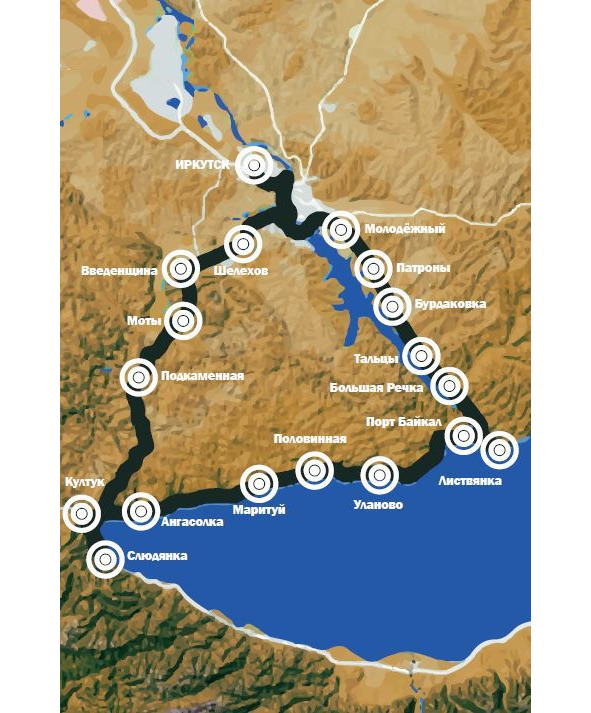
Introduction
The book is dedicated to the most complex steel line in Russia — the Circum-Baikal Railway (CBRR), which was built on the steep shore of Lake Baikal at the beginning of the 20th century by the best engineers of their era. It was there that I began my professional journey as a tour guide. Today this is the most intense excursion in the Irkutsk region in terms of the number of topics that it covers.
On the pages of this work, I would like to share my knowledge accumulated about these places. I will try to describe the history of the sights that we meet on our way as interestingly and briefly as possible. In addition to the main route of the Circum-Baikal Railway, attention is paid to remote areas of the city of Irkutsk, which for various reasons were not included in my first book, as well as to the favorite tourist centers of the Baikal region — Listvyanka and Slyudyanka.
The book reflects not only the main historical plots of the display objects, but also relevant information on archeology, botany, geology, geography, demography and logistics. The book is intended both for guests of the Irkutsk region who are interested in its history and nature, as well as for practicing specialists in the field of local history and excursion studies.
Focusing on the footnotes in the margins, you can easily move around both urban areas and along the railroad. I hope, thanks to these lines, you will love Irkutsk and Baikal the way I love them. I wish you pleasant reading and travel through the pages of the history of the Baikal.
Novo-Lenino Microdistrict
Frankly, I thought for a long time how and where to start our journey along the old Circum-Baikal Railroad (hereinafter CBR). I would like to go as accurately as possible along the old route of the Trans-Siberian Railway, as it used to pass through Irkutsk, in order to fully reflect all its features and details. Therefore, we will start our journey from the old Innokentyevskaya station (nowdays Irkutsk-Sortirovochny, Vokzalnaya st., 9A) in Novo-Lenino microdistrict of the city of Irkutsk, from where the CBR is historically counted.
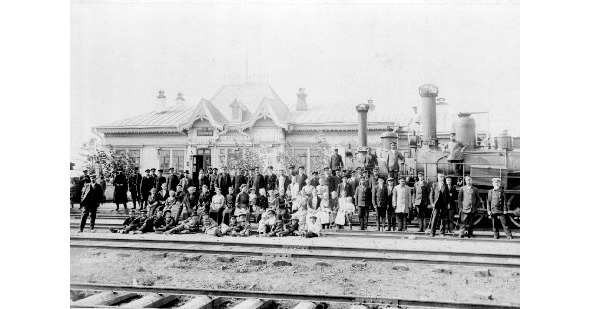
The first rails came here back in 1896 and helped to appear on this site a new working settlement on the lands of Irkutsk Ascension Monastery, the very one that is inextricably linked with the name of the first Irkutsk Saint — Innocent Kulchitsky. This is how the name of this initial station of the Circum-Baikal Railway came from. On July 27, 1898, the first train was met here in Irkutsk. Only three weeks later it will reach the main passenger station of the city.
The population of the village grew very quickly, and in five years more than a thousand people lived here. At the same time, people who were completely unrelated to the railway moved here. For example, in 1905, some of the soldiers who returned from the Russian-Japanese war settled here in dugouts, who immediately entitled the northern part of this settlement «Port Arthur» in memory of the fortress lost in the Far East. The city government fought against unauthorized constructioning for a long time, but in the end it simply renamed the area into Novo-Innokentievskaya Sloboda.
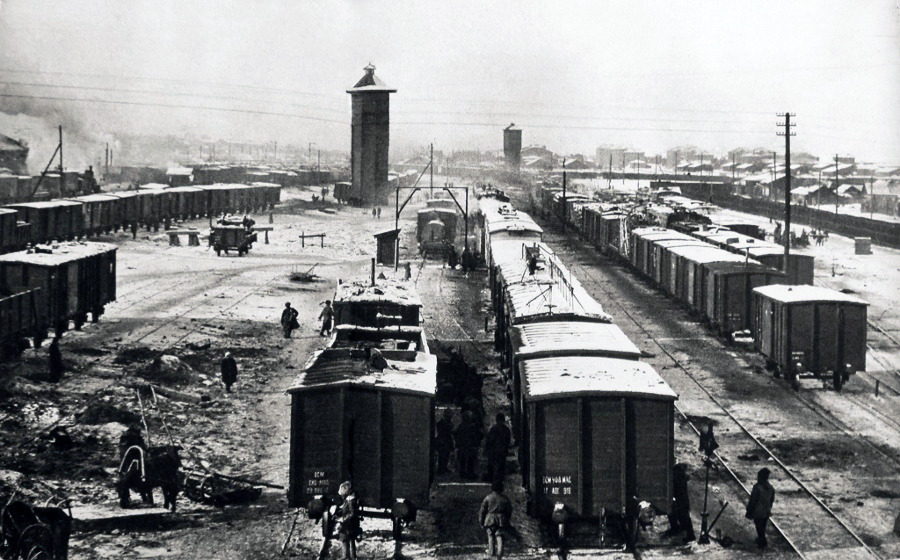
During the Russian Revolution, from Decem-ber 14, 1917 to July 9, 1918, the Soviet of Workers’ and Soldiers’ Deputies was based at the station, until it was driven out by a detachment of Czech legionnaires. On February 14, 1920, this place became the scene of bloody battles with the units of the White General V.O. Kappel, retreating from Irkutsk to Baikal. Just a few months later, in April 1920, the district received its new name — Novo-Lenino.
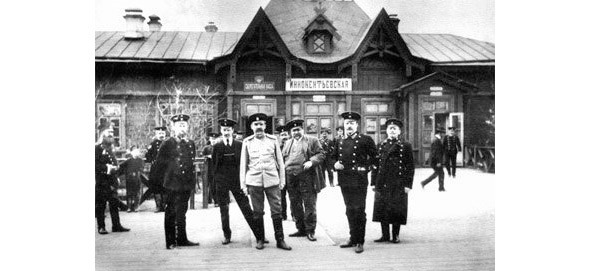
On March 28, 1932, the construction of the largest aviation plant in Eastern Siberia began, opposite the railway lines, which launched the production of several dozen aircraft from almost all the russian leading design bureaus. During the World War II (hereinafter WWII), it handed over 2174 combat aircraft to the front. After the Great Victory, already in 1951, it gave the country the world’s first torpedo bombers Tu-14 with three turbojet engines. And in 1973, it was the first to start assembling the MiG-27 supersonic fighter-bomber, the first carrier of a new generation of high-precision weapons in the USSR. It was the only plant in the country where the design bureau of A.I. Mikoyan did not create a branch at the plant contrary to established practice. Today, in the best traditions of the past, the plant assembles the Yak-130, SU-30SM, as well as the long-awaited family of medium-range aircraft MS-21.
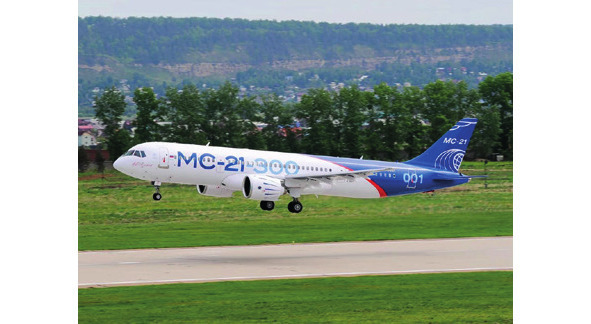
In the area of the modern station, today there is a museum of the locomotive depot, which occupies a building from the tsarist era (Obraztsova St., 30). Near the station there is a memorial in memory of those who died in the WWII and an exposition of railway equipment. In the post-war years, Hero of the Soviet Union D.V. Zhilkin worked here as the head of the technical office. Nearby you can see the locomotive-monument L-3228, similar to those that today drive tourist trains along the СBR. There is also a track measuring trolley, an isolating removable tower, a universal sleeper changer machine MSHU-5, a single-winged semaphore and a hydrocolumn. Opposite, by the railroad tracks, a few years ago you could find an old water tower and a water-lifting building, but in 2010 they were dismantled.
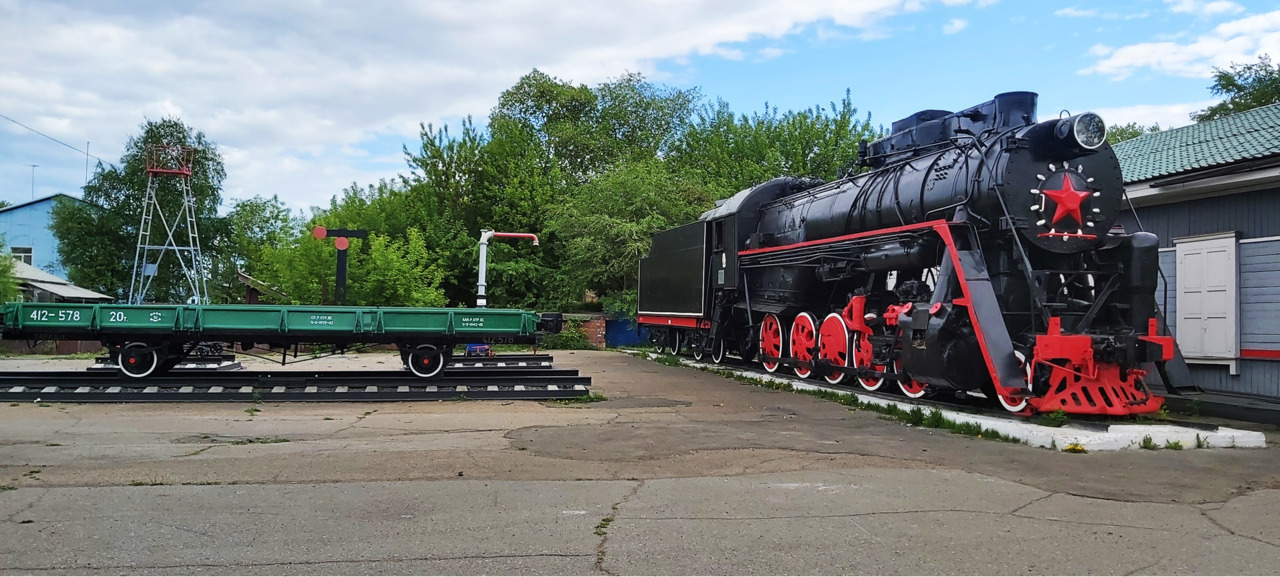
On the other side of the road is Molodezhnaya Grove, which hides the buildings of an old medical town that appeared here in 1908. Among them, the building of the railway hospital (Obraztsova St., 27 K1), made according to the project of I.P. Mikhailovsky back in 1904. Today in this park you can find many sculptures, a sports ground for volleyball and tennis, and three children’s play areas. Here you can also see the monument to the engineer and revolutionary E.K. Špaček, recently moved here from the locomotive depot, who gave his life for the power of the Soviets. Being a Czech by nationality, he was hanged by his fellow tribesmen on a lonely pine tree on July 19, 1918, with a large gathering of people at the place where the Lokomotiv stadium is now.
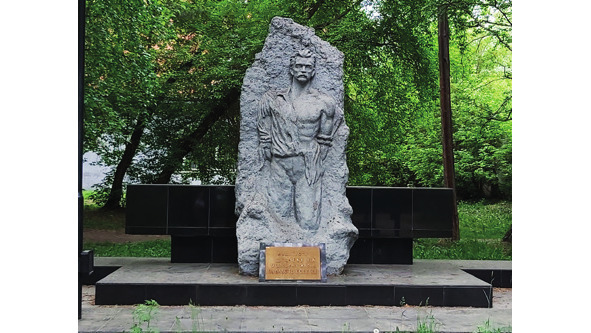
Among the dense vegetation from Rosa Luxembourg Street (Akademika Obraztsova Street, 27A) hides one of the most forgotten temples of Irkutsk — the chapel in the name of Panteleimon the Healer. It was built in 1906 and was originally intended for the funeral of the dead in the medical town. After the revolution, it was converted into a city morgue, as which it existed until 1980, when a tuberculosis laboratory was placed here. Today it is one of the most dynamically developing spiritual centers of Irkutsk. Since 2010, it is planned to build a full-fledged church.
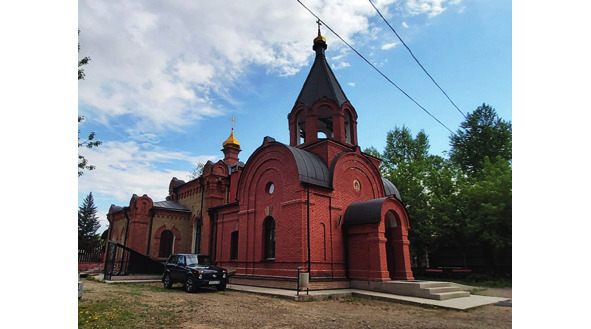
In addition to the hospital and the church, a one-class school was opened in this grove back in 1900 at the expense of the Ministry of Railways. In 1935, it became school number 38 in Irkutsk, and half a century later it received a modern building and a new number (Obraztsova St., 23). Here in the 1940s worked as the teacher of the Russian language the creator of the novel «Far in the country of Irkutsk» A.V. Zverev.
If you walk along Vokzalnaya Street, you can still see many residential buildings built according to standard designs of the Ministry of Railways at the beginning of the 20th century. In one of them, in 1898, the future writer, naval officer and member of the Presidium of the Supreme Soviet of the USSR L.S. Sobolev was born into the family of a retired officer of the Russian army. In 1906, among these houses, a wooden church of St. Innocent of Irkutsk appeared, which was converted from a fire station building according to the project of P. Alkanov. It was planned to build a more solid temple, but the revolution interfered with the plans, and in 1934 it was closed. Its location and forms are reminiscent of a house in the style of the MPS (Vokzalnaya St., 9A).
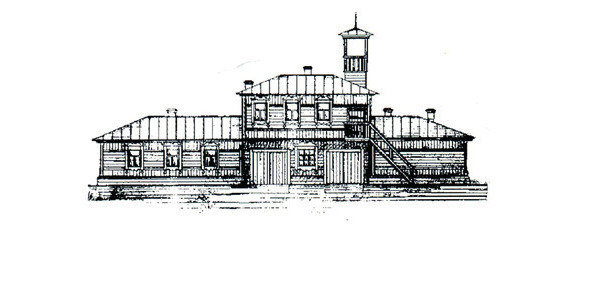
Well, we will continue to move along the street named after the twice winner of the Stalin Prize in the field of transport, Academician V.N. Obraztsov. At its beginning, in the Sarafanovka terrain, another amazing church lurked. This is the oldest wooden temple preserved in Irkutsk — the St. Michael the Archangel Zhilkino’s Skete (Obraztsova St., 1), built in 1874 at the place where the first Bishop of Irkutsk, St. Innocent, liked to stop on his way to Malaya Elan. Two springs are also named in his honor, which formed a small lake with time here. In addition, this temple was one of the first after the revolution to open its doors to parishioners. Already in June 1945, services began to be held here, and since 1987, the oldest parish school in the city in the name of Saint Sophrony of Irkutsk with an extensive library has been operating at the church.
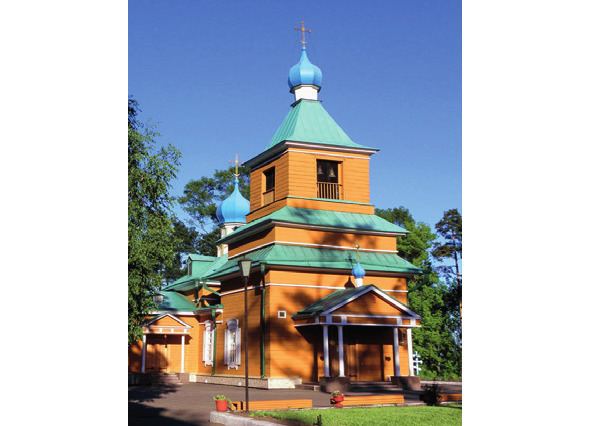
On the other side of the lake, the remains of an ancient cemetery at the St. Innocent Skete are visible. It was closed in 1937, but about a dozen tombstones and fences have survived today. According to one of the urban legends, it was here in the spring of 1920 that the body of the Supreme Ruler of Russia A.V. Kolchak was secretly buried. However, Ust-Kuda, Meget and even the Monastery of Icon of Our Lady of the Sign are named among the possible places of burial, and it is virtually impossible to verify the authenticity of these versions.
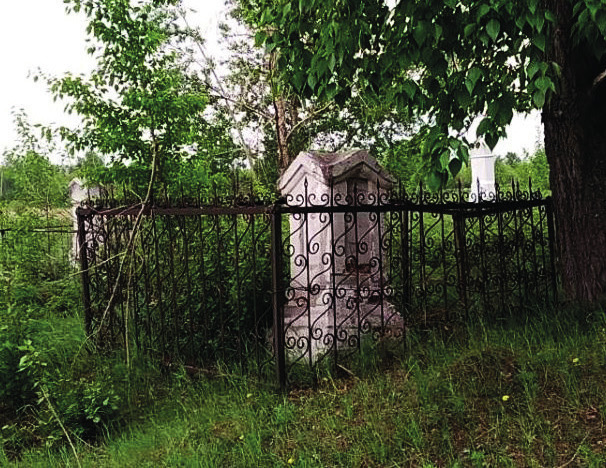
Not far from the cemetery, behind Rosa Luxemburg Street, on the Novo-Innokentievsky outskirt, there is a garden of the Latvian breeder A.K. Thomson (St. Thomson, 3), which since 1914 began to supply the whole of Irkutsk with rich harvests of ranet. Thanks to this talented botanist, 230 varieties of apple trees, 77 species of fruit and berry plants, 47 spe-cies of ornamental trees (in particular, elm, oak, maple, linden and hazel, rare for Siberia) grew here by the 1930s. Today, there are more than 150 species of relic plants on the territory of the garden, and since 1996 Sovetsky Lane has been named after Thomson.
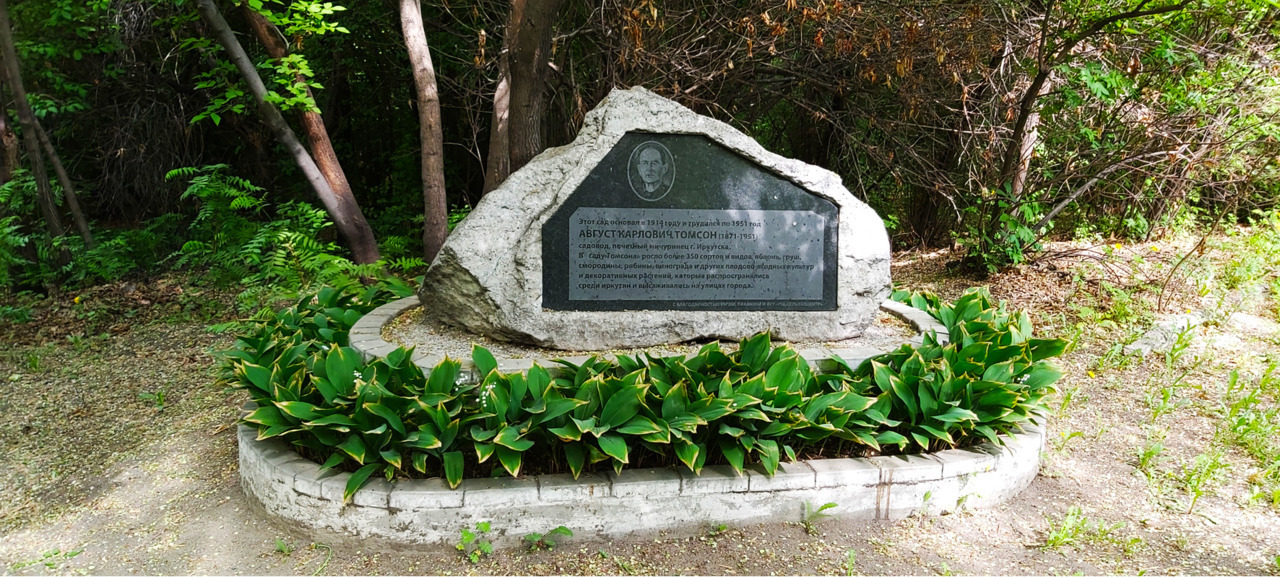
Right behind its green spaces rise the walls of the Irkutsk ceramic factory, which since 1929 has been the main supplier of bricks in Irkutsk. It is interesting that the first such enterprise appeared here back in 1872. Along the Trans-Siberian Railway stretch Novoleninsky swamps, which since 2010 have been included in the special nature protected area called «Bird’s Harbor». And this is not surprising, since more than 200 species of birds nest on this lake and swamp complex, right in the center of the city, besides factories and the railway. Among them there are also the Red Book black stork, gyrfalcon, peregrine falcon, saker falcon and steppe eagle.
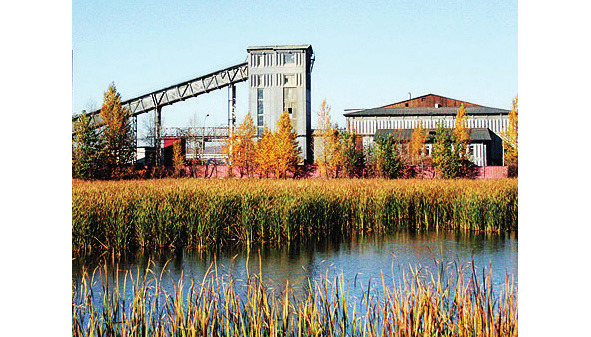
Irkutsk II Microdistrict
Next, we will go along the Novo-Lenino bypass road to the junction, near which the plant of reinforced concrete structures of the East Siberian Railroad (hereinafter ESR) has been operating since the 1980s. Here we turn left at the junction under the bridge, towards the Irkutsk II district by the Leninsky Trakt, which appeared as a permanent connection with the city center only in 1935.
Having passed the street food market «Parus», as well as the «Bazar» and «Priboy» shopping centers (Traktovaya St., 35), we will see on the right hand behind the fence the far drive beacon of the «Irkutsk II» military airport. Behind it, we have to overcome three railway crossings, leading in in the following sequence: the first — to the Irkutsk mill, meat processing plant and woodworking enterprises; the second — to the branch of the Buryat meat processing company, the warehouses of the Federal Reserve Agency and the Irkutsk vegetable warehouse; and the third — to the blanking and stamping production of the Irkutsk aircraft factory. The latter produces up to 70% of the details of future aircraft in three workshops. The personnel of the plant have been forged here since 1934 in the technical school of aircraft construction and metalworking (Mira str., 14). It was here in 1939–1940 was studied the future Hero of the Soviet Union A.D. Evstigneev.
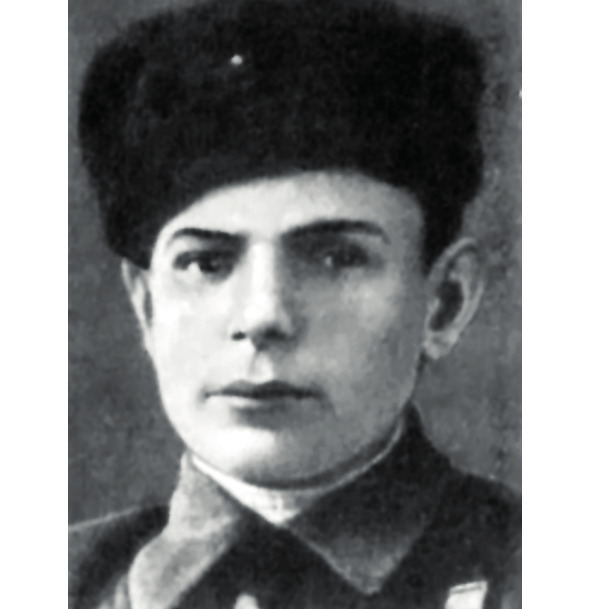
From Mira Street (former Monastyrskaya) we will turn right onto Maria Ulyanova Street (previously known as Detskoy Radosty and Krestovsky Lane), walking round the territory of the blanking and stamping plant, we will drive to the Siberian Partizans Street (formerly 9th or Tverskaya). The latter is named in memory of the liberation of Irkutsk from the admiral Kolchak squads in February 1920. Once it was the very outskirts of the Innokentievskaya settlement, but since the 1930s, it has become the arterial road of this area.
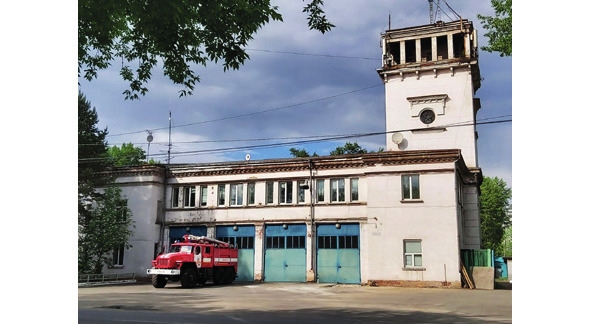
The first thing that attracts attention is the beautiful building with a tower standing to the right of the road (Sibirskih Partizan Str., 2) — this is a fire station built in 1936 according to the project of architect B.M. Kerbel. Opposite it is the M. Gorky Park, which in 2018 was renamed to the Peace Square. It is symbolic that at the very end of this territory there is a monument «Woman with a Child» — in memory of a brave lady out of this district, who saved a baby from a fire in 1935. Now the sculpture has been restored, and in 2000 the participants of the Great Patriotic War planted the «Veterans’ Alley» here. And this is not accidental, since a street passes along the park, named in memory of the Hero of the Soviet Union V.F. Zhukov, who worked in the lumber industry of Irkutsk and died in 1944 during the liberation of Sevastopol. His portrait can be seen in the form of a monumental panel (artist Y.N. Kvasova) on one of the houses (Mira Str., 62).
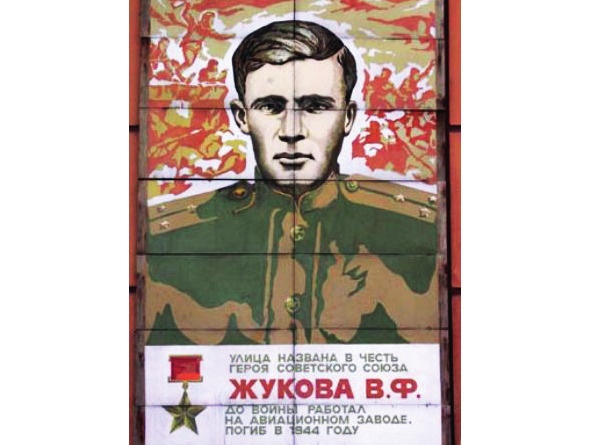
Right behind the crossroads rise the walls of the oldest residential building on Siberian Partizans Street, built back in 1939 by architect V.N. Volkov (Sibirskih Partizan Str, 4). From the moment the house was commissioned and until his death in 1997, the Hero of Socialist Labor and an honorary citizen of the city, the milling operator of the aircraft factory M.D. Parkhomenko lived here. On the other side of the street, behind a typical building, there is a brick house No. 3A, in which from 1963 to 1996 lived the writer and artist V.P. Starodumov.
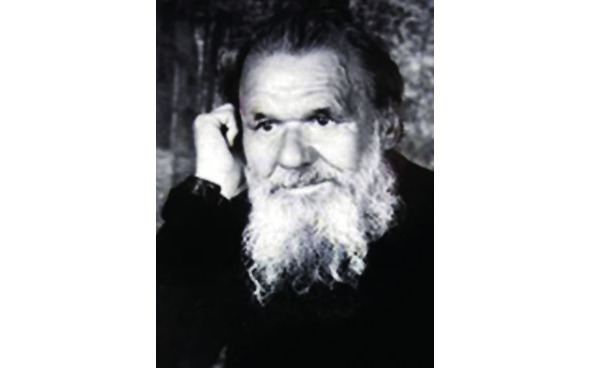
We continue our way to Muravyov Street, formerly known as Upravskaya Lane, named after the village administration located here. Once this street led straight to the Innokentievskaya station, from where the formation of this area began. At the intersection on the right side there are two residential buildings (Sibirskih Partizan Str., 16 and 18), in which the documentary film director B.P. Rakin and poetess N.K. Sidorova were lived.
In the common courtyard of these buildings until 1955 there was an old Tatar cemetery. From the side of the quarter, bounded by the streets of Prosveshcheniya (previously Bazarny Lane), Aviastroiteley (Zhdanova), Zhukova and Sibirskih Partizan, the Innokentievsky graveyard adjoined it. Today, on the place of these necropolis, there are many social facilities, such as the maternity hospital and the medical department of the Irkutsk aircraft plant, school No. 12 and kindergarten No. 34. During their construction, many remains were found and burned right there on the spot in 1950’s.
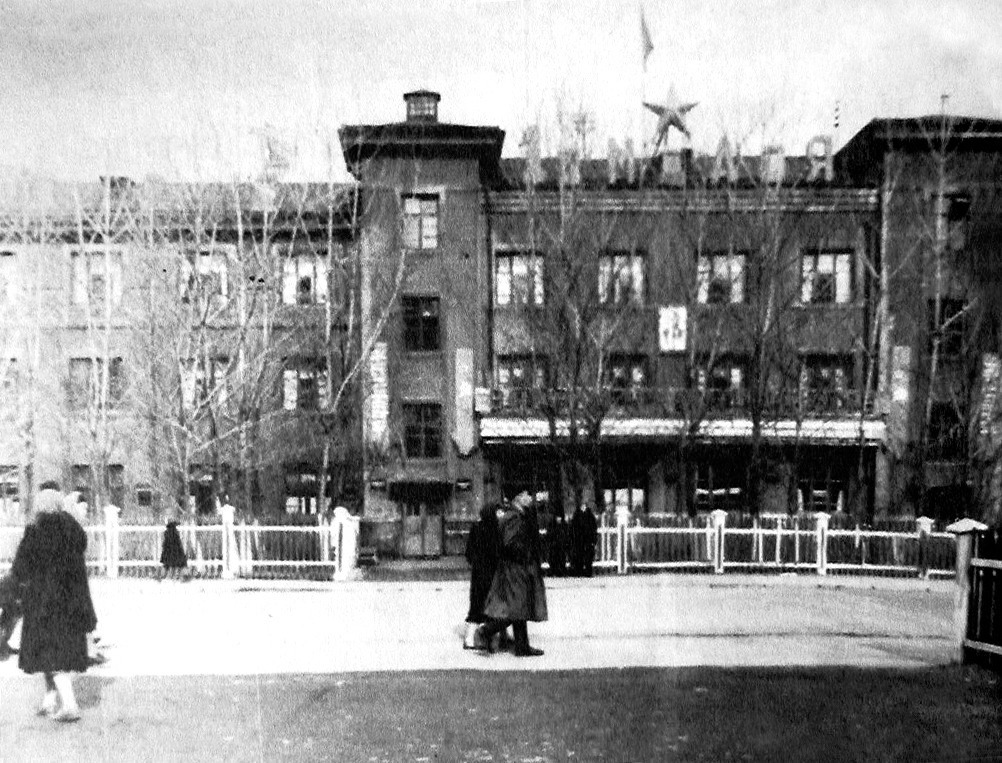
In the meantime, we will turn right onto Muravyov Street. Here we see an area of two-story cozy houses that were built in the early 1950s for the factory elite. In one of these (Ukrainskaya Str., 13) in 1958–1963. lived one of the most famous Heroes of the Soviet Union in Irkutsk — ace pilot I.V. Kuznetsov. He made more than 350 sorties, personally shot down 9 aircraft and twice made an aerial ramming. Despite this, he was awarded the Star of the Hero only in 1991, shortly before his death.
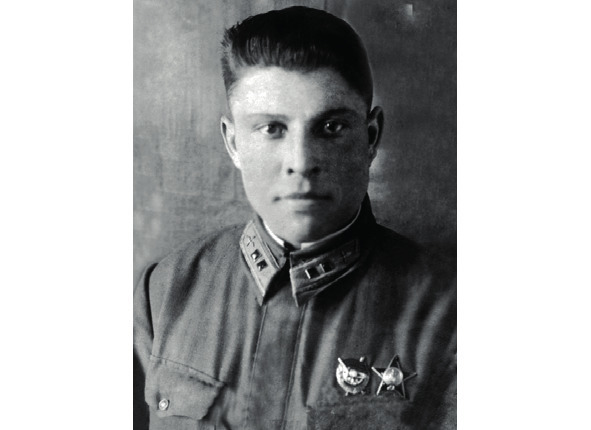
The street ends at the Irkut-Zenit stadium, built in August 1945, where the factory football club of the same name existed until April 2021. Apropos this site was once called among the contenders for the world bandy championship. We will turn left twice and drive along the territory of the Komsomolskiy park, which appeared thanks to the youth of the aircraft factory, who built a wonderful place to relax with their own hands during labor Sundays in 1948 on the site of a swampy and unsuitable for construction area.
In 2010, for unknown reasons, the Tu-124 aircraft and the Mi-4 helicopter exhibited here in 1984 were removed from southern part of park. In their place in 2016, the children’s town «Chipollino» was transferred from the center of Irkutsk and then almost immediately closed. Today, the fate of the only well-equipped park in this part of the city is being decided.
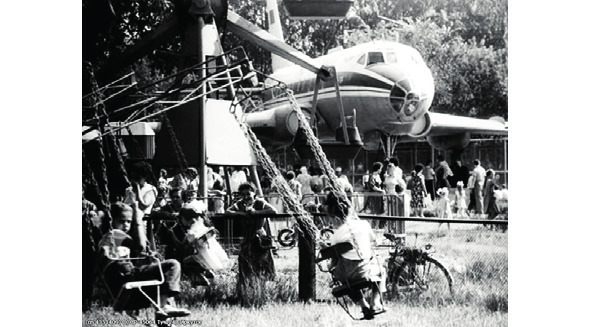
Moving further along Pulkovsky Lane (formerly Popovsky), we turn right and again find ourselves on the street of Sibirskih Partizan. On the right, the walls of the building rise, where since 1958 the oldest in the district library No. 5 (Sibirskikh Partizan St., 22) has been located, in which the Museum of History and Culture of the Leninsky District operates. Writers V.M. Rudykh, V.V. Ginkulov, L.I. Sukharevskaya, D.M. Tsvetkov, S.V. Korbut and many others assisted in gathering the collection and information.
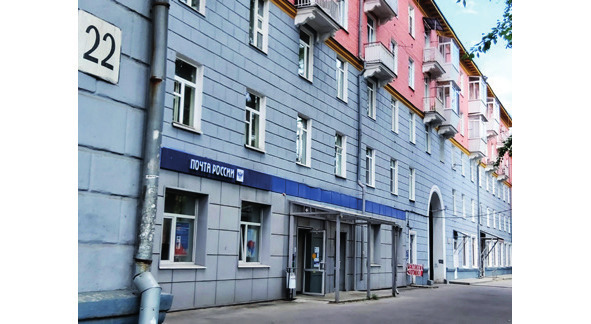
On the other side of the road there is the first aircraft factory secondary educational institution — school No. 37 (Sibirskih Partizan Str., 19). It accepted first students back in 1932, but than moved to this building after WWII. On a Saturday afternoon, December 6, 1997, the worst plane crash in the history of Irkutsk took place right behind the school.
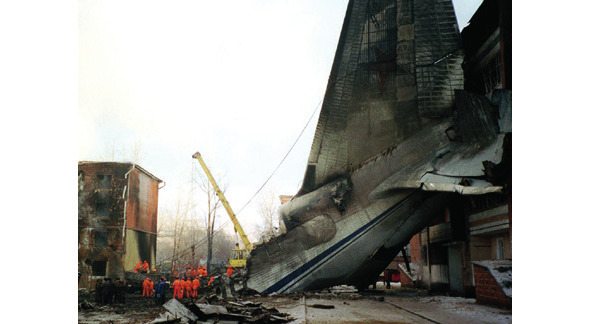
At 14:42, during takeoff from the airfield of the aircraft plant, due to the failure of three engines, the An-124-100 «Ruslan» aircraft crashed onto residential building No. 45 along Grazhdanskaya Street, hitting with a wing the building of orphanage No. 1 and leaning with its tail against house No. 120. 8 crew members and 15 passengers died on board, as well as 49 people on the ground, including 14 children. More than 70 families were left homeless.
In 1999, a church in the name of the Nativity of Christ appeared on the site of the destroyed house. Installed a memorial with 72 chrome candlesticks, according to the number of victims. An orphanage was also restored and a part of the house along Mira Street, where the tail of the plane hit, was repaired.
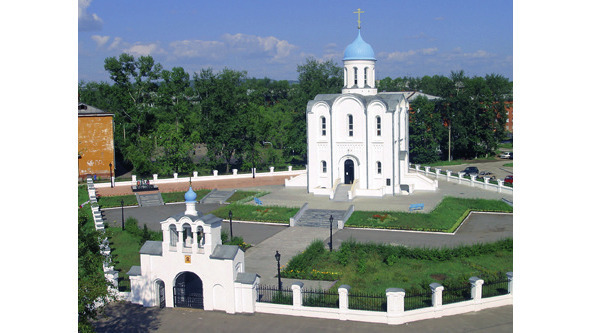
Having paid tribute to the memory of those who died in a terrible plane crash, we will continue our journey along the street of the Sibirskikh Partizan, where in the house No. 30 in 1969–1979 lived O.I. Lapa — the first Hero of Socialist Labor of the Irkutsk Aviation Plant.
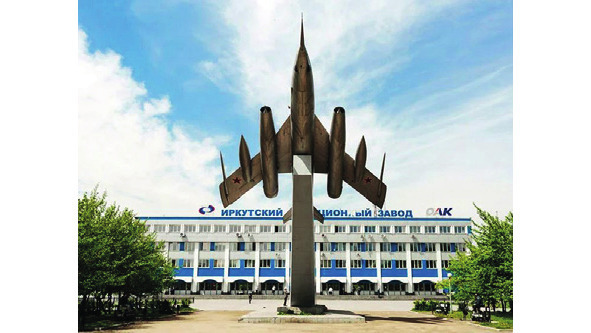
The street ends at the entrance of the Irkutsk Aviation Plant, where the first large-scale supersonic bomber in the USSR Yak-28 majestically soared into the sky — the same aircraft that brought the company to the ranks of the industry leaders and brought it well-deserved fame. In front of the machine, in the same square, there is a memorial made in 1968 with 338 names of aircraft factory workers who did not return from the front of WWII.
Among the famous workers of the enterprise there are four Heroes of the Soviet Union. From February to June 1942, before being sent to the front, here worked among the detachment of «naval twenty-five thousandths» M.N. Tsukanova — the only woman who received this high rank during the Soviet-Japanese war. And in 1934–1936 already familiar to us V.F. Zhukov worked on the construction of the plant. In 1936–1939 infantry captain N.K. Romanenkov worked here as a gas welder, who distinguished himself in battles in Poland, but was killed near Berlin. The famous ace pilot I.V. Kuznetsov also gave many years of his life to the enterprise, being worked here in 1934–1938, 1946–1951 and 1954–1963, but later moved with his family to Yeysk, and after to Gelendzhik, where he is buried.
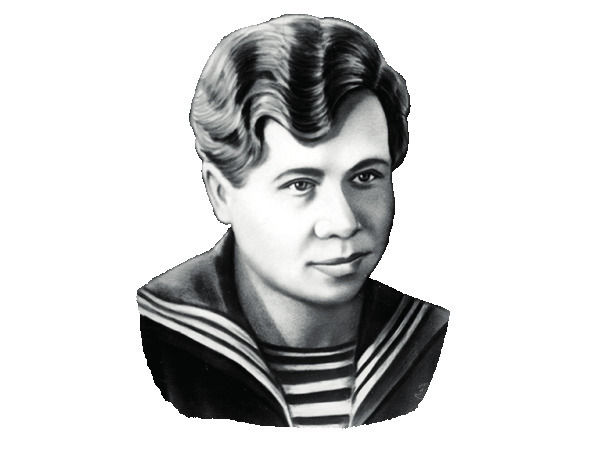
Let’s turn right onto Makarenko street. The first house on the right side is special (Sibirskih Partizan St., 32), and not only because here lived Hero of Socialist Labor aircraft factory mechanic A.I. Temnikov in 1985–2008. On the evening of June 20, 1976, one of the most famous Russian bards in the 20th century V.S. Vysotsky gave an impromptu concert from the balcony of this house, performing seven songs for passers-by. The next day he left Irkutsk and never returned. The purpose of his visit was to work on the book «Black Candle», which he wrote in collaboration with the Irkutsk writer L.V. Monchinsky, to whom the bard came to visit. During the week they visited Listvyanka, Bodaibo, Homolkho, Aprelsk, Nizhneudinsk, Zima, Moty and Chistye Klyuchi.
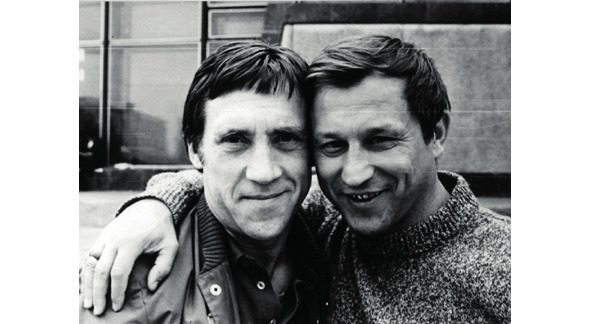
Behind the house hiding the building of school-evacuation hospital No. 34, which since 2012 bears the name of M.N. Tsu-kanova. Here in 1952–1955. studied the future Vice-Admiral of the Black Sea Fleet V.N. Sergeev which is one of thirteen people awarded the Order «For Service to the Motherland in the USSR Armed Forces» I degree — the rarest award of the USSR. Next to the school is one of the most beautiful buildings in Irkutsk II — the Palace of Culture named after Y.A. Gagarin (Makarenko Str, 6), created in 1936 according to the project of the civil engineer of the Irkutsk aircraft plant N.A. Chetverikov. Under his direct leadership, all the main modern buildings of the enterprise were built.
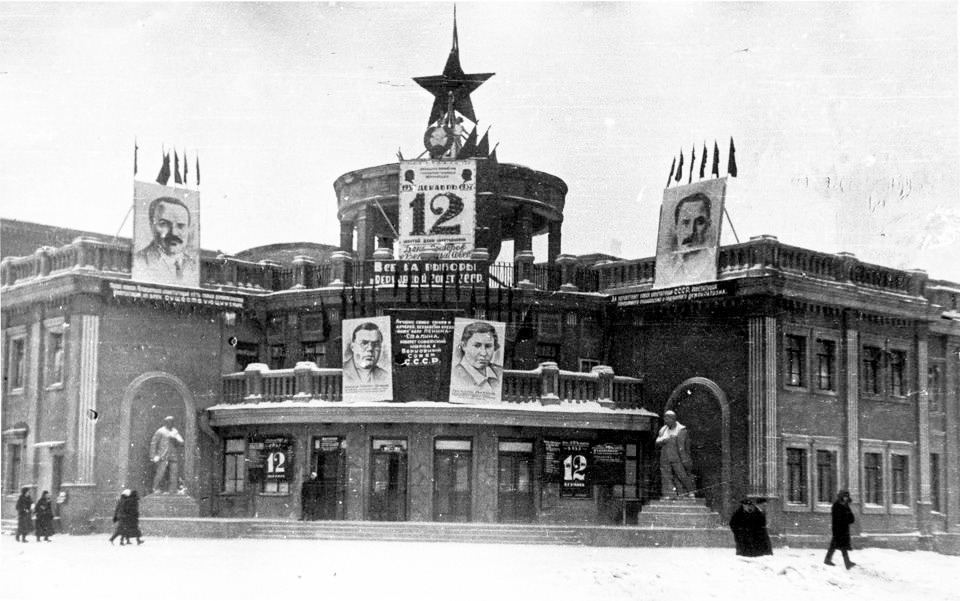
At the bus stop «Banya» we turn left onto Aviastroiteley Street. Before us is one of the oldest districts in this part of the city, it was built up in the late 1930s. In Soviet times, there really was the main bathhouse in the area (Aviastroiteley Str., 24), built according to the project of B.M. Kerbel in 1935. The poet and laureate of many state prizes V.D. Fedorov lived in house No. 28. He worked in 1938—1940 as foreman at an aircraft factory. Further down the street is the building of school No. 43, which today bears the name of the youngest marshal in the history of the USSR — A.E. Golovanov, who worked in Irkutsk in 1935–1937. Exactly in his era this educational institution appeared.
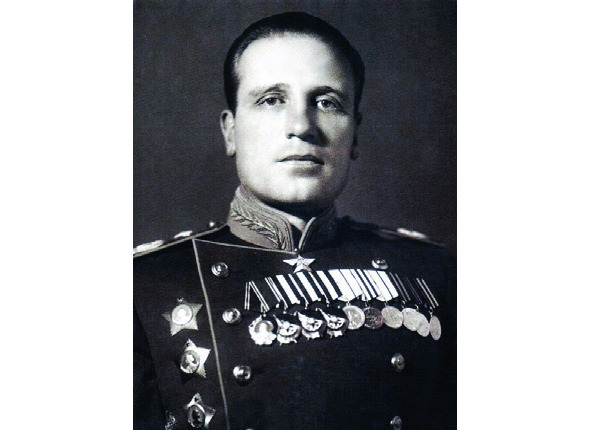
Zhilkino Microdistrict
This concludes our acquaintance with the Irkutsk II area and turn right onto Novatorov Street towards the village of Bokovo. This passage appeared in 1896, when a water pipe was laid here from the Angara river to the Innokentievskaya station. Here, near the border of the aircraft factory, at the Bokovsky cemetery, according to legend, in the spring of 1920, was buried admiral A.V. Kolchak. The graveyard was finally destroyed in 1937 during the construction of the aviation service of the enterprise.
The village itself appeared in 1710, when Savva Bokov, a contributor to the Ascension Monastery, built his house here. On June 13, 1925, the first airport in the history of Irkutsk appeared adjacently to the village, that was just a flat area 600 m long. Already on June 24 of the same year, six aircraft landed here, performing the first great flight of Soviet aviation on the route Moscow–Ulaanbaatar–Beijing –Tokyo. Among the pilots was the future aviation general and Hero of the Soviet Union M.M. Gromov. However, in July 1933, the take-off site was moved to another part of the city, and the village did not receive further development.
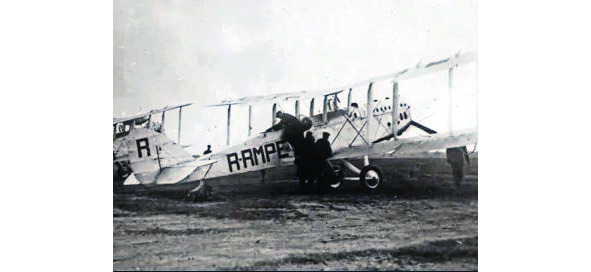
Getting to the end of Novatorov Street, we turn right onto Polyarnaya Street, which is the remains of the old Moscow tract. Despite the fact that the decree on the construction of this longest land road in the world in 17th century (5672 km) was issued back in 1689, it reached Irkutsk only in 1749. Before that, as noted by the first historiographer of Eastern Siberia A.I. Losev: «...the usual way was by water along the Angara on ships in the summer time, and in the winter they traveled along the Angara in a sleigh.» By the way, in Bokovo, starting from the end of the 19th century, a ferry operated to the other side of the river. Its remnants can still be seen near the modern autocross track, as well as the old balsam poplar alley along the Moscow Tract.
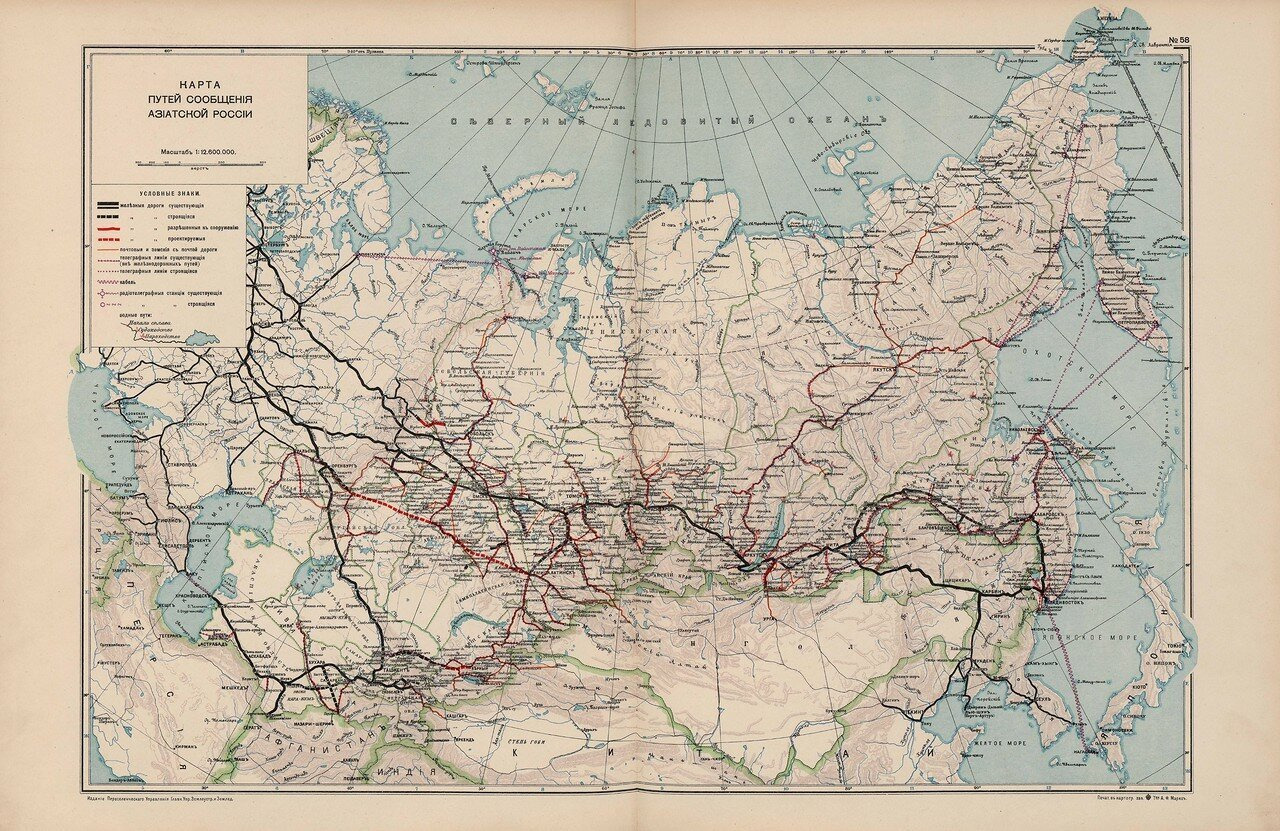
The first people settled in this part of the Angara since the founding of Irkutsk, and in 1669, after the creation of a small church hermitage on the lands of the peasant Zhilkin, its modern name Zhilkino was assigned to the area. Having passed the oil depot, we are moving along Polyarnaya Street to the Irkutsk Meat Processing Plant, opened in 1937 (Polyarnaya Str., 97). A little further, behind the automobile ring, there is a mill-elevator of the Irkutsk bakery (Polyarnaya Str., 77). Since 2018, both of these enterprises no longer operate. Once they caused the disappearance of the oldest monastery in Irkutsk in the name of the Ascension of the Lord, founded by the Righteous Elder Gerasim back in 1672. The oldest school in Eastern Siberia has not survived either, founded in 1725 by Archimandrite Anthony (Platkovsky). It burned down in 1876, and in its place in 1936 an ordinary wooden house appeared (nowdays Polyarnaya Str., 74).
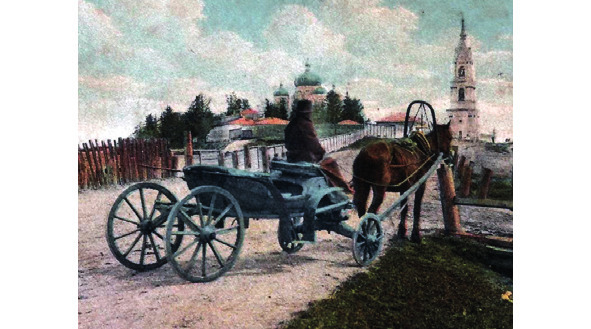
Unfortunately, there is also almost nothing left of the largest monastery in Irkutsk. Of the actual church buildings, only the Assumption Church (Polyarnaya Str., 98) has survived, consecrated in 1783 personally by the Venerable Sinesius of Irkutsk. Once upon a time it was a rare example of a temple built into the monastery inclosure not above the gates, but as a continuation of the walls. In addition, with a two-altar composition, which is unique for the stone architecture of Eastern Siberia. It is also interesting that in 1863–1872, during the construction of the new Ascension Cathedral, the relics of the first Irkutsk bishop rested in the Assumption Church. Moreover, in 1836, on the north side of the entrance, a chapel with a holy spring was added, which, according to legend, was extracted by Saint Innocent himself. Unfortunately, in Soviet times, a toilet was placed on its place, and there was no chance of recreating it.
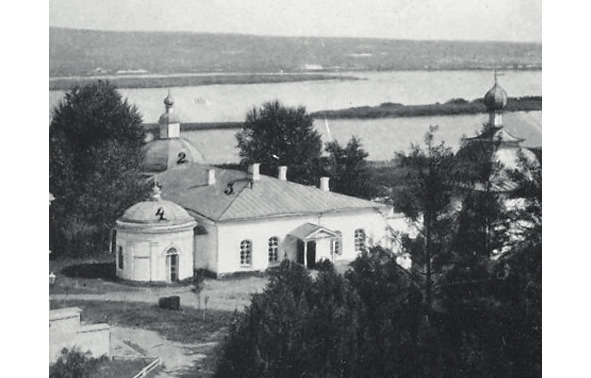
Let’s try to recreate mentally the image of the monastery, moving clockwise and taking the only preserved temple as a reference point. In the direction of Polyarnaya Street (the former Moscow Trakt), exactly opposite the Assumption Church, once rose the walls of the oldest wooden church in Irkutsk. It was consecrated back in 1692 in the name of the Tikhvin Icon of the Mother of God. In 1731 Innocent Kulchitsky was buried in its underground. It became the only surviving building after the devastating fire of 1783. Unfortunately, it could not survive the fire of the Soviet era, and in March 1932 it was destroyed to clear the territory for the future Irkutsk meat processing plant, as well as most of the monastery buildings. Today, in its place have been created a cruciform square with holy gates, a memorial sign and a belfry have been installed.
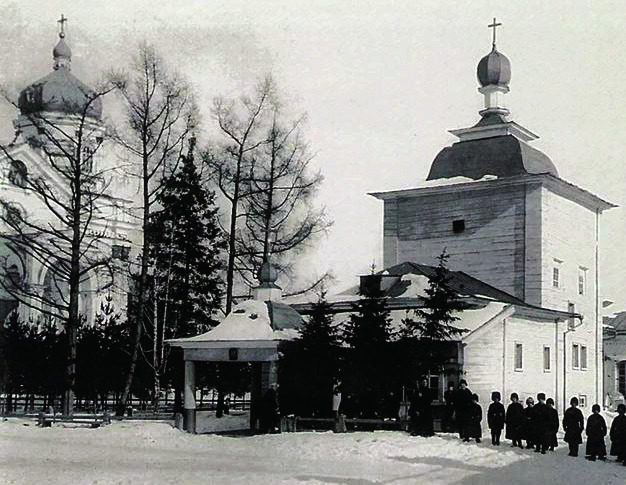
Further to Polyarnaya Street there are two fraternal buildings (Polyarnaya Str., 78 and 80), built in 1898 and 1836, respectively. Both of them were located within the monastery walls, and between them since 1881 there was a bell tower built according to the project of the best Irkutsk architect Baron G.V. Rosen and at the expense of the famous merchant-philanthropist I.I. Bazanov, who was later buried on the territory of the monastery. On the side of the Moscow tract, a hotel for pilgrims has been preserved (Polyarnaya Str., 83), above the entrance of which you can still see the date of construction — 1903. By the way, the first hostelry appeared here back in 1866 thanks to the merchant P.O. Katyshevtsev, a distant descendant of whom is the author of this book. It became the third such place in Irkutsk.
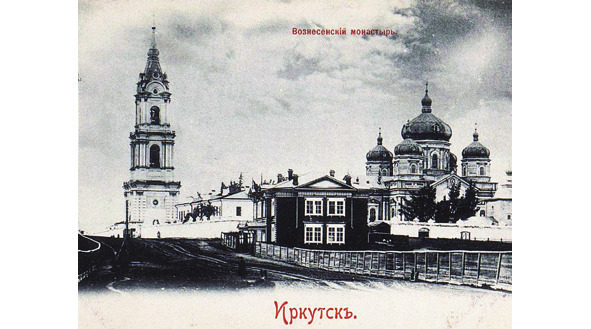
But the main temple of the monastery — the Ascension Cathedral, to which the central alley led from the bell tower, has not survived to this day. Not without reason the place for its construction back in 1738, the second bishop of Irkutsk — Innocent (Nerunovich) — considered unlucky. Initially, the cathedral was projected in the Siberian baroque style in 1767, but a century later, due to dilapidation, it was dismantled, and in its place in 1872 a majestic temple was made in the Russian-Byzantine style by the architect V.A. Kudelsky. In memory of the church, in 2009, a chapel in the name of the Ascension of the Lord was installed at the location of the main aisle (Polyarnaya Str., 98A).
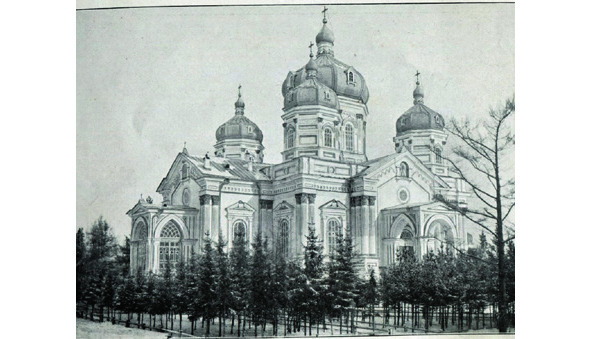
Next to the modern chapel, the building of the kitchen and sacristy built in 1907 (Polyarnaya St., 94) has been preserved, but the church in the name of the Smolensk Icon of the Mother of God, which stood right next to the cathedral, did not survive. It was consecrated back in 1795 and significantly rebuilt in 1841. In 1975 on the site of the temple a typical five-story residential building was built (Polyarnaya St., 80A), which put an end to the restoration of the entire monastery. During its construction, many remains were found, tippers of soil with bones were taken out, all this was droped into a swamp along General Dovator Street and sprinkled with broken glass.
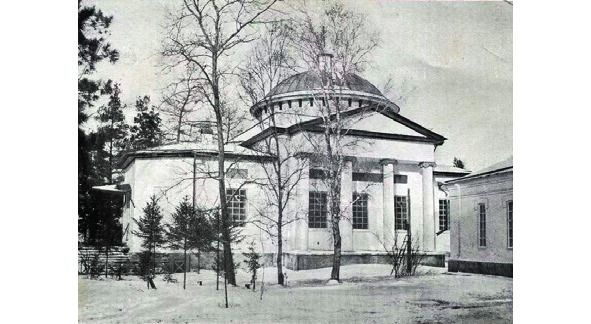
Directly from the fraternal building, the monastery wall led to the old prior’s cells built in 1804 with a liturgical storehouse. Since 1876, next to it stood a parish school with a fraternal kitchen (Polyarnaya Str., 88), which worked here until 1984 as elementary school No. 35. Nearby, preserved the stone and wooden building of services (Polarnaya Str., 86).
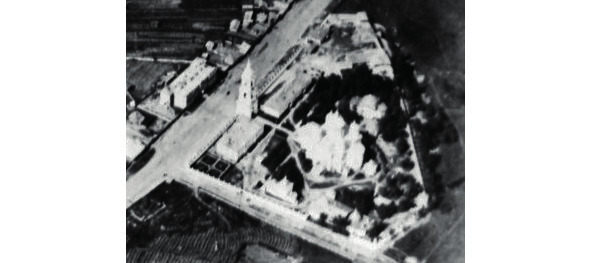
From here, the line of the monastery wall turned at a steep angle to the Angara, where at the modern railway line going to Irkutskdrevosnab (near the modern house at 46 Bereg Angary Street), it returned to the Assumption Church. In this part of the monastery there was a parish cemetery and a cave dug in the river bank.
The founder of the monastery, the Righteous Elder Gerasim, dug this hole for himself in 17th century, and Saint Innocent loved to pray here afterwards. During the arrangement of a new stone inclosure in 1802 were discovered the imperishable body of an old man, his coffin, staff and gravestone. In memory of this, a two-story chapel was erected right in the wall, where, in addition to the named shrines, there was a monastery archive.
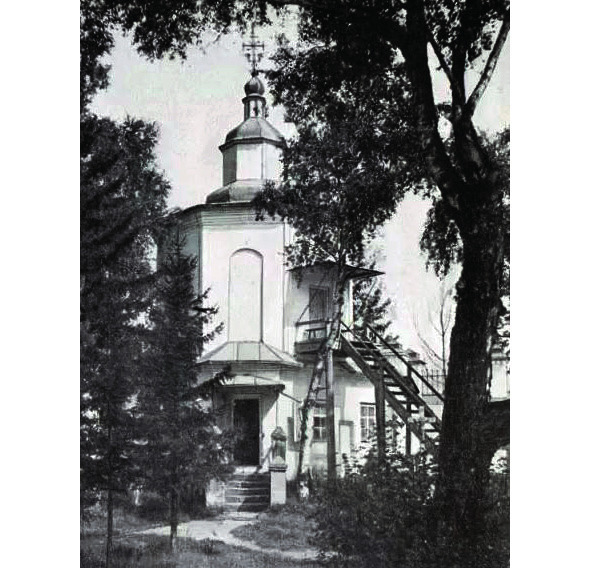
From this point, along the line to the apse of the Ascension Cathedral, there was another chapel, installed in 1865 at the resting place of the relics of the first archimandrite of the monastery — Venerable Sinesius (Ivanov). It should be noted that many famous Irkutsk residents of Trapeznikovs, Mylnikovs and Bazanovs families were buried at the parish cemetery. In 1939, a now abandoned kindergarten with a laundry room and a vegetable store was built in its place (Polyarnaya Str., 96).
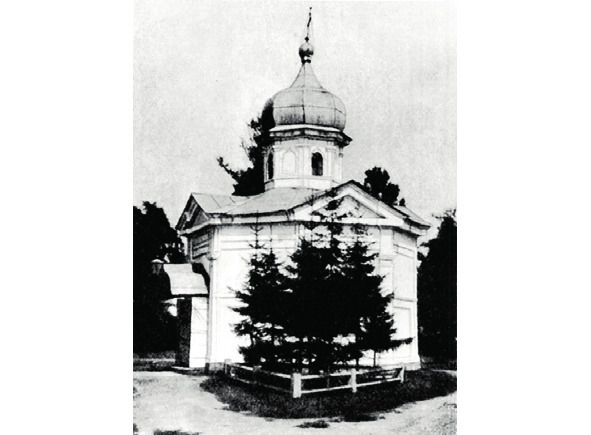
After getting acquainted with the former monastery territory, we reached the Innokentievsky bridge, built in 1978 and named after the first Irkutsk saint — Innocent Kulchitsky. The name is not accidental, because next to the bridge since December 8, 1731 and until January 11, 1921 were his relics.
From here we will move along the «Ryolka» (an elongated elevated dry place in a damp forest or swamp) further along Angara bank to the mouth of Irkut River. Initially, there were monastic mowings, along which the Moskovsky tract (now Polyarnaya Street) wound among the fields, going to the ferry on the island of Love (today Komsomolsky). From 1857 until 1891 this was the only way to get into the city. Taking into account the violent nature of the Angara, which liked to freeze on Christmas in severe frosts and open only in April, this created a lot of difficulties for travelers (since 1952, the river does not freeze within the city limits). On the ferry, queues up to a mile long were formed. The problem was finally solved only with the creation of reinforced concrete bridges across the Angara (1936) and Irkut (1961).
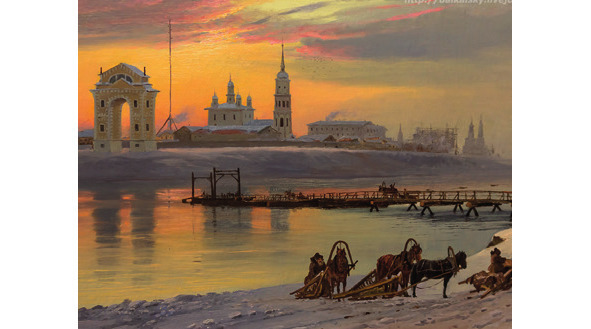
In this swampy area in the summer of 1905, 22 consolidated hospitals were laid for the treatment of sick and wounded lower ranks who arrived from the battlefields of the Russo-Japanese War. Soon, the military town that arose here began to acquire houses of railway workers, and in 1907, at the behest of the Governor-General I.P. Mollerius, a new suburb was created under the name «Voznesenskoye».
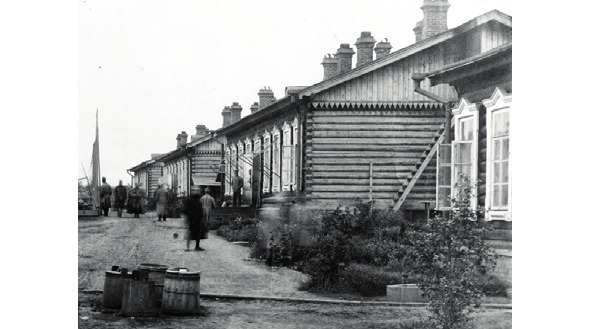
Soon, Zairkutniy military town was created on its base, which, starting from the autumn of 1914, became a refuge for hundreds of Austrian, Slovak, Italian and Hungarian prisoners of the First World War. Among the numerous buildings, only the 170th consolidated hospital (Traktovaya Str., 14Б), and the several barracks (Kamskaya Str., 8–14) remained, as well as reclamation canals, which were intended for the flow of surface and ground water. After the revolution, the village was named after G.V. Zinoviev, and in 1935 received its modern name — S.M. Kirov.
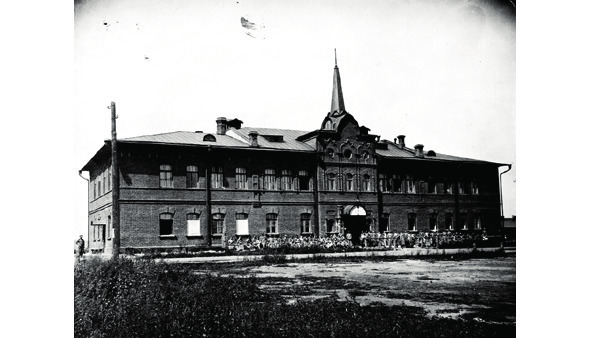
We are crossing the river along the Irkutny bridge. From it, on the right side, you can clearly see the railway bridge built in 1907, as well as the ruins of the pillars of the old wooden bridge, erected in tandem with the pontoon crossing in 1891. On the left hand, we see the watercourse of Irkut, dotted with the islands. In the middle of one of them stands a white cross. According to legend, it was here, a year after the founding of Yeniseisk, in 1620, the chieftan Berezovsky and the boyar’s son Petrushka Talshin founded the first Irkutsk winter hut. Subsequently, it was recreated in 1652 and 1656.
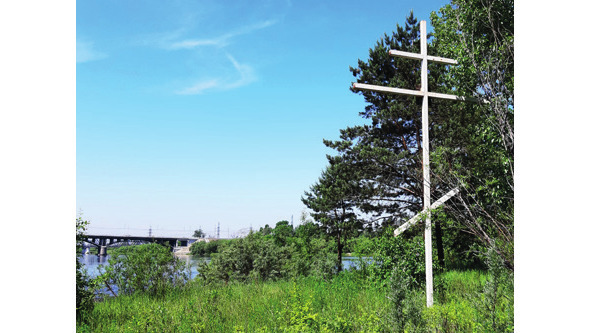
However, the constant floods of Irkut, coupled with the swamps of the river and the narrow of Kaya Mountain, forced the Cossacks to move the settlement to the right bank of Angara River. July 16, 1661 the boyar’s son Y.I. Pokhabov, at the request of the local Yandash prince Zayanda Dorogy, founded a wooden fortress («ostrog») there, from which the steady development of Irkutsk began. Until the flood of 1971, the remains of foundation logs, deep channels and meter-long stumps, preserved from the time of the first Cossacks, were visible on the island.
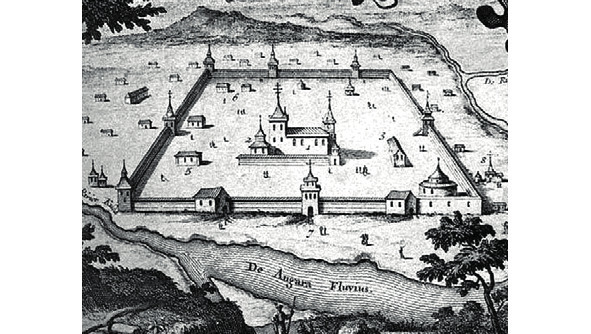
Glazkovo Microdistrict
From the bridge over the Irkut, we enter the Kaya Mountain, which glorified the city to the whole world with the discovery of the Glazkovo necropolis — the largest ancient burial ground on the territory of the modern metropolis. On the whole territory of Eastern, Western Siberia and the Far East taken together, as many burials of the Stone Age were found as at the area of Lokomotiv stadium in Irkutsk. Moreover, this is only 2% of the total number of finds in Glazkovo, many of which are the most valuable artifacts that adorn collections of many museums in Siberia and central Russia.
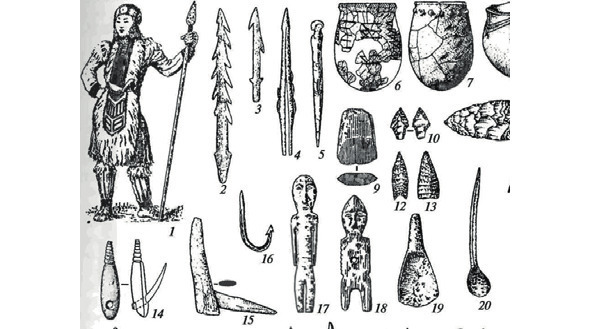
We will continue moving along Botkin street. Here, at the turn of the road on the right, you can see the building of an old hospital (Botkin Str., 4В), which is the only one preserved from the huge complex of the resettlement center of the Eastern Part of the Siberian Railway, built in 1906 for the needs of landless peasants coming from European Russia to live in Siberia and on the Far East. In this building since 1912 as local doctor worked M.P. Gerasimov in in whose family was born the famous scientist M.M. Gerasimov. Even at the age of 9, little Misha collected strange stones in the vicinity of his house and brought them to the local history museum, where he showed them to the Swiss archaeologist B.E. Petri. In 2007, during the construction of a new building (Dzhambul Str., 30), a 36,000-year-old site was opened, traces of which were found in 1924 by a young archaeologist. A few thousand items as unique pendants made of talc, articles made of rhinoceros and mammoth bones and tools of labor were found.
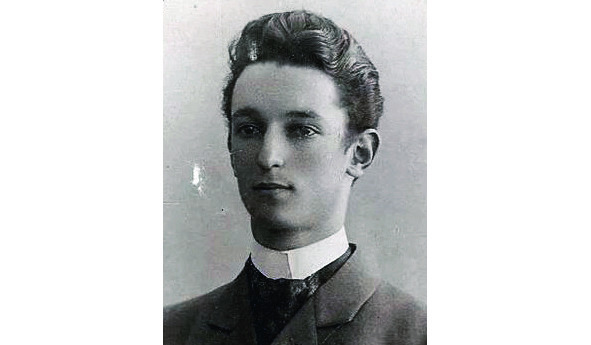
The career of a professional archaeologist M.M. Gerasimov began in 1928 by conducting excavations right in next to his house at the Cyclodrom park, opened in 1891 for the first cycling races in Irkutsk. Today, this territory bears the name of the Paris Commune, and part of it is occupied by Lokomotiv railroad stadium, built in 1954. This is certainly an iconic place for Irkutsk. Since 1984, the ancient burial grounds have been preserved here under special asphalt caps for the creation in 2023 the first mankind history museum in Russia.
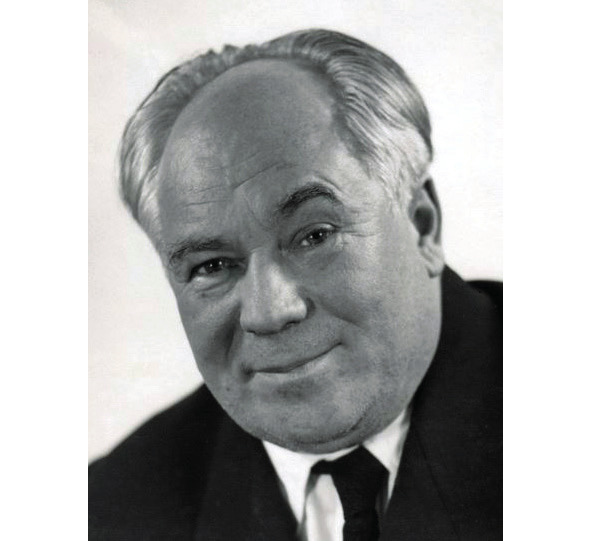
Opposite the stadium, in a five-story building, there is the Siberian Federal Scientific Center for Agrobiotechnologies of the Russian Academy of Sciences, since 1979 it has been subordinate to research institutes, breeding and experimental stations operating throughout Siberia (Botkina Str., 4). Its neighbor is the Irkutsk Interregional Veterinary Laboratory, which has been operating here since 2003 and serves about 30% of the territory of the Russian Federation (Republic of Buryatia, Republic of Sakha, Zabaykalsky Kray, Irkutskaya Oblast). Today, this creates a scientific basis for the agro-industry in the vast Siberian territory.
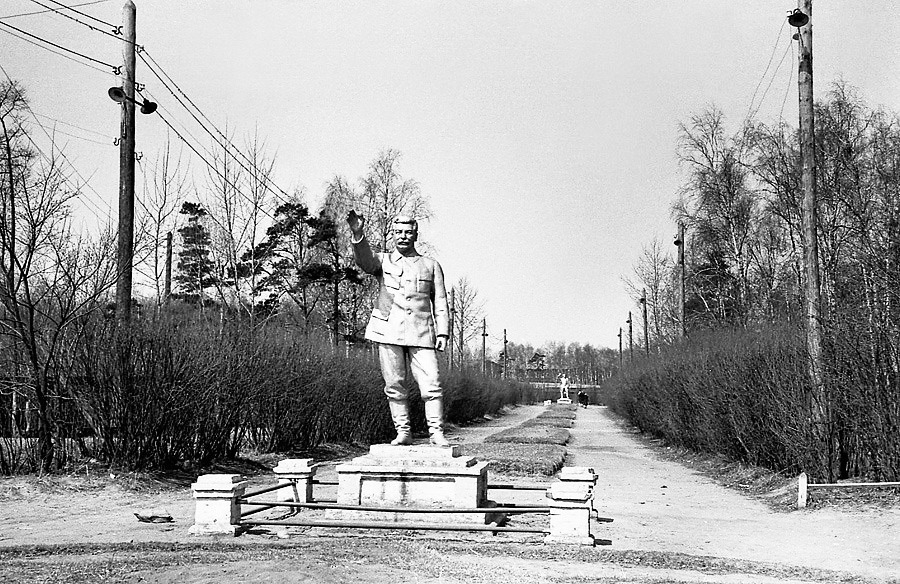
At the intersection with 2nd Zheleznodorozhnaya Street, on the right side, it is hard not to notice the buildings of the Road Clinical Hospital of the Eastern Railway (Botkin Str., 10), built in 1965 to serve railway workers and their families. Directly behind them, in a relic pine grove, is the territory of the «Angara» health resort. It was built at the expense of the merchant of the 1st guild I.L. Medvednikov as a hospital for chronic patients in 1901. The old building of the medical institution can still be seen if you go down the street to Irkut River (2nd Zheleznodorozhnaya Str., 4). The construction project was created by the famous Irkutsk architect A.I. Kuznetsov.
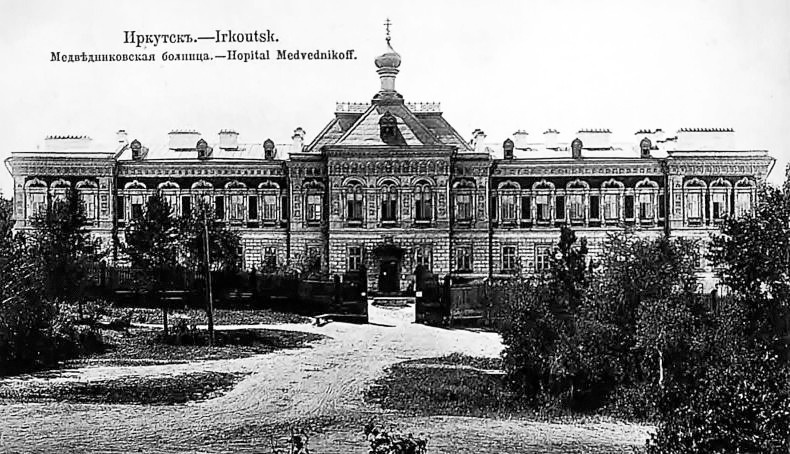
Today, here is the hospital which houses the Irkutsk State Medical Academy of Postgraduate Education, which was created on the basis of a physiotherapy institute that opened here in 1932. During the WWII, there was a neurosurgical officer’s evacuation hospital, and after the victory in 1955, a sanatorium with mineral waters was opened. It operates in our time, scientific research is being carried out, new methods of treatment are being introduced.
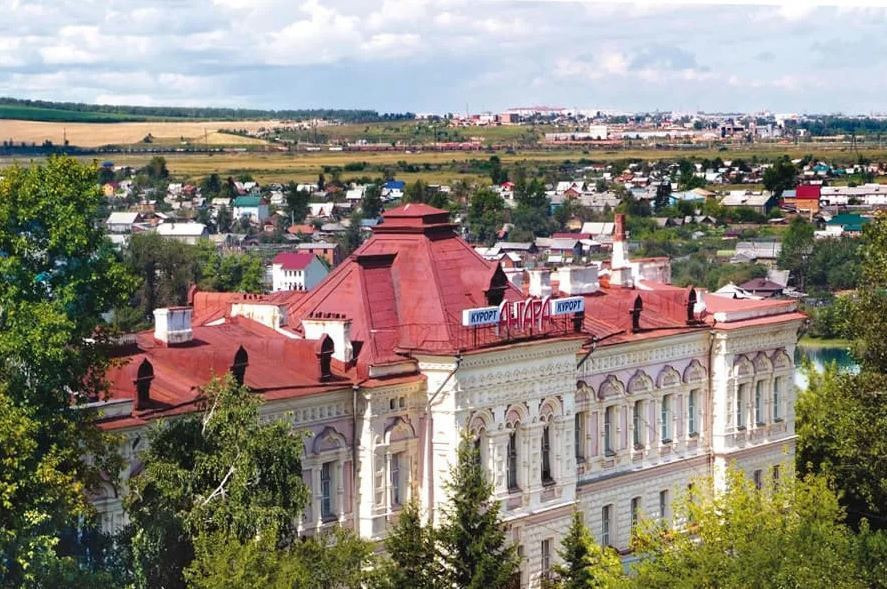
We reach the intersection with Kasyanova street. In the past, this area was mostly inhabited by families of railway workers, due to the proximity of the station. At the intersection with Ostrovsky Street (Kasyanova Str., 35) there is a lonely wooden house in which the future famous film director L.I. Gaidai lived since 1937. In the summer of 1961 here he wrote the script for the film «Dog Barbos and Unusual Cross» while visiting his parents. By the 350th anniversary of Irkutsk, it was planned to create the director’s memorial museum with a cinema alley. However, the plans were not destined to come true due to litigation between the heirs of L.I. Gaidai.
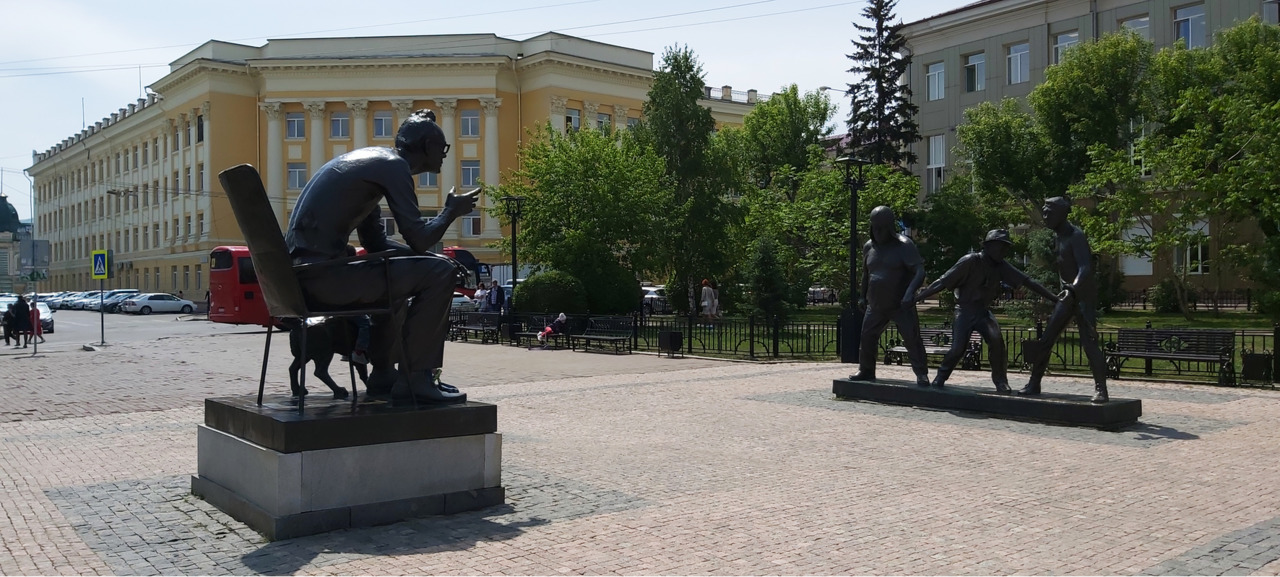
Let’s go down the street the same way that young Leonid went to school every day. At the intersection with 2nd Zheleznodorozhnaya Street, we are greeted by a completely ordinary wooden house (Kasyanova Str., 17), where since 1900 lived the famous creator of the publishing house «Irisy» M.E. Stozh. He not only published pocket guides about Siberia and postcards with views of Irkutsk, but also published such outrageous Russian poets as A.S. Sorokin and D.D. Burliuk. Next to it is the Center for the Culture of the Indigenous Peoples of Baikal Region.
We continue to move along Kasyanova Street and turn left at the intersection with Profsoyuznaya. At the crossroads, on the so-called Mogilev’s site, you can see the memorial complex, installed in 1967 on the site of a mass grave of 19 participants in the uprising against A.V. Kolchak in the Glazkovo suburb in December 1919.
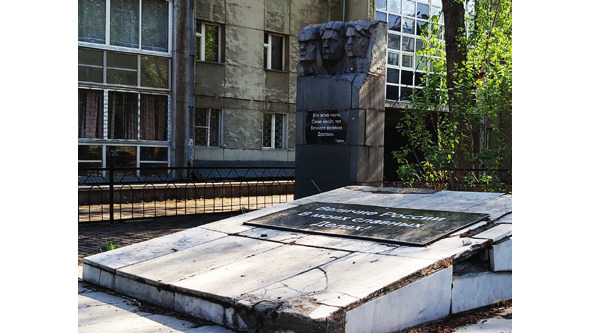
A little further away you can see an old brick building built in 1916 according to the project of V.I. Kolyanovsky for the primary railway school, which was later transformed into the school No. 10 and then No. 42 (Profsoyuznaya Str., 3). Here was the headquarters of the worker-peasant squads during the battles on December 1917. Until 1941, a famous film director L.I. Gaidai studied here, who graduated from school three days before the start of the war. Among the graduates of the school there are other famous personalities: the writer I.I. Molchanov-Sibirsky, author of the method of restoring the human appearance of a person based on the skeletal remains M.M. Gerasimov, the first director of the Irkutsk Institute of the Earth’s Crust N.A. Florensov and many others.
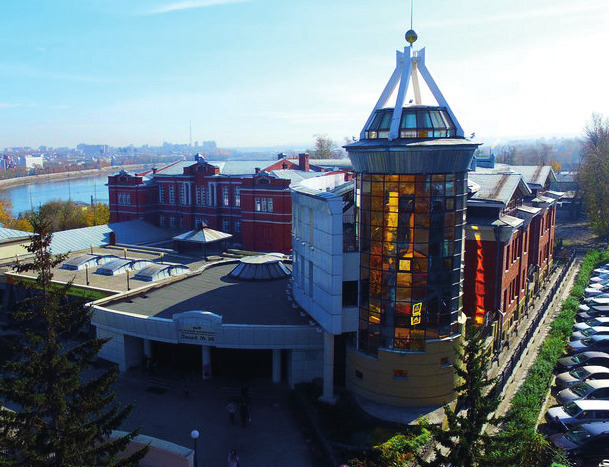
In 2002, according to the plan of the architect S.A. Chumakov, a new school building appeared nearby, which two years later was transformed into the Russian Railways Lyceum No. 36. Until the middle of the 20th century, a very picturesque wooden church built in 1916 and the almshouse of the educational brotherhood of Saint Innocent stood on this site.
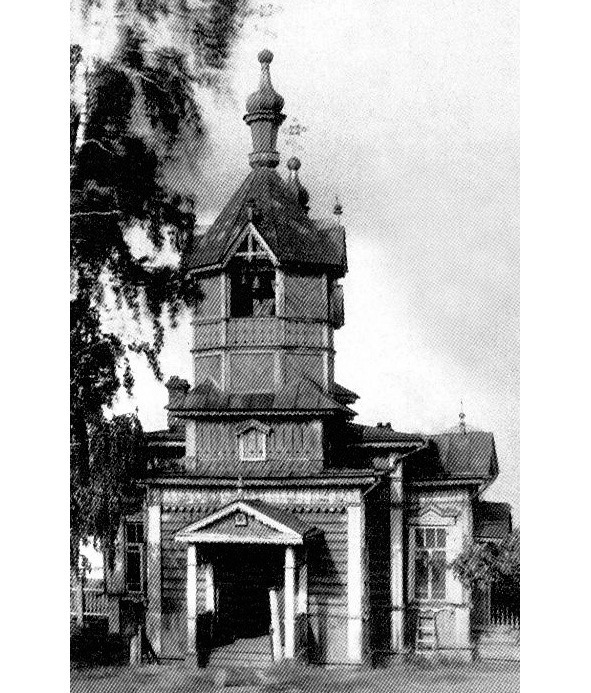
On the left, at the intersection with Mayakovskogo Street, you can see a stele dedicated to the Sverdlovsk district of Irkutsk. It stands opposite the magnificent wooden tenement house of the Verkholensk merchant A.N. Abramov (Mayakovskogo Str., 5). From here we will go down to Dzhambul Street, which is named after the famous Kazakh poet and winner of the Stalin Prize. But before that, let’s linger on the top of the Kaya mountain and admire one of the best panoramas of Irkutsk city.
The Glazkovsky Bridge, the oldest in Irkutsk, goes to the right bank of Angara River. And, although it had a predecessor like pontoon Nikolaevsky bridge, the remains of which are still visible near the shore downstream (it existed since 1891), nevertheless, a permanent crossing appeared in Irkutsk only in 1936. By the time it was put into operation, this was the most longspan reinforced concrete bridge in the USSR. The architect of the bridge I.A. Frantsuz was the author of the project of the mausoleum of V.I. Lenin on Red Square in Moscow. And on the last parapet pedestal on the left towards the city, you can still see a sign stating that this bridge is a real «monument to V.I. Lenin.»
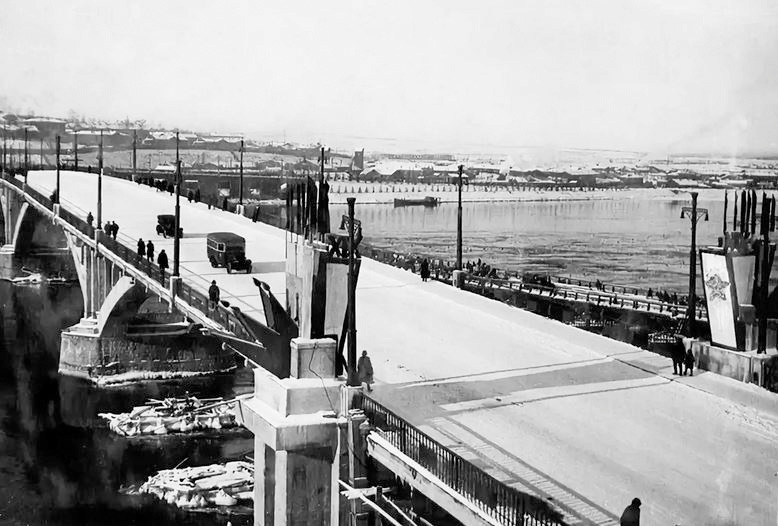
In the meantime, we will turn right and continue our movement along Chelnokov Street, named after the twice Hero of the Soviet Union, General N.V. Chelnokov, who made more than 270 sorties, bringing death to the enemy in the air and on the ground from the Baltic to Black Sea. How symbolic that he was born in Irkutsk on a Great Victoru Day on May 9, 1906. A monument to him was set here at the entrance group to the Sverdlovsk region, in a small square at the foot of the Kaya Mountain. However, this was done unforgivably late: only on October 2, 2016, on the 110th anniversary of the birth of the aviation general.
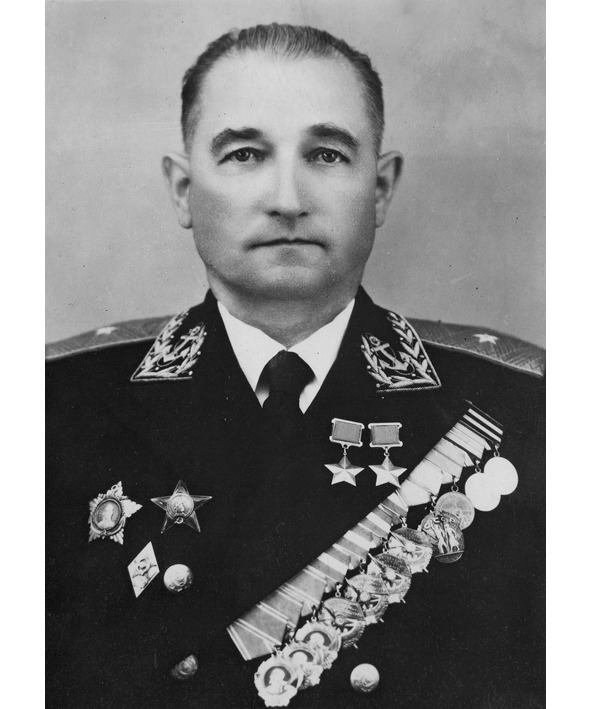
Ahead appeared the building of one of the most beautiful passenger stations in Russia — Irkutsk. It was built in 1907 according to the project of architect V.I. Kolyanovsky, and which is undergoing a complete reconstruction in our time (Chelnokova Str., 1). Above the station, on a steep slope, the small Saint Nicholas and Innocent Church froze. It became the first temple that arose in Irkutsk on the left bank of the Angara.
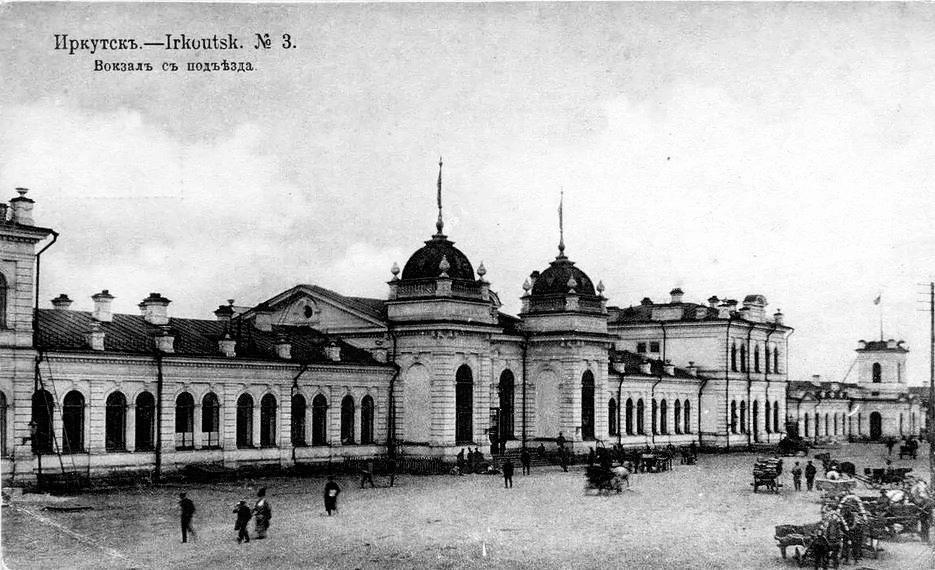
Previously, the residents of the Glazkovo suburb were forced to cross the tempestuous waters of the river, sometimes risking their lives in order to be able to pray at the nearby Holy Trinity Church (5 Armii Str., 8). Therefore, in 1859, at the expense of the merchant of the 3rd guild, Y.S. Malkov, on the left bank of the Angara, a new stone temple was built in the classical style (Profsoyuznaya Str., 45A).
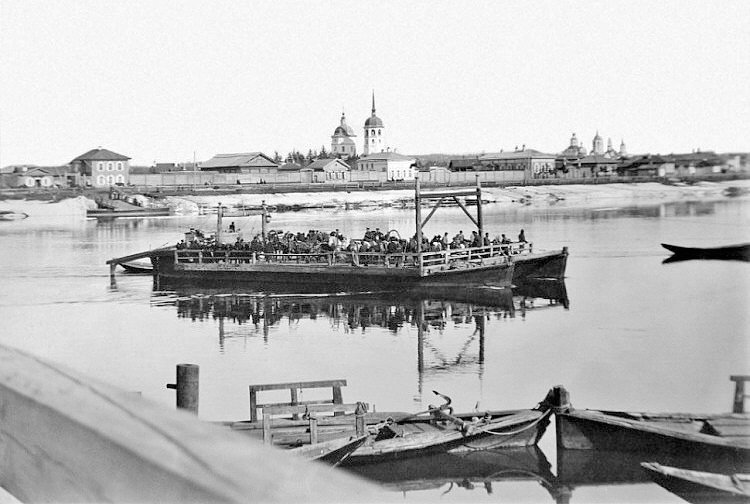
With the arrival of the railway in Irkutsk, the population of the city doubled, and the church became small for all parishioners, but due to lack of funds and the Russian Revolution, plans for enlargement were not destined to come true. In 1934, the emergency building was closed and «Zarya» cinema was opened in it. Only in 2003 the temple was restored and returned to believers at the expense of the East Siberian Railroad.
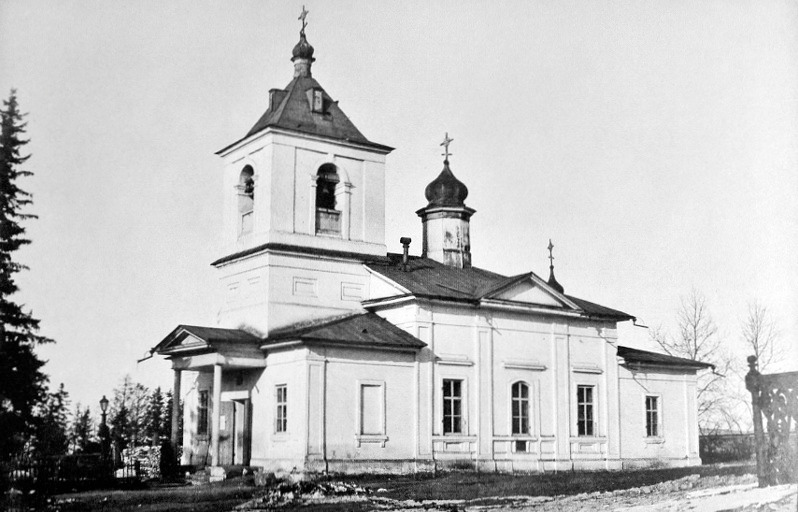
At the tram ring, we turn sharply to the right — onto the street named after the world’s first female cosmonaut V.V. Tereshkova. In the past, this street was called Krugobaikalskaya, and since 1801 the main route from Irkutsk to China called «Circum-Baikal» began from here. It started right from Troitsky ferry on the site of the modern station and went up to the Kaya mountain. Since then, the width of the street has remained the same.
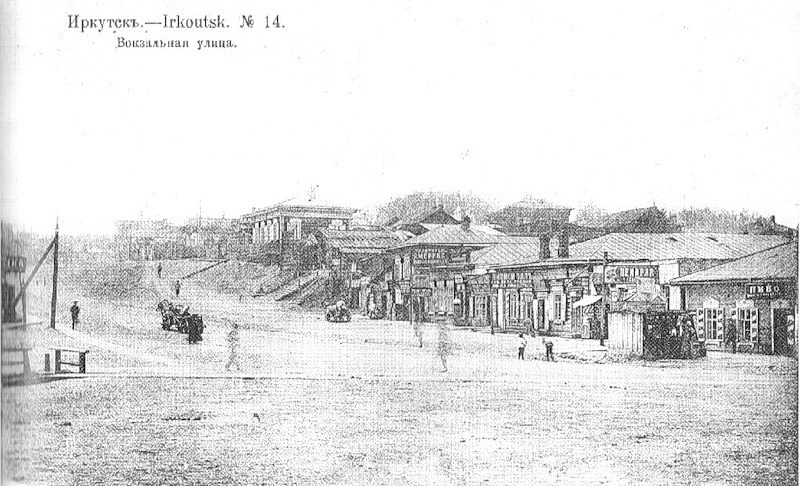
Up the street on the right side of the road, the last wooden house attracts attention, where the famous Siberian writer I.I. Molchanov-Sibirsky (Tereshkova Str., 20) lived. Opposite, at the turn of the tram rails, once happened the worst disaster on public transport in the history of Irkutsk. On May 1, 1953, during the opening of a branch line of route No. 1 to Studgorodok, the brakes failed on a crowded tram. At full speed on the turn, it rolled over and hit the wall. The tragedy was hushed up by the authorities, and the number of dead is still unknown. After this event, the branch was launched in 1961, and only when the slope of the road was minimized.
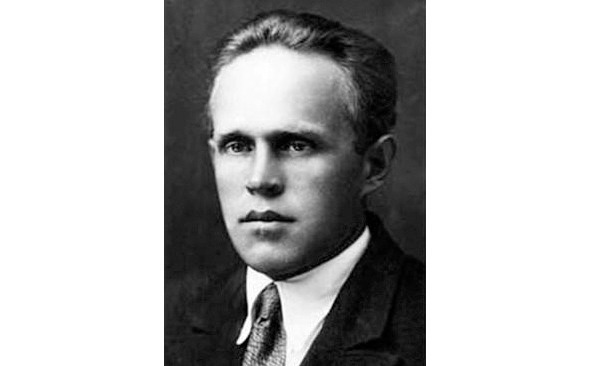
At the intersection with Gogolya Street, a children’s clinic No. 5 construction is underway. In 1971, the cinema «Chaika» was built on this site, named after the space call sign of V.V. Tereshkova. Opposite across the road is a small Peter and Paul Church, which appeared on the site of a magnificent wooden church, transferred here from the village of Mikhalevo in 1918. It was originally built in 1911 by the architect F.F. Koshtyal in the Art Nouveau style on the territory of the Mikhalevo’s military camps 26 km south of Irkutsk, where the 7th East Siberian Rifle Division took summer training. Today, at that place is Kurminsky Bay — the largest on the Irkutsk reservoir. In 1990, the temple was dismantled for restoration, and burned down. Today, funds are being raised for the restoration of the monument (Gogolya Str., 42).
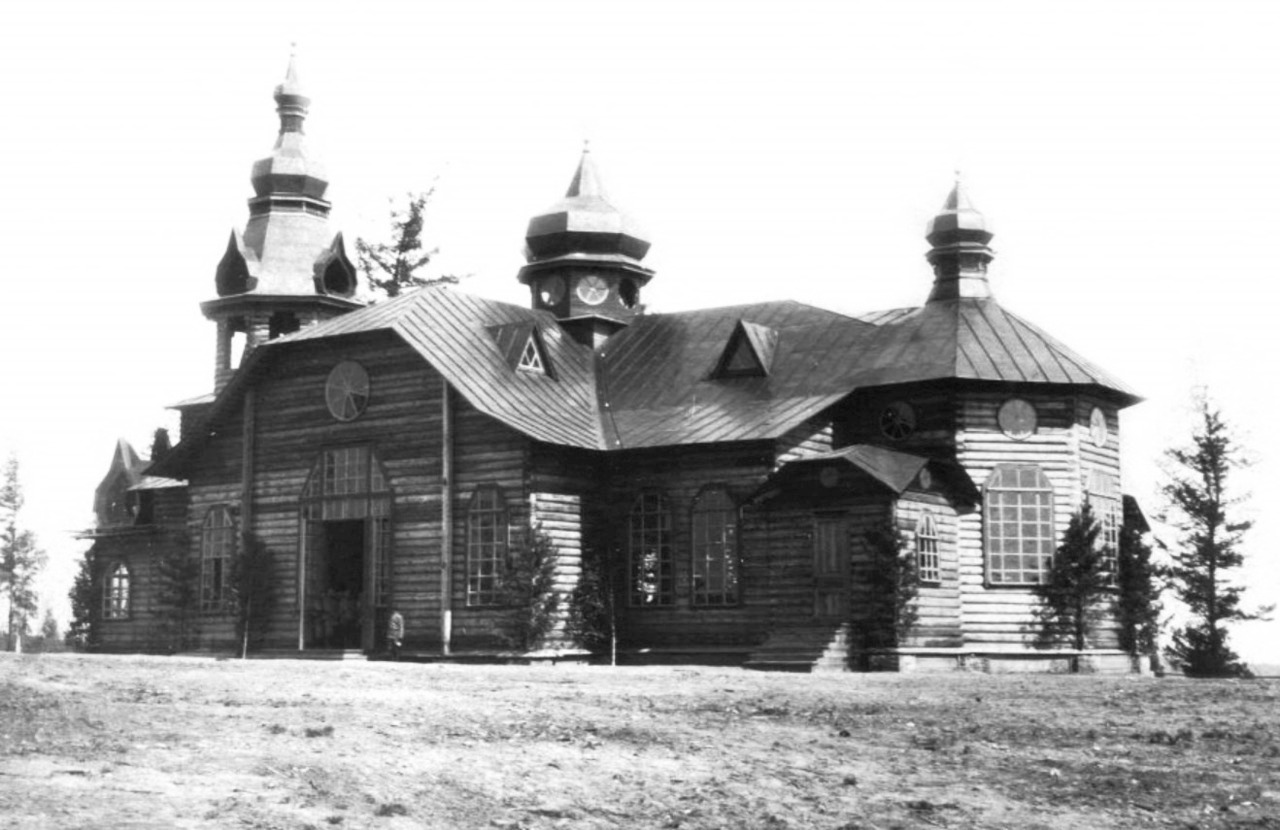
We turn right and find ourselves on Gogolya Street. On the right hand, a large complex of buildings attracts attention. From 1935 to 2002 it belonged to the main pasta factory in Irkutsk. Every day, about 50 tons of products were produced here, almost 300 people worked. Today the fate of buildings is being decided (Gogolya Str., 35).
On the other side of the road is another old trading platform of Irkutsk — the Sverdlovsk market or the Glazkovsky shopping arcade, which opened on this site in 1903. As before, in more than 200 pavilions you can buy any food and goods (Gogolya Str., 44).
Behind the market on the right, you can see the building of another old school (Gogolya Str., 33), built in 1902 according to the project of V.A. Rassushin for the needs of the Saint Vladimir School, which previously occupied a room near the railway. Initially, it was based on the funds of V.P. Sukachev in 1888 in honor of the 900th anniversary of the Christening of Russia. Nowadays, an educational institution is still located here — children’s music school No. 3.
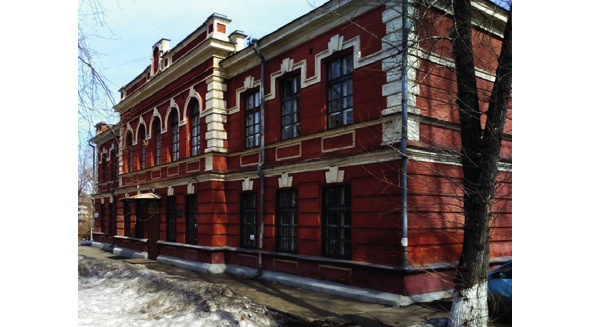
At the crossroads we turn left onto Kaiskaya Street to the intersection with 2nd Zheleznodorozhnaya, where you can see one of the most beautiful wooden houses in Glazkovo belonged to F.S. Shachkov, built in 1910 (Kaiskaya Str., 24). Directly opposite it, across the road until 2019, you could see the house of the Irkutsk Baptist Church, which appeared here back in 1944, but only at the beginning of the 21st century moved to a nearby modern stone building (Kaiskaya Str., 5). Today there are four Evangelical churches in the Irkutsk.
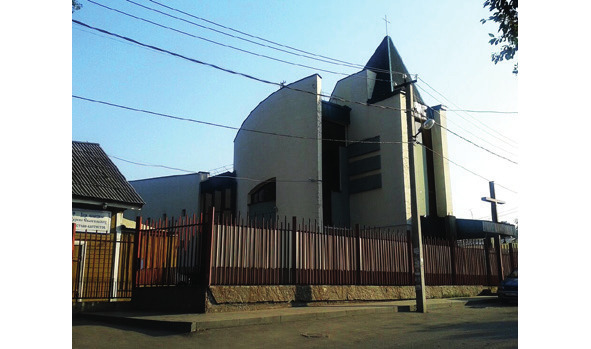
At this point we will turn left onto the street named after the great Russian poet M.Y. Lermontov. On the right hand, we will definitely visit the Irkutsk nerpinarium (2nd Zheleznodorozhnaya Str., 66), where since 2004 the Baikal seals (nerpa) have been demonstrating their unusual abilities to visitors. At the same time, the cost of tickets for the performance is lower than in Listvyanka.
Having passed the Cosmonauts Square, where a monument to V.V. Tereshkova appeared in 2022, at the next intersection we will find ourselves at the Gorky House of Culture (Klara Zetkin Str., 13A). It was built in 1967 on the site of the old Glazkovsky cemetery, which previously occupied the territory of the modern Griboyedovskaya grove. During its existence, about 10 thousand Irkutsk people were buried here, as well as 25 Czech legionnaires, mostly killed during combat skirmishes with the Red Army in May 1918. In fact, no grave monuments have been preserved, apart from rare fragments that can be found throughout the area of the grove. Contrary to the general delusion, the student hostel, the children’s polyclinic and the garden that follows the House of Culture are not «built on bones.»
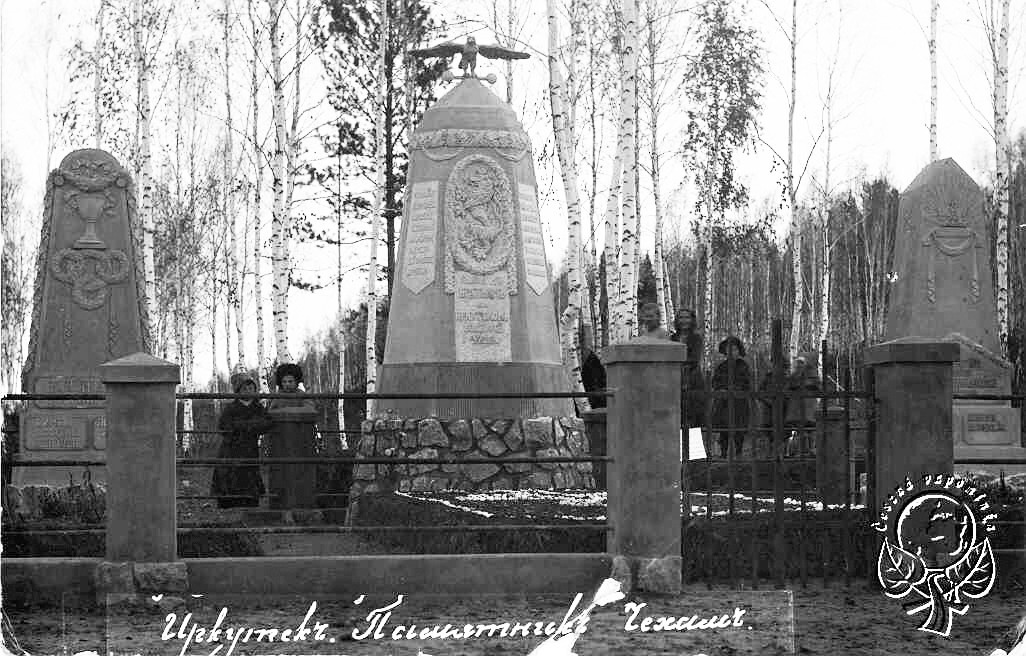
Having reached the tram tracks, we will turn left down Schmidt Street towards the Angara. On the descent you can see many magnificent wooden houses. Unfortunately, among all this beauty, only one house of Rublev (Shmidt Str., 9) is recognized as a monument.
Having passed the temporary detention center (Gogolya Str., 53Б), as well as the student hostel (Pushkina Str., 62A), we will turn onto Profsoyuznaya Street, already familiar to us, formerly known as Aleksandrovskaya, named after Emperor Alexander II, who was killed in 1881. In the past, many celebrities in Irkutsk had summer houses («dacha») along this street, such as mayors V.P. Sukachev, V.V. Zharnikov and B.P. Shostakovich. On the land of the latter in 1910 the therapeutic department of the railway hospital was built, which is one of the most striking wooden modernist buildings in the city. It meets us second on the left side of the road (Profsoyuznaya Str., 87Д).
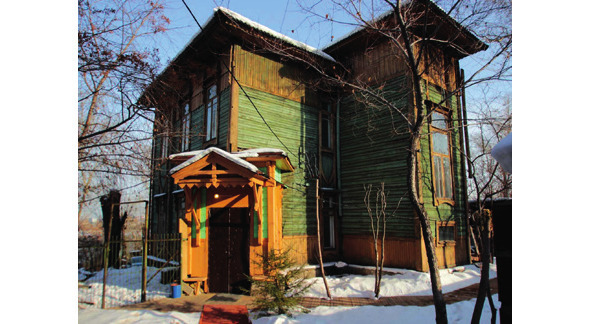
We rest against one of the entrances to the grove «Zvesdochka». This park got its name back in 1861 after the «zvesdochka» of fireworks, which were so loved by the first owner of this suburban area Governor-General of Eastern Siberia M.S. Korsakov. In 1925, during archaeological excavations in the territory of the garden L.N. Ivaniev discovered many Paleolithic ceramic adornments and utensils, as well as bronze cauldrons, swords and knives.
Moving along the grove up by Zvezdinskaya Street, we pass on the right hand the modern school No. 80 (Pushkina Str., 64), the project of which, created in 2001 by architects E.I. Grigorieva and S.V. Mullayarov, received many gold diplomas and several state awards. Previously, the school was located in the neighboring building of the music department of the college of teacher education, built in 1936. Here studied L.I. Gaidai before was expelled for behavior, and during the WWII, an evacuation hospital was located here (Zvezdinskaya Str., 12).
On the opposite side of the road, behind a wooden building, you can see an old stone building, which was built in 1916 according to a typical design by engineer K.V. Mital for Lomonosov School (Gogolya Str., 55). It is still used for educational purposes as Irkutsk Regional College of Pedagogical Education. It has repeatedly been awarded the gold medal «European Quality of Education» and included in the list of «100 best colleges» in Russia.
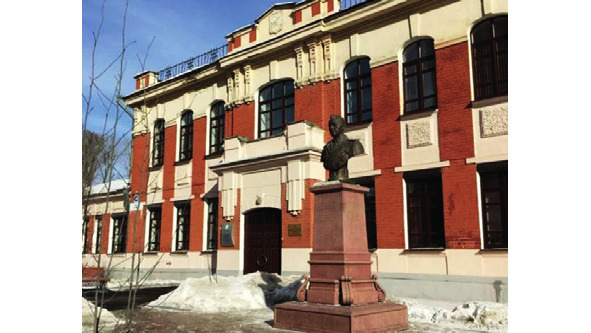
Opposite it you can see the bust of K.K. Rokossovsky, which was installed in 2015 on the closed territory of Irkutsk Higher Military Aviation Engineering School (IHMAES), and three years later it was moved here. This is not by chance, because it was in this building that in 1920 the headquarters of the 30th cavalry regiment of the 5th Army was located which was under the command of the future marshal. Many things connected K.K. Rokossovsky with Irkutsk. In this city, he received his first Soviet award — the Order of the Red Banner, his first true love, Y.S. Brylovskaya, lived here, who gave birth to his son Victor.
Having passed the semi-antique guest house on Zvezdinskaya Street, we will return to Lermontov Street and at the Sports Palace «Izumrud» we will again turn to Angara River (Chernyshevsky Str., 12). The latter is under the jurisdiction of the Irkutsk State University of Communications (IrSUC), whose unusual building we will see a little lower down the slope (Chernyshevsky Str., 15). This educational institution appeared in 1975 due to an acute shortage of engineers during the resumption of the construction of the Baikal-Amur Magistral (BAM).
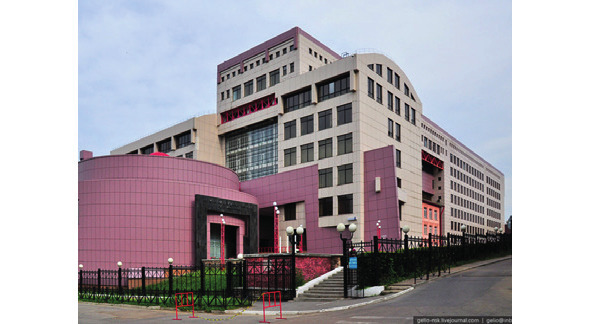
At the intersection with Belinskogo Street, there is a small but very picturesque two-story house of Syskov (Belinskogo Str., 1) built at the end of the 19th century. Next, near the bank of Angara, we turn right after the rails of Trans-Siberian Railway. In front of the intersection with Zhukovskogo Street, there are two beautiful wooden houses built in 1915 (Gerzen St., 16 and 18). The first belonged to the clerk of the traffic service of Trans-Baikal Railway A.S. Dubenevich, and the second to a certain Vishnyakova.
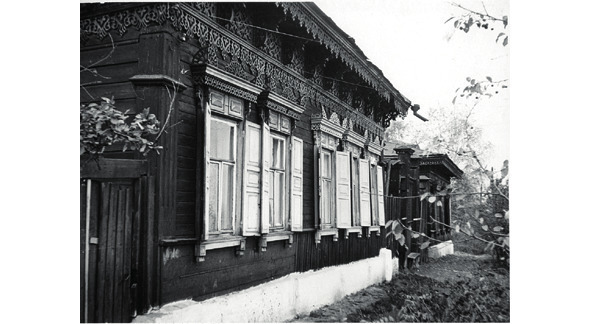
Having reached the end of Herzena Street, we will find ourselves at the ancient border of the Glazkovo suburb. From the side of the Angara River, since 1890, there was a favorite place for summer recreation of Irkutsk people — «Tsar’ Devitsa» garden. It was named after the historical figure of Maria Titova, who lived in the 19th century, who left at home alone without a father and hacked to death with an ax five robbers who got into her room at night. The park operated a restaurant with drinks, light snacks and confectionery, as well as a photo pavilion. However, a few years later, when a railway passed along the park, and the smoke from passing steam locomotives began to pester the guests, the place lost its popularity, and in 1910 it was closed for debts. In 1930, the first broadcast radio station in Irkutsk appeared in the garden, and it’s still there today (Radiostantsiya 5 Str., 1).
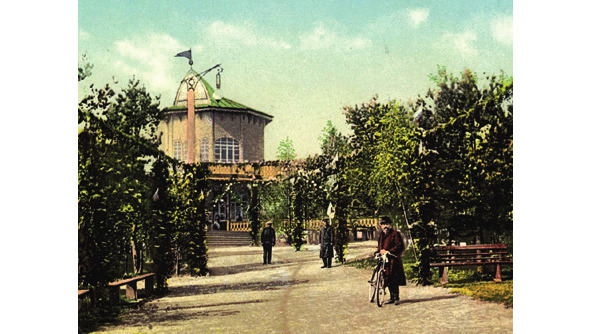
Slightly upstream of the Angara, next to the park, was the village of Titovo, which today is reminiscent of several wooden houses at the very edge of the railway along Lesia Ukrainka Street. The first settlement at this place was mentioned by the ambassador to China N.G. Melescu-Spafari in 1675. It was also inhabited in the earlier eras of the Bronze, Iron, Neolithic, Early Metal and Mesolithic, as evidenced by the collection of ceramics and stone tools collected here.
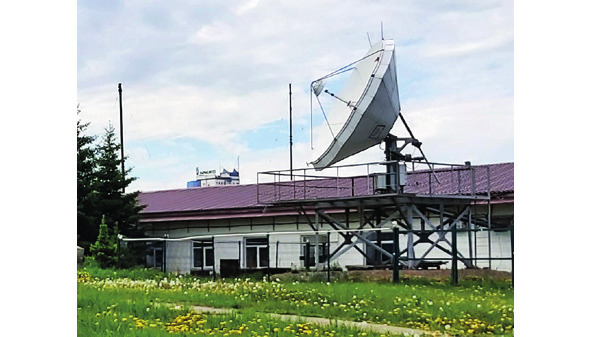
Studgorodok Microdistrict
From here we get to the Studgorodok microdistrict, on the territory of which there are 17 student dormitories today, the first were built in 1957. Moving up Lomonosova Street, at one of the turns you can still find a monument hidden from prying eyes on a mass grave where were burried brother-in-law of P.P. Postyshev and the first chairman of the Siberian Extraordinary Commission I.S. Postolovsky, along with his six comrades. They were hanged on August 3, 1918 in revenge for the execution of participants in the anti-Bolshevik uprising and buried on the outskirts of the city near the former garden «Tsar Devitsa» (Lomonosova Str., 70).
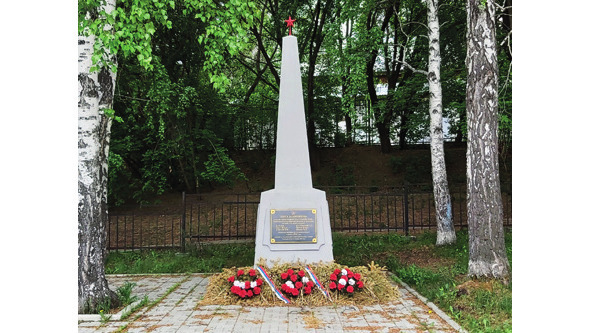
To the left on the hill rises the huge building of the Irkutsk National Research Technical University (INRTU), which appeared here in 1957 and today is one of the 300 best higher educational institutions in the world (Lermontova Str., 83). He was the first in Siberia to create the Eurasian Open University on its basis, so graduates, in addition to the usual diploma, receive an international document. Every year more than 30 thousand students study within the walls of this institution. Among the famous graduates of the educational institution, the pilot and Hero of the Soviet Union G.S. Aseev, aircraft builder L.A. Khvorostukhin, scientist-metallurgist E.P. Bochkarev, writer G.N. Mashkin, General Director of the Ulan-Ude Shipbuilding Plant G.I. Tsukanov, as well as the first Soviet woman who climbed to the top of Everest — E.N. Ivanova.
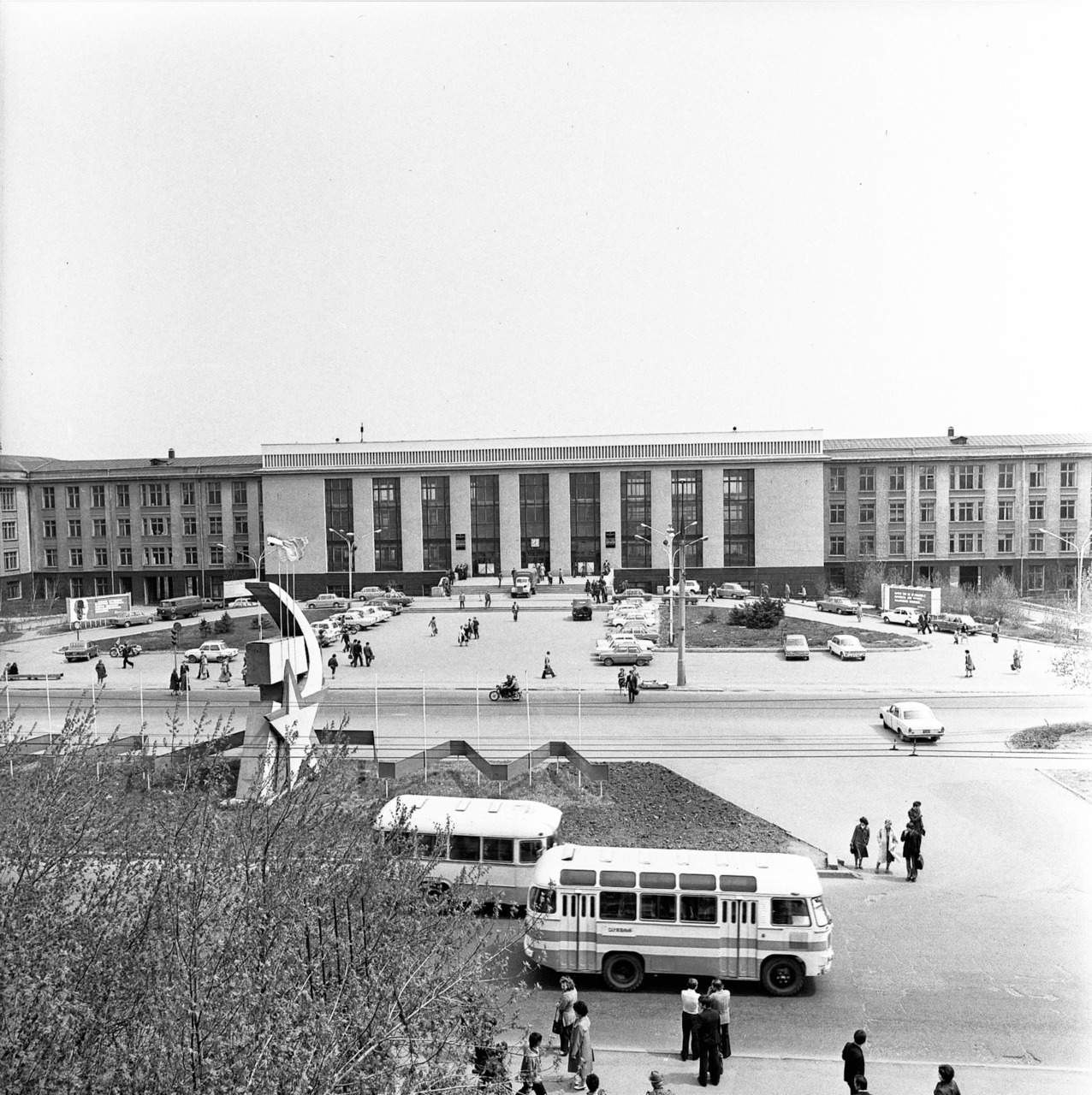
Today, on the first floor of the university, in wing «B», from the side of Igoshina Street, there is the largest mineralogical museum in Siberia, the collection of which includes more than 27 thousand exhibits. The basis for the creation of the exposition in 1930 was the collections of the oldest geologists of Siberia — V.I. Tikhomirov and A.V. Lvov. Since 1991, the institution has been named after A. V. Sidorov, Associate Professor of the Department of Geology at INRTU, who significantly expanded the collection. Opposite the entrance to the museum, you can see a small cross, installed in 1999 on the site of the proposed construction of a youth church in the name of Saint Sergius of Radonezh.
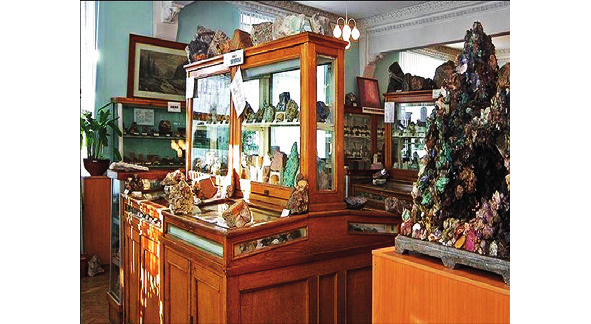
On the other side of the road from the university, you can see the silhouette of the Catholic Cathedral of the Immaculate Heart of the Mother of God, built in 2000 according to the project of the Polish architect Andrzej Chwalibog and funded by the communities of Russia, Poland, Germany, Italy and Slovakia (Griboedova Str., 110). It is here that today is the center of the diocese of St. Joseph — the largest in terms of area in the world (about 10 million km2). The altar in the temple is made of Baikal jade, and on the sides of it are the statues of the Mother of God of Fatima and St. Joseph the Betrothed.
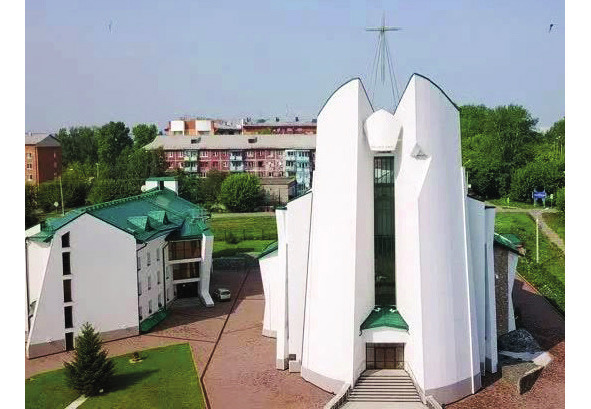
On the north side of the cathedral you can see the Chapel of Reconciliation and Peace with a bronze sculpture of Jesus Christ by the Polish sculptor Vincenta Kuchma. At the base of the slab of black dolerite with inscriptions in Russian and Latin, there are urns with earth from the mass graves of prisoners of 14 «GULag « (chief administration of the camps).
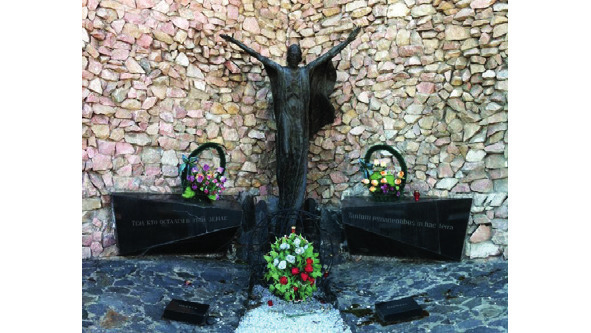
We continue our way down Lermontov Street and move towards the Trans-Siberian Railway, which turns sharply here to the west, which passed this way in 1949. Until 1957, the rails ran along the left bank of the Angara to Baikal itself. There we will go further, restoring the history of the old road step by step. During the laying of the turn of the Trans-Siberian Railway near the Angara coast, one of the largest burials of the Paleolithic times (22 thousand years old) was discovered, about 40 thousand finds were collected.
Next to the viaduct on the left we can see the building of the Lyceum of the Irkutsk State University (hereinafter ISU), which opened here in 1995 and today is among the 200 best schools in Russia (Akademika Kurchatova Str., 13A). On the right hand is the East Siberian Institute of the Ministry of Internal Affairs of the Russian Federation, founded on this site in 1962. Today it is the leading educational institution in Eastern Siberia that trains law enforcement officers (Lermontova Str., 110).
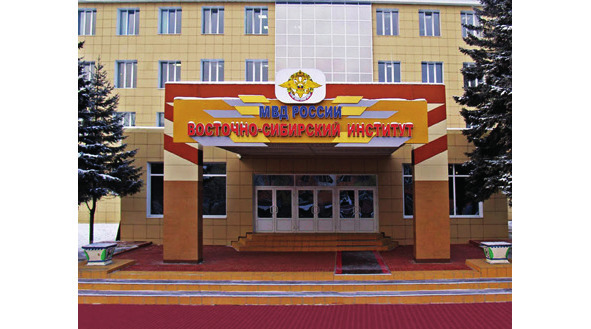
Academgorodok Microdistrict
It’s time to get acquainted with the most prestigious area of the city of Irkutsk — Akademgorodok. It appeared in February 1949 on the basis of the first two scientific institutes. They were supposed to become the center of the Siberian Branch of the Russian Academy of Sciences (SB RAS). However, fate decreed otherwise, and it was transferred to Novosibirsk in 1957. But 11 institutes that conduct research in the field of exact knowledge are still operating — more than 230 doctors and 660 candidates of sciences are working here.
The first houses in this area appeared in 1965. It was decided that the left side of Lermontova Street would be occupied by residential buildings, and the right side by scientific corps. At the same time, a unique arboretum was formed on the territory of Academgorodok with plants atypical for Siberia (ash, hornbeam, elm, svidina, bird cherry of Maak). The district plan was drawn up by the architect V.P. Shmatkov and subsequently modified by V.F. Bukh.
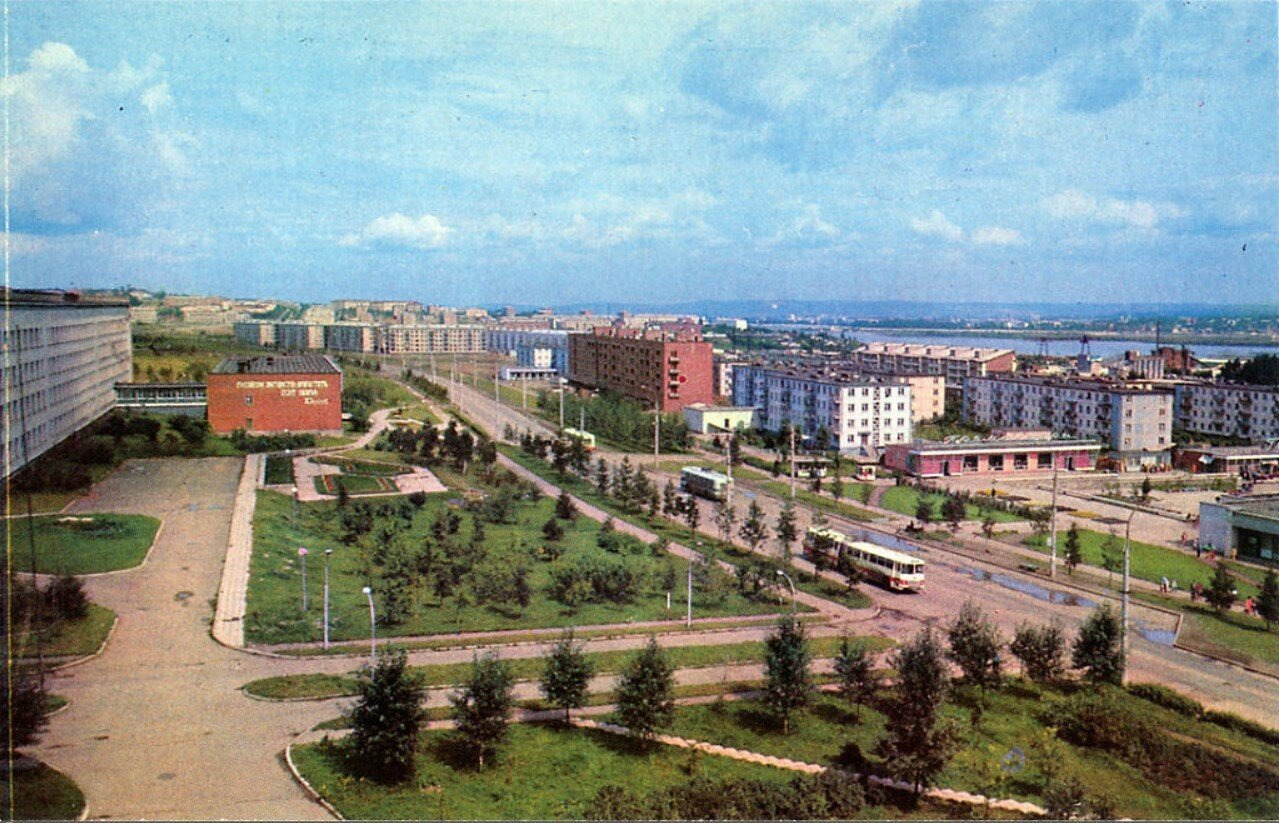
First on the left hand we are met by the Ice Palace «Iceberg», which opened in 2016 after 16 years of construction and a billion investments (Lermontov Str., 251). In 2020, a new winter sports ground called «Baikal» appeared next to it (Lermontov St., 249). The last one is twice bigger and six times more expensive, it can accommodate 6,000 spectators. Its construction was dedicated to the world bandy championship. The advantage is the possibility of re-equipment at any time for summer sports disciplines.
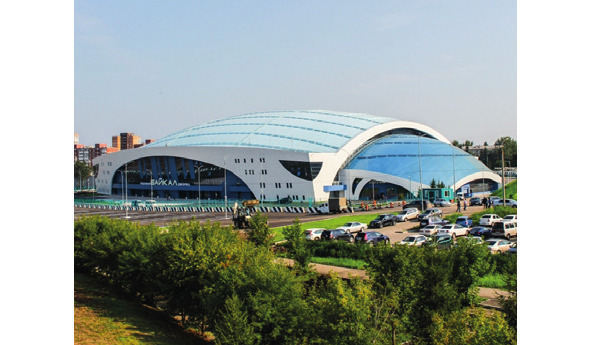
Following the sports complex rises the modern building of the library named after I.I. Molchanov-Sibirsky, which moved here in 2013. The book depository operates a self-issuing system for literature, a fumigatory, a leaf replenishing machine, modern scanners, and about 2 million items of storage. Every year the library holds more than 500 different events (Lermontov Str., 253).
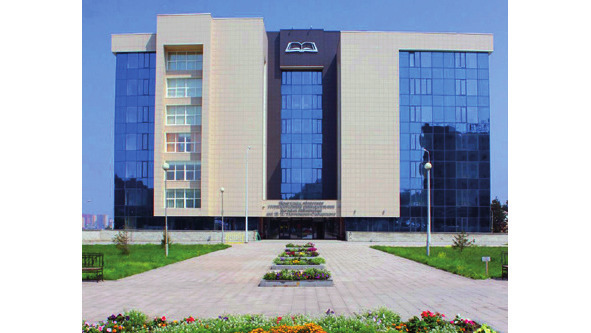
And on the other side of Lermontova Street there is a seven-story building of the scientific library of the ISU named after V.G. Rasputin, which since 2016, after the long-awaited move from the White House on the Angara embankment, has housed all four departments of the largest book depository in Eastern Siberia, numbering more than 2.5 million exemplares, some of which are older than Irkutsk itself. The construction of this facility began in 1981, but for a number of reasons it was postponed indefinitely. Today, students do not need to run around different parts of the city — here, in 11 reading rooms, you can find all the necessary information (Lermontova Str., 124).
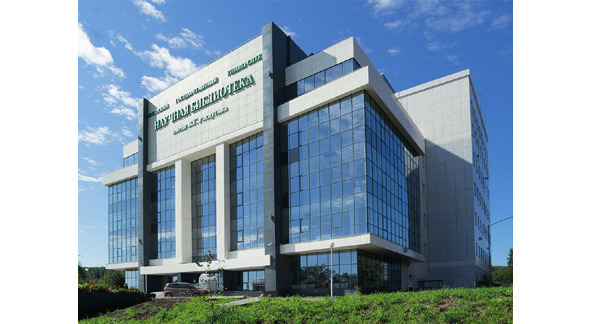
Acquaintance with the educational institutions of Akademgorodok opens at the intersection with Ulan-Batorskaya Street, where on the right you can see the building in which, since 1974, the faculties of chemistry, geography, service and advertising of Irkutsk State University have been located (Lermontova Str., 126). Immediately behind it, in a small spruce grove, there is a memorial dedicated to the students and teachers of the university who died during the WWII. These two marble steles were set in the fall of 1979. Among the 27 indicated names, one can find the name of the Hero of the Soviet Union, Guardsman D.Z. Zhanaev, who died on the outskirts of Berlin.
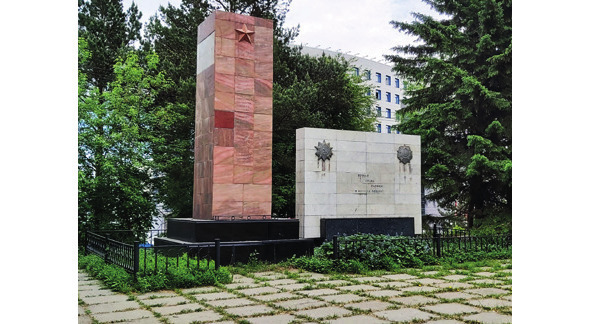
The Institute of Solar-Terrestrial Physics (Lermontova Str., 126A) showed a little higher. It was created in 1960 on the basis of the oldest magnetic observatory in Siberia. The main task of researchers is to establish the connection between phenomena on our planet and changes on the Sun. The employees of this institution create various forecasts regarding the state of the ionosphere and the Earth’s magnetic field. The employees have at their disposal facilities unique for Russia, such as the Large Solar Vacuum Telescope — the largest in Eurasia, the 256-antenna Siberian Solar Radio Telescope, the Irkutsk Incoherent Scattering Radar and the infrared telescope of the Sayan Solar Observatory.
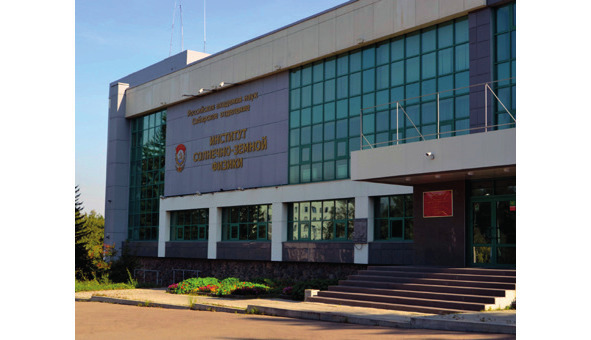
A little higher along Ulan Batorskaya Street there are two more institutes. The first of them is the Institute of Geography of the SB RAS named after V.B. Sochava, established in 1960 on the basis of the oldest department of the Geographical Society in Siberia (Ulan-Batorskaya Str., 1). The institution conducts research on the basics of sustainable development of natural geosystems and their components in accordance with the tasks of modern mankind. Over the years of work, mapping of nature, economy and population of various regions of Asian Russia, as well as neighboring countries, has been carried out.
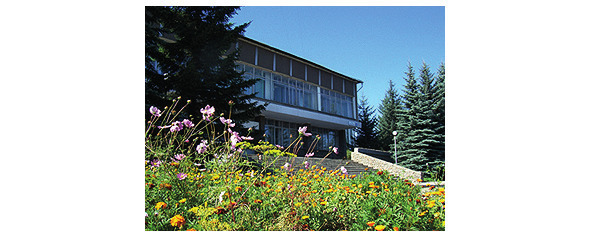
The second of them is the Limnological Institute, which appeared on this place in 1989 (Ulan-Batorskaya Str., 3). The scientists of this institution are studying Lake Baikal, which in many respects served as the basis for the creation of serious science in Siberia. Actually, already in 1897 an attempt was made to create a limnological station in the village of Bolshoe Goloustnoye, thanks to the efforts of the geophysicist V.B. Shostakovich. At least, in 1930 G.Y. Vereshchagin established a station in the village of Listvyanka, which is still in operation. A few years ago, in front of the institute building, the abandoned research vessel called «Chayka» lay on its side, which stood at the origins of the development of science in Siberia.
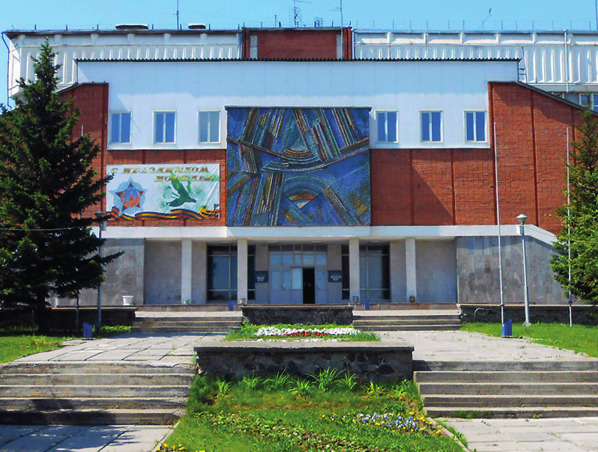
Next, we will drive along Lermontova Street to a small square near the residential complex «Progress» on the left side of the road (Lermontova Str., 267/1), where in 2018, on the occasion of the 55th anniversary of Akademgorodok, as conceived by the City Duma deputy A.V. Safronov, a memorial sign appeared in the form of a globe, based on eleven columns, symbolizing institutions. The paving of the site around is made in the form of a labyrinth with several entrances, as a symbol of the search for scientific knowledge.
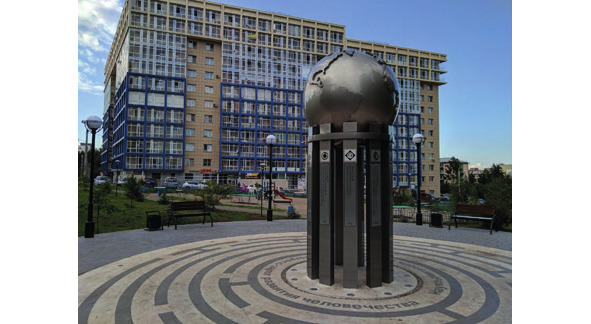
Below the square is the Children’s Art School No. 5, which in 2008 moved to this new building (Lermontova Str., 271Б). Graduates of this institution since its founding in 1969 have been awarded a variety of prizes and awards, constantly taking prizes in the competitions «Gems of Siberia», «Rising Star», «Golden Phoenix», «Hope».
Behind it you can see the new building of school No. 19, which opened in its original place in 2018 after a complete reconstruction (Lermontova St., 279). Today it is the best in the city in terms of equipment. It offers students two swimming pools, a training range, a conference room, equipped classrooms, elevators, the latest sports hall and even the largest school planetarium in Russia with a dome diameter of 11 meters with eight projectors and a capacity of more than 100 people.
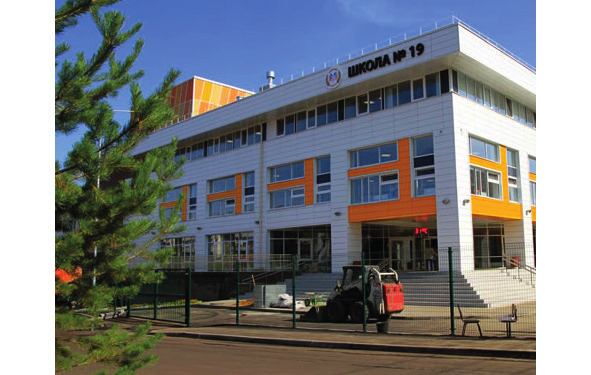
If we drive further, then on the other side of the street we will see the next large building — this is the oldest academic institution of the geological profile and the firstborn of serious science in Siberia — the Institute of the Earth’s Crust (Lermontova Str., 128). It arose on the basis of a local scientific school in 1949. Today, geology is studied here not only in Central Asia, but also in Europe, North America, Australia, Africa, and Antarctica. The organization controls 23 seismic stations located in the mountain belt from the Eastern Sayan to the Olekma river valley. Over the years of research, employees have discovered 15 new minerals. The names of some of them contain the names of the leading scientists of the institute and the bright events of its history (florensovite, natalite, odintsovite, zemkorite, azoproite, and many others).
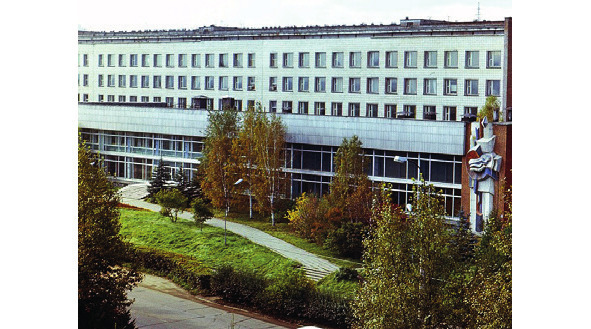
A little further, at the intersection with Favorskogo Street, we see the Institute of Energy Systems SB RAS named after Academician L.A. Melentiev (Lermontova Str., 130). Since 1960, they have been developing a strategy for the development of domestic and world energy, introducing new laws and methods for keeping the safety of resources, and ensuring the constant development of the fuel and energy complex.
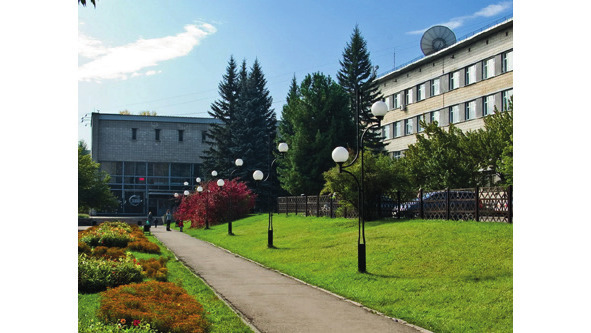
Between these institutes, up the slope, there is the Irkutsk Institute of Chemistry named after A.E. Favorsky, founded in 1957, the building of which became the first scientific building built in Akademgorodok in 1963. The institution conducts research in the field of creating useful products from fossil fuels, mainly through acetylene and its derivatives containing various elements, based on which it is possible to synthesize almost everything that is produced today by the chemical industry (Favorskogo Str., 1).
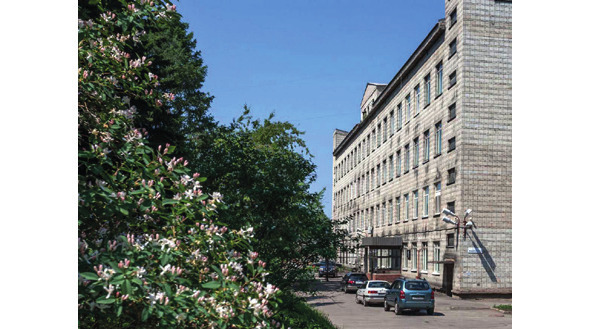
On the same line on the hill, hiding its contemporary the Institute of Geochemistry named after A.P. Vinogradov. Over the years of its work, many features in the history of the evolution of the Siberian Platform have been identified, forecasts have been made about the development of the climate on the planet based on paleoclimatic studies, and the most major developments for electronics, medicine and ecology have been created (Favorskogo Str., 1A).
On the other side, near the larch alley, there is the Siberian Institute of Plant Physiology and Biochemistry, founded in 1961. Research is being carried out in the field of bioengineering and biotechnology, new species of plants and fungi are being created, and rare and endangered ones are preserved in the regional seed bank. The organization operates the oldest phytotron in Russia, as well as a magnificent greenhouse available for visiting (Lermontova Str., 132).
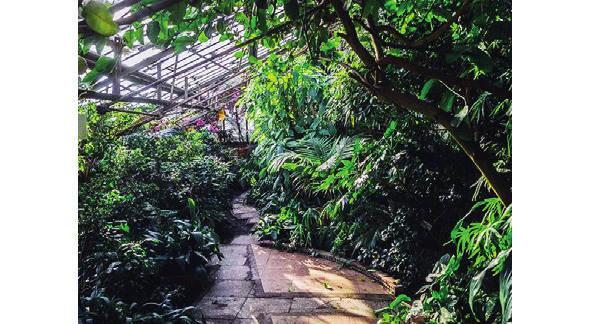
On the right side of Lermontov Street, the Institute of System Dynamics and Control Theory named after Academician V.M. Matrosov. It was created in 1980 on the basis of the Department of Systems Theory and Cybernetics. Within the walls of the institute, fundamental research is carried out in the interests of designing space and aviation technology, and effective methods for managing complex systems are being created. It was here that in 1994, for the first time in Russia, an Internet network was launched for the needs of Akademgorodok (Lermontov Str., 134).
Energetikov Village
Having overcome the Malaya Kuzmikha river through a barely noticeable concrete tray, we find ourselves next to the intersectoral scientific and technical complex «Eye Microsurgery» named after the outstanding ophthalmologist of the 20th century academician S.N. Fedorov (Lermontova Str., 337). It appeared here in 1989, since then more than a million examinations have been carried out here, more than 700 thousand people have been operated on.
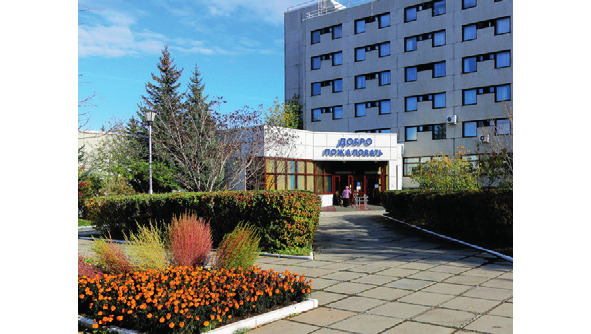
Previously, in the floodplain of the Malaya Kuzmikha river, there was a cemetery of the village of the same name. Downstream, towards the Angara, there was a magnificent rotunda church in the name of St. Nicholas the Wonderworker. It was built in 1822 according to the project of Y.A. Kruglikov and at the expense of the son of the Yaroslavl landowner, lieutenant A.P. Shubin, who was demoted and exiled to Kuzmikha in 1814, where he fell in love with the young daughter of a poor Cossack. Having received forgiveness, he restored with the officer rank of cornet and filed a petition for the construction of a temple in Kuzmikha in 1819. In the 1970s, the building was demolished, and today the trade center «Capitel» is located in its place (Staro-Kuzmikhinskaya Str., 41/2). In addition, in 1884 a cemetery chapel was built in the village. Near the place where it was, today the building of «Eye Microsurgery» rises.
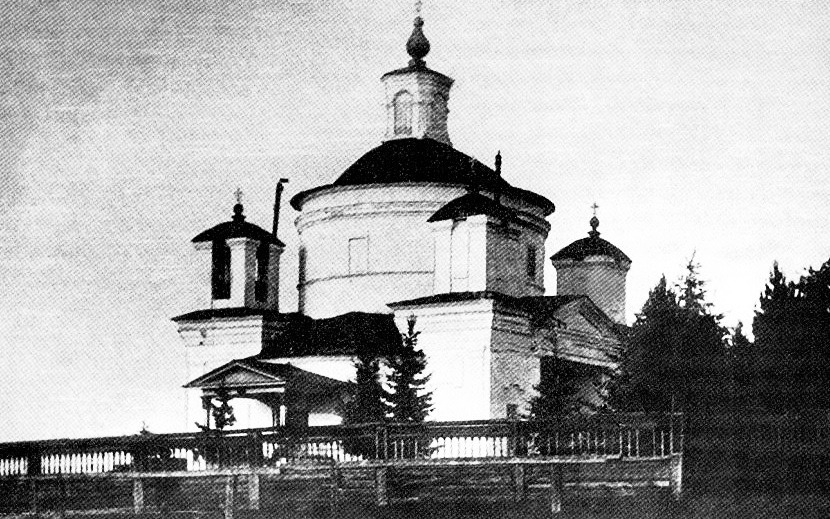
Then we will drive along Lermontova Street to the intersection with Akademicheskaya (Akademicheskaya Str,. 1A). We will turn left at the trolley bus depot, which has been working here since 1970. During this time, almost half a billion passengers have been transported, 10 routes are in operation. Previously this part of Lermontova Street had been a dense forest.
We go down to the floodplain of the Bolshaya Kuzmikha River, which gave its name to a small village located in this part of the Angara. During the construction of seven villages of hydroelectric power station builders, this settlement merged with Irkutsk and today only Starokuzmikhinskaya Street reminds of it. In 1839 the Decembrist A.P. Yushnevsky was assigned to the settlement here, and later moved to his friends in Bolshaya Razvodnaya on the other side of the Angara River.
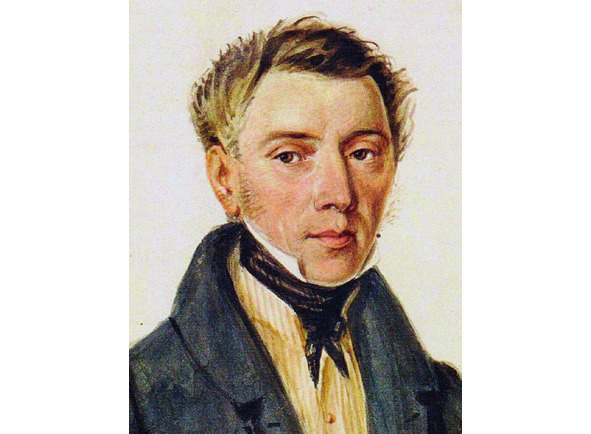
In the area of the modern car workshop «Kuzmikha» you can still see the remains of the old Trans-Siberian railway embankment (Staro-Kuzmikhinskaya Str., 81Б), built here in 1898. Moreover, 5.5 km of the odd track with 6 single-span stone bridges survived. Nowdays it goes from Irkutsk-Passenger station to the prefabricated concrete plant, which has been operating here since 1959 and was originally built for the needs of the construction of the Irkutsk hydroelectric power station (Staro-Kuzmikhinskaya Str., 91). Now the rails rest against the 45-meter embankment of the dam. The old line of the Trans-Siberian after the pound rests at a depth of more than 20 meters in the waters of the Angara River.
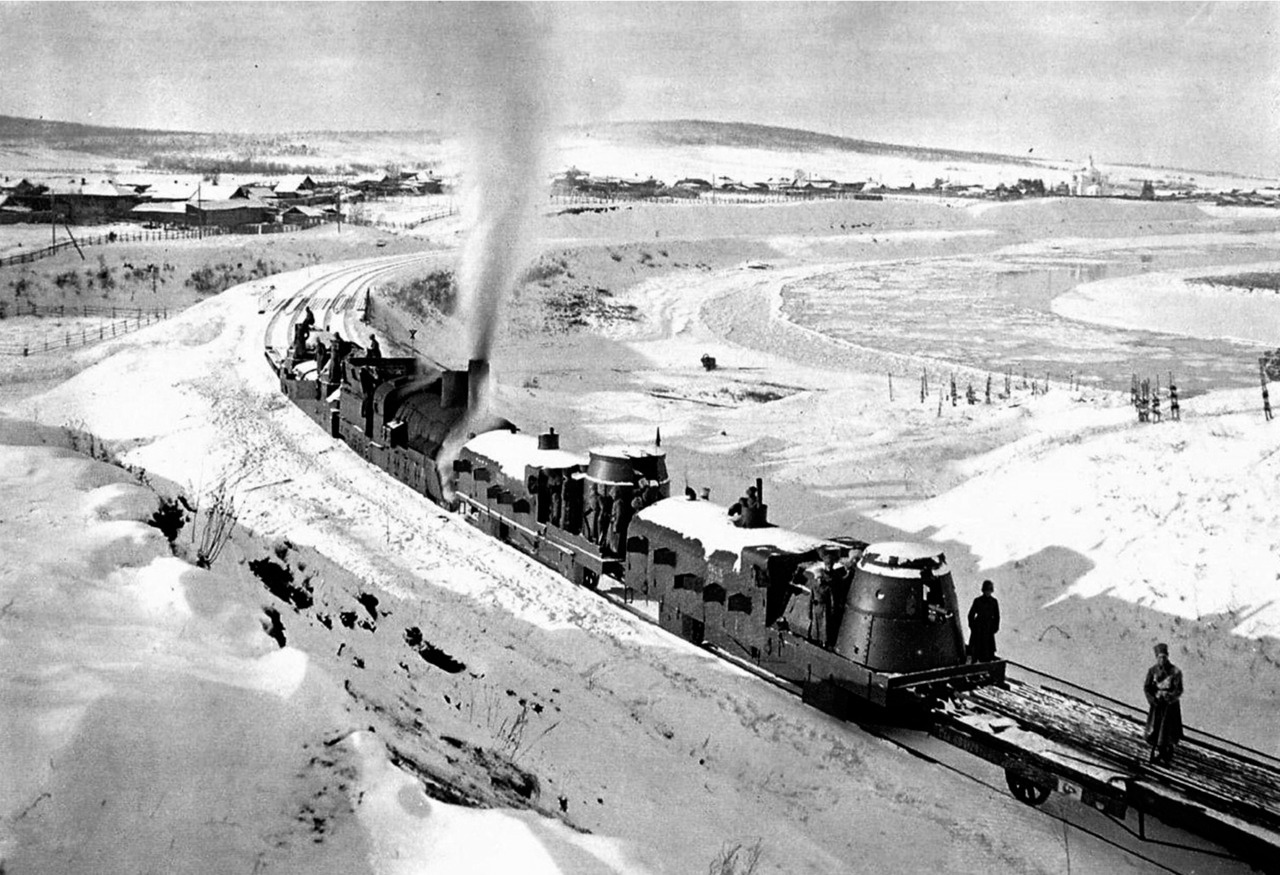
Primorsky Microdistrict
Further along the right side of Akademicheskaya Street, we pass the «Dom Kino» stop, where the East Siberian Newsreel Studio has been based since 1963 (Mukhinoy Str., 2A). Today it is the only venue in Irkutsk where you can see intellectual and auteur films on the screen, as well as meet directly with filmmakers. The storage funds contain more than 2 thousand film magazines «Eastern Siberia», about 400 documentaries, digitized and available to everyone.
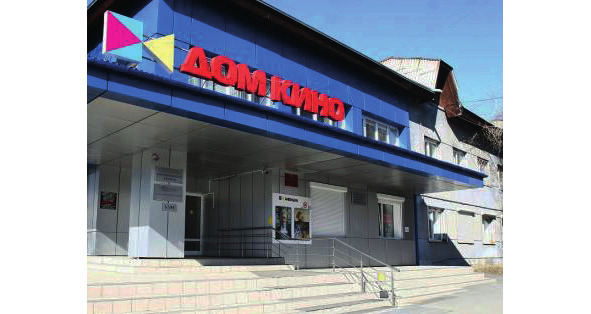
Below us on the right hand remains the microdistrict Yubileiniy, founded in 1967 and named in honor of the 50th anniversary of the October Revolution. Since 1986, the main attraction of this part of the city has been the Irkutsk Regional Clinical Hospital with a perinatal center and Orthodox parish in honor of the Nativity of John the Baptist (Yubileiniy mikrorayon, 100).
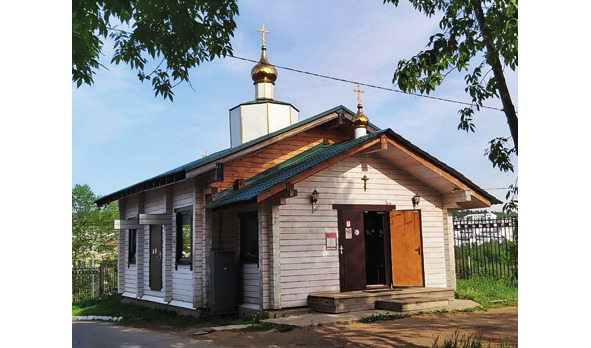
At the roundabout, we turn left onto Zakharova Street, which should lead us to the causer of the disappearance of the old Trans-Siberian Railway — the Irkutsk hydroelectric power station. In a small park on the right hand, one of the few churches on this bank of the Angara is hiding — the Church of Saint Alexander Nevsky, which was built in 2000 at the expense of the director and founder of the Folk Drama Theater M.G. Kornev (Yakobi Str., 3).
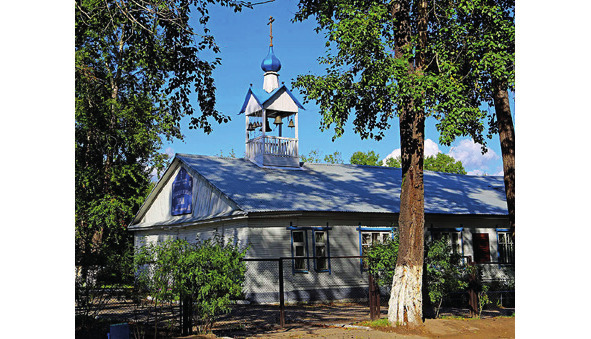
At the traffic light at the intersection with the street named after the Hero of Socialist Labor and the builder of the Irkutsk hydroelectric power station A.E. Bochkin, an alley goes up, planted by students of school number 64 in memory of the Great Victory. If you walk along it down to the Angara River, you can go to the only official beach in Irkutsk, named after the German physicist who made the first electric motor — B.S. Jacobi.
Before us appears the first serious hydroelectric power station in the history of Siberia. It is the least powerful (662.4 MW) in the most mighty hydropower complex in Russia — the Angarsk HPP cascade (Irkutskaya, Bratskaya, Ust-Ilimskaya, Boguchanskaya), whose total capacity is almost 12 thousand MW with an average annual output of 66 billion kWh (6% of the total consumption in the country). After the completion of the filling of the Irkutsk reservoir in 1959, the deepest (1642 m) and largest in terms of water volume (23,616 km3) reservoir in the world was formed. Perhaps that is why Irkutsk residents pay the least in Russia for 1 kW of energy (1.3 rubles for city dwellers and 0.91 for villagers).
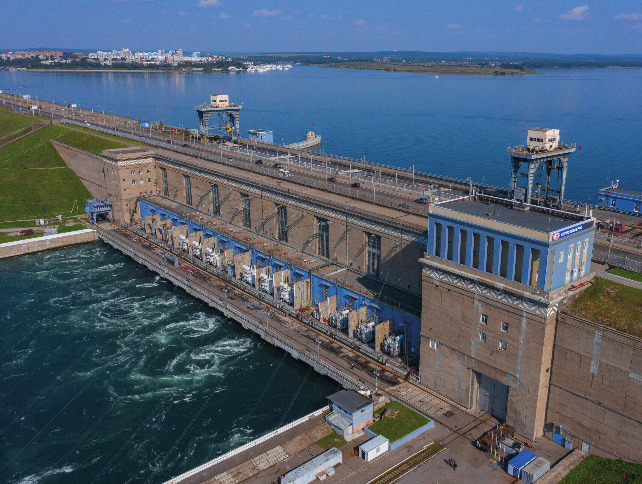
As a result of blocking the natural channel of the Angara River, the level of Baikal rose by 1.46 m, swallowing up all the islands between Irkutsk and the lake, as well as part of the Trans-Siberian Railway, for which a backup line had been built by that time. More than 200 settlements with 17 thousand people were in the flood zone.
On the right, at the en-trance to the dam, one of the three monuments to V.I. Lenin in Irkutsk, installed here in 1959 by the Moscow sculptor P.P. Yatsyno (author of the monument to the leader of the world proletariat at the park of Exhibition of Achievements of National Economy in Moscow). We will cross a dam along a 2.7 km long road, which is still unique for our country, because for the first time in world practice the construction was carried out from gravel and sand (almost 12 million m3), and the power plant building was combined with the body of the dam. From here, the main part of the water intake for the needs of the city is made.
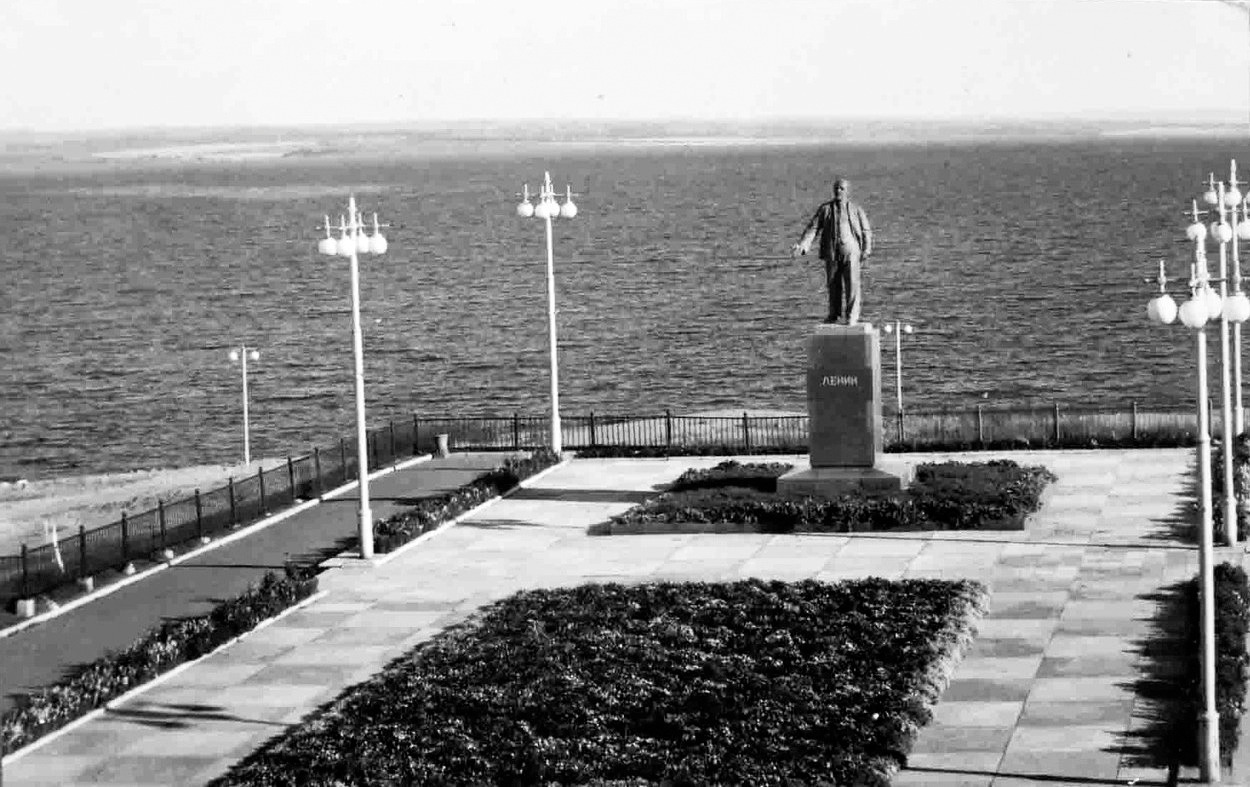
At the end of the dam, the oldest metal icebreaker in the world — «Angara», froze on a concrete bed (Marshala Zhukova Prosp., 36A/1). It appeared on this site as a museum in the perpetual parking in 1990. This ship made its first voyage back in 1900 and since then has carried passengers of the Trans-Siberian Railway, participated in combat battles during the Civil War in Russia, ran aground three times, five times sank. Despite this, the engines of English assembly are still in excellent condition, and the ship is able to return to navigation, which was interrupted in 1963 only for moral reasons.
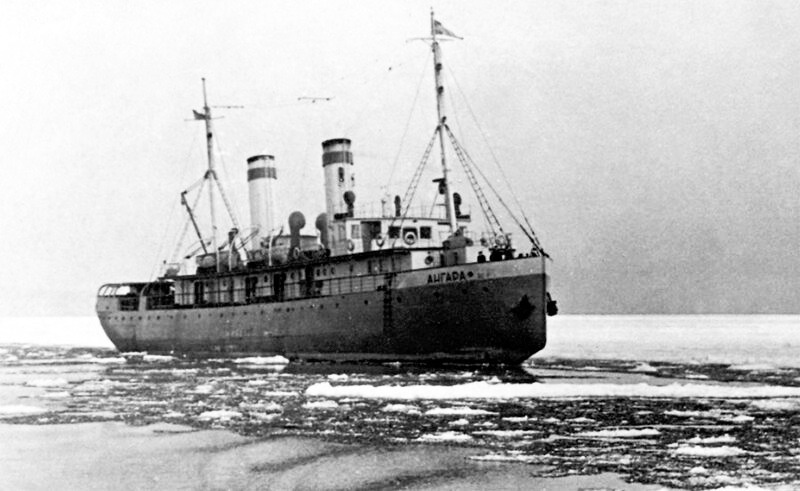
Solnechniy Microdistrict
Opposite the ship, across the road, you can see one of the youngest and most famous schools in Irkutsk — the experimental education center No. 47 (Marshala Zhukova Prospekt, 36), which has been operating since 1991. Nearby is the not less famous gymnasium No. 25 of Irkutsk city, built in 1982. In 2001, it was awarded the title «School of the Century» (Marshala Zhukova Prospekt, 2). Among its graduates, the composer D.G. Grigorutse, winner of the World Cup in sports aerobics E.N. Samozvanova, Doctor of Medical Sciences P.V. Seliverstov.
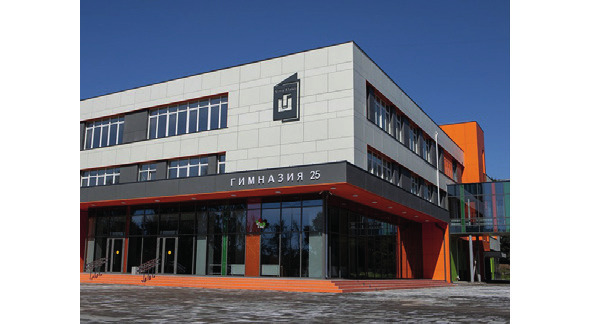
From here we begin our acquaintance with one of the youngest microdistricts of the city of Irkutsk — Solnechny. Let’s proceed to the shore of the Chertugeevsky Bay of the Angara River, where today the main pier of Irkutsk is located called «Rocketa» (Marshala Zhukova Prospekt, 98Г), which arose on this site in 1975 right on the outaskirt of the old village Malaya Razvodnaya flooded by the waters of the reservoir. Until 2017, from here it was possible to get to the northern tip of Lake Baikal in 12 hours, covering a distance of almost 600 km, using the «Kometa» hydrofoil motor ship. Here is also a yacht club of the European level — «Pearl of Baikal».
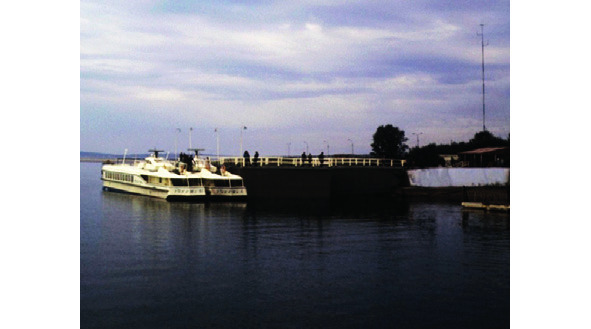
Through an ingenious road junction, we get to Marshal Zhukov Prospekt, where in 2005 to the four times Hero of the Soviet Union was built a monument by the most famous sculptor of Republic of Buryatia, A.M. Mironov. In 2002, when laying the foundation, a shell of a 76-mm whizbang was laid with an appeal to descendants, which is planned to be opened by the 100th anniversary of the Great Victory in 2045.
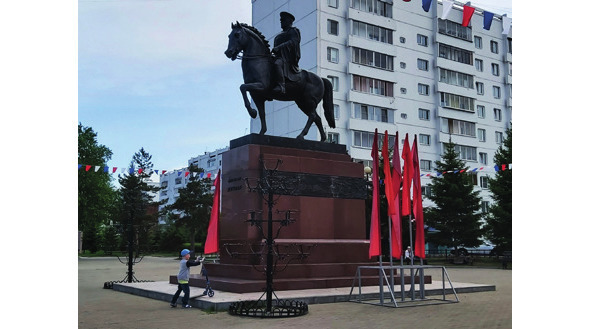
Directly from the monument begins the alley of military glory of Irkutsk with six monoliths, on which the contribution of the region to the defeat of fascism is described. At the end of the alley is the creation of V.A. Pavlov — a dormitory with a dental clinic No. 1 (Marshal Zhukov Prospekt, 70Б), built in 1983. The author himself gave more than 20 years to the capital of Eastern Siberia and is still among the 50 best architects of the 20th century according to the World Triennial of the International Union of Architects. On the other side of the avenue is another interesting project by V.A. Pavlov — «house-ship» (Marshal Zhukov Prospekt, 1), gallery type with an elevator shaft took outside the building, constructed in 1983.
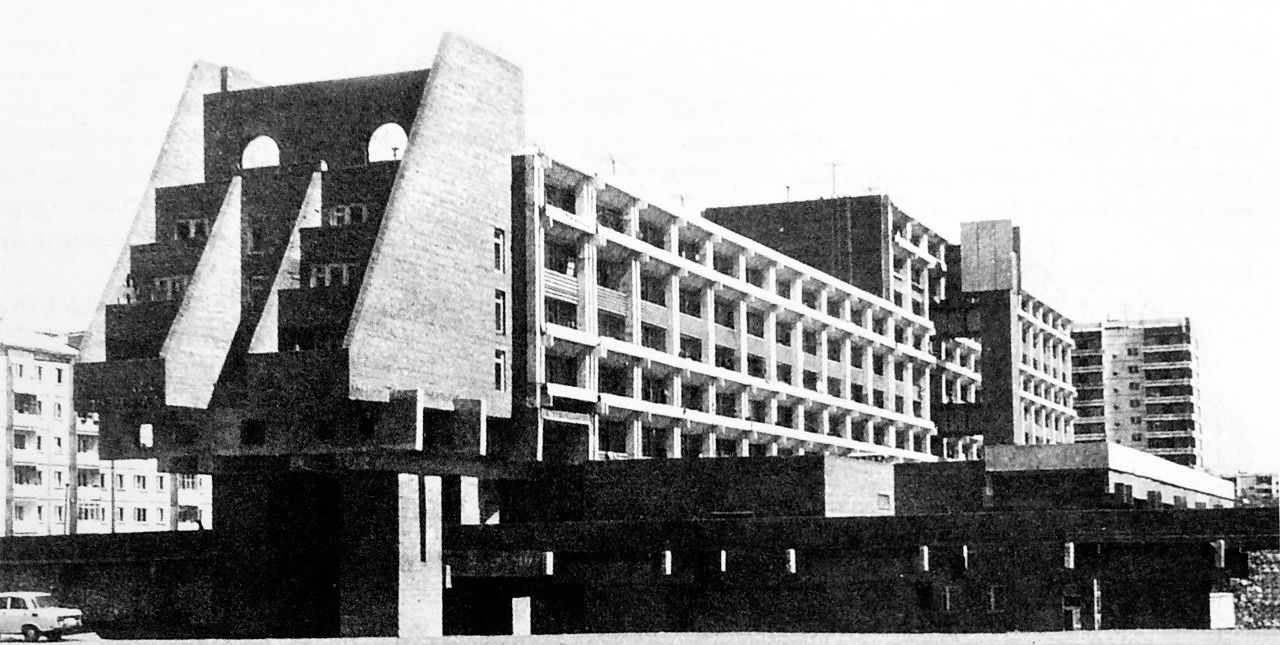
The history of the avenue itself is interesting, since until 1997 this street was called Karl-Marx-Stadt, after the Soviet name of the third largest city in the GDR — Chemnitz, which maintained twinning relations with Irkutsk from 1967 to 1999. It was German students who built this wide highway in 1974. In memory of twinning relations, the house of culture «Druzhba» (from the Russian druzhba — «friendship») appeared here.
Interestingly, on the site of the modern monument to G.K. Zhukov planned to install a copy of the bust of Karl Marx by the famous sculptor L.E. Kerbel surrounded by two thousand frost-resistant roses. From the side of the government of the Irkutsk region, only the installation of a pedestal and flower beds was required, however, the Soviet side did not fulfill its promise, unlike the German part, which sent the monument on time in 1987. The monument was never installed, and relations between the cities have since collapsed.
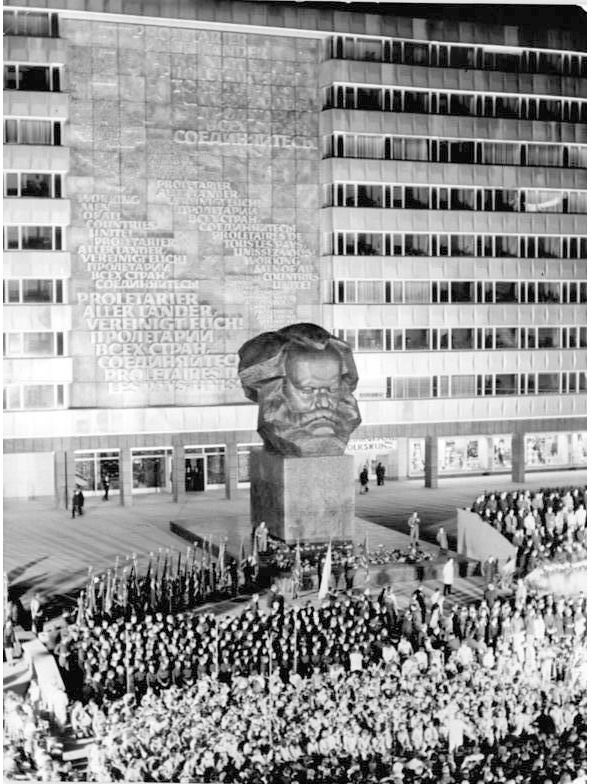
Under the viaduct we will go to the left along the street named after the world’s first Baikal scientist B.T. Dybovsky, who often visited Irkutsk in the period from 1868 to 1876. It will lead us to the building of the Solnechny water sports complex (Baikalskaya Str., 253/1), built here in 2015. Its area allows holding water sports competitions in accordance with Olympic standards.
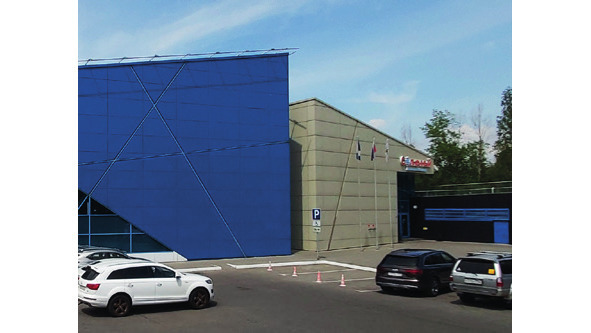
Next to it since 1996 is the main exhibition site of Irkutsk — «Sibexpocenter», as well as the ten-story building of the Baikal Business Center, designed by architect B.I. Kulikov and for a long time remained the best and highest business center of the city (Baikalskaya Str., 279).
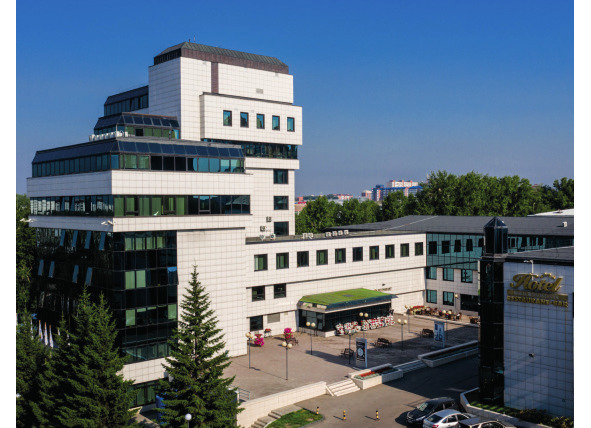
In this part, the Solnechny microdistrict is connected along Shiryamova Street with the territory of the Irkutsk International Airport, which was moved here in 1933 from the village of Bokovo (Shiryamova Street, 13). It consistently wins the title of «Best Airport of the Year in the CIS countries» (for the last time in 2017), despite the fact that it remains on the list of the most dangerous air harbors in Russia. During the years of its existence, 12 accidents with victims occurred here, in which 593 people died. For an inexplicable reason, most often they occur in July, when the airport celebrates its birthday. But once Irkutsk was a unique city, on the territory of which absolutely all the components of training, maintenance, production and design of both civil and military aviation were located.
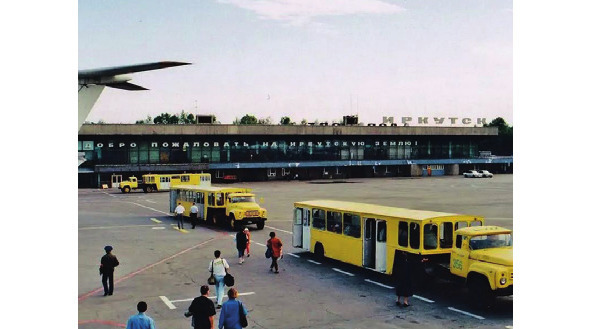
Next, we will go up by Deputatskaya Street past numerous educational institutions that have remained as a legacy from the Irkutsk State Agricultural Institute (Baikalskaya Str., 257). Hiding among the surrounding buildings are the Irkutsk branch of the Moscow State Technical University of Civil Aviation (Baikalskaya Str., 261A), the Training Center of Trade Unions (house 263), as well as the Irkutsk Technological College (house 255) and even the State Olympic Reserve School (house 267). For the latter, in 2012, the largest sports complex in Siberia and the Far East — «Baikal Arena», with a total area of more than 22,000 m2, was built in Solnechny (Baikalskaya Str., 267И).
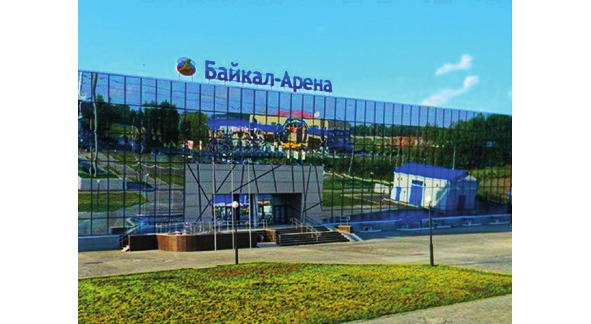
Having passed the Dry Brook and the Butakova Valley, between which the new buildings of the residential complex «Symbol» are squeezed, we leave the capital of Eastern Siberia. However, the city is in no hurry to end. It continues with a variety of low- and high-rise buildings. Having passed the «Green Land» cottage village, we will see one of the most unusual educational institutions in Siberia — the educational complex «Point of the Future» of 27 buildings, including a school, a kindergarten, sports facilities, a center for social and psychological support, as well as a cottage village for reception families (Baikalskaya Str., 374–408). At Chertugeevskaya Valley, about a thousand children are trained in the most comfortable conditions according to experimental programs. The complex was built in 2020 with private funds from the creator of the first wireless Internet in Russia, A.A. Avdolyan and with the support of the director of State Corporation «Rostec» S.V. Chemezov. The future elite of Russian society is trained here.
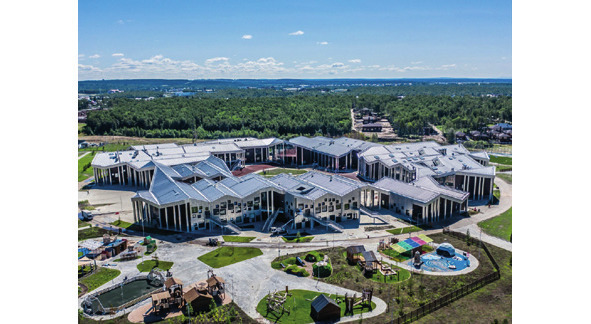
Baikal Tract
We are moving out for the Baikal tract, which is the beginning of the old Zamorsky or Amur tract, built back in 1733. It went through three postal stations (Patronovskaya, Taltsinskaya, Listvenichnaya) to the shore of Lake Baikal, from where the path continued to Transbaikalia and further to the Far East. On June 11, 1890, it was this route that A.P. Chekhov, on the way to Sakhalin, sharing his impressions with his relatives, he wrote the following: «The shores are picturesque… I was rode and for some reason I felt that I was unusually healthy; I felt so good that it’s impossible to describe… because the shore of the Angara River looks like Switzerland». Most of the old road went under water during the construction of a hydroelectric power station. However, in the area of the villages of Molodezhny (allotment «Pribrezhny») and Novolisikha (allotments «Irkutyanin», Sosnovaya Street), you can still see the forest belts left from the old tract.
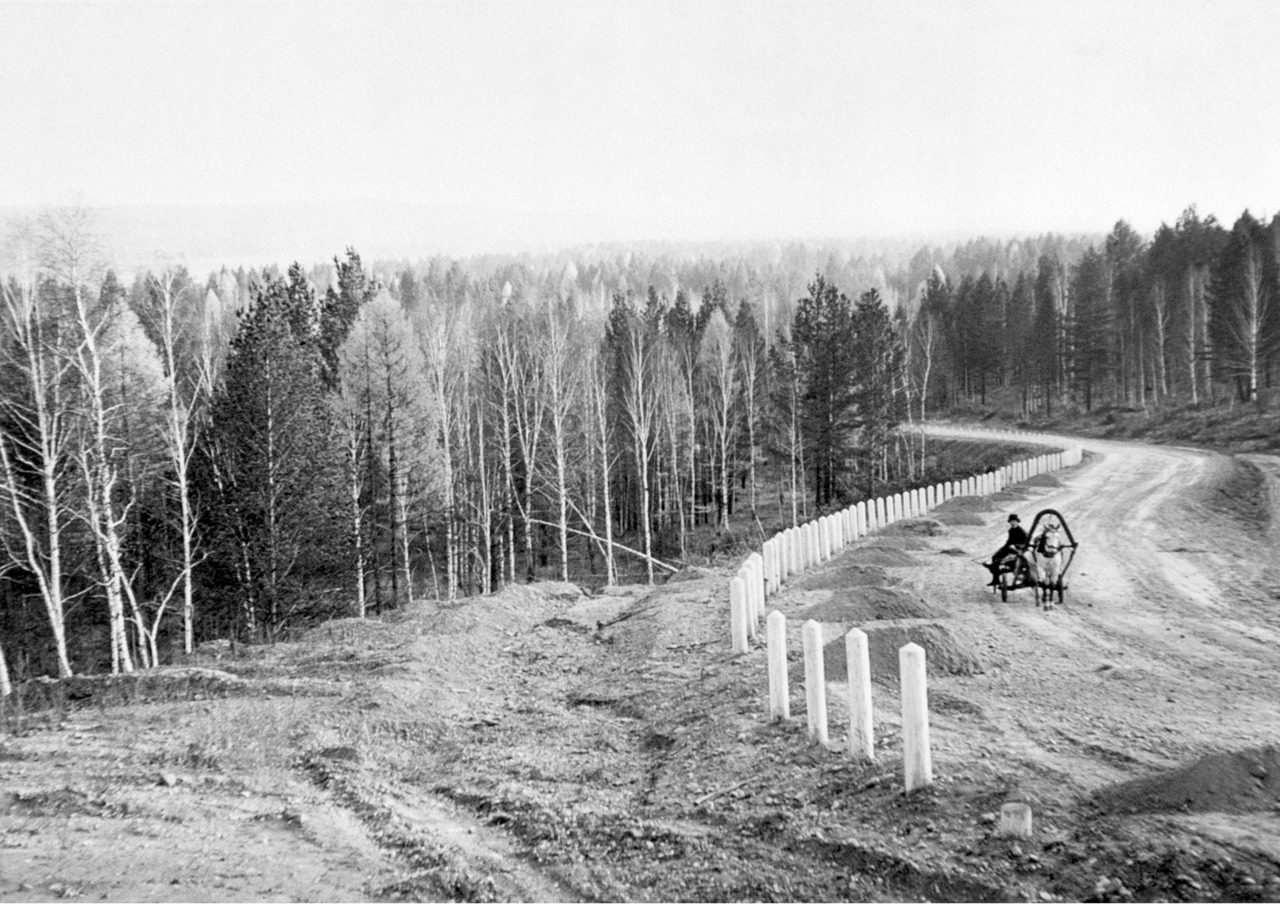
68 kilometers of the new and, probably, the shortest federal highway in Russia were built here in just four winter months from January to April 1960. The reason for the rush was the visit of the 34th US President D.D. Eisenhower, who chose Irkutsk as the first place to visit the USSR by old memory. Because, from March 1918 to November 1919 he worked in the capital of Eastern Siberia as a security guard at the US Consulate General, which was located in Perfilevsky lane, house No. 3 (now Pugacheva lane, the original building has been lost). Then in Irkutsk for 50 days, from November 14, 1919 to January 4, 1920, there was the last center of the Russian Empire, all its ministries and embassies of the countries participating in the intervention. On the eve of D.D. Eisenhower, rumors spread around the city about Vera (or Nastya) Baranova, who was the illegitimate daughter of the American president. Perhaps this was the main reason for his decision to revisit.
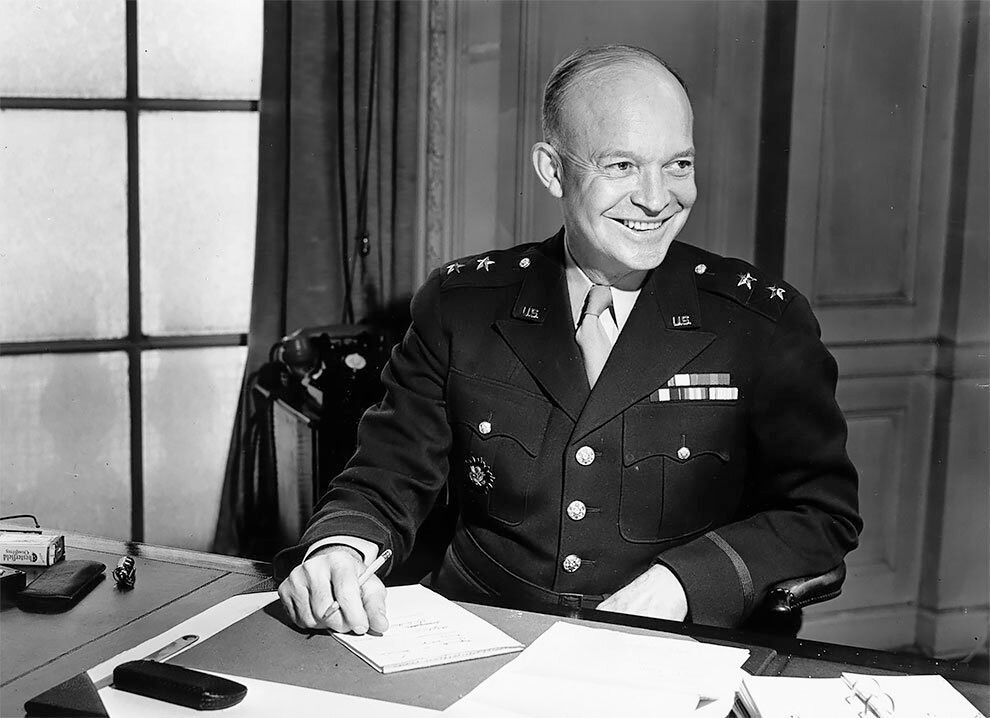
By the arrival of the American leader, there was a real commotion. First Secretary of the Irkutsk City Executive Committee N.S. Patrov had to prepare everything for the visit of the distinguished guest in record time, and after all, just recently the city lost its only short road to Lake Baikal, which completely disappeared under water a year earlier. It was impossible to conduct a reconnaissance of the area so quickly, but the plans for the construction of the Trans-Siberian Railway along the right bank of the Angara from Irkutsk to Listvenichny, created back in 1894, but never implemented due to a number of circumstances, came in handy.
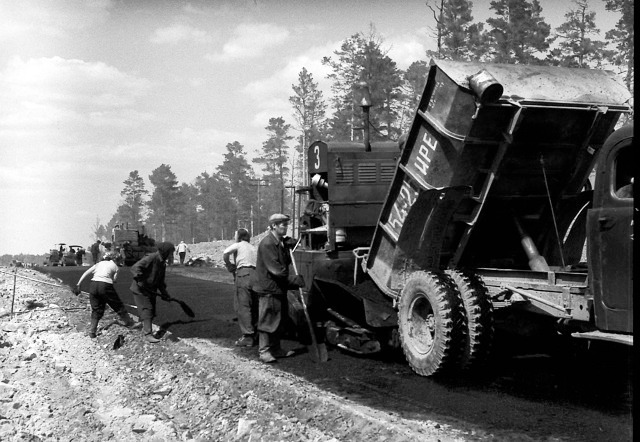
In addition, the chief Irkutsk architect N.A. Rumyantseva went to the trick to bring to the city for the visit of the American president a beautiful fountain, which was cast by a resident of the city of Kursk especially for his fellows. She phoned the sculptor’s apartment, and, introducing herself as the secretary of the Central Committee, ordered to transfer the fountain to Irkutsk. On the same day, the documents were drawn up, and the fountain was sent by rail to the capital of Eastern Siberia — much to the surprise and delight of the regional authorities. Since then, it has been flaunting on the main plaza of Irkutsk — the S.M. Kirov Square. Also, a hostel for employees of the state university was resettled in the city and rebuilt for the needs of the high embassy. Several comfortable motor ships («Babushkin» and «Irkutsk») were brought to Baikal, as well as the fourth in the history of the USSR ultra-modern hydrofoil ship «Rocketa-4».
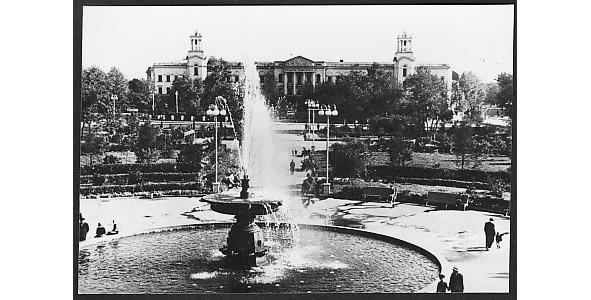
But, despite all the preparations, the visit was never destined to come true. Since just a week before it, on May 1, 1960, an American Lockheed U-2 high-altitude reconnaissance aircraft took off over Afghanistan in Peshawar. It flew over the territory of half of the Soviet Union and was shot down by a rocket near Sverdlovsk (modern Ekaterinburg). On board was a spy named F.G. Powers, whom USSR exchanged years later in Berlin on the Glienicke bridge for the Soviet agent V.G. Fisher. After this incident, there could be no talk of a friendly visit. However, despite the failed trip, the gradual development of tourism began on Baikal. Ironically, the next world leader to visit these places was Eisenhower’s worst enemy — communist Cuban leader F.A. Castro (on May 11–12, 1963).
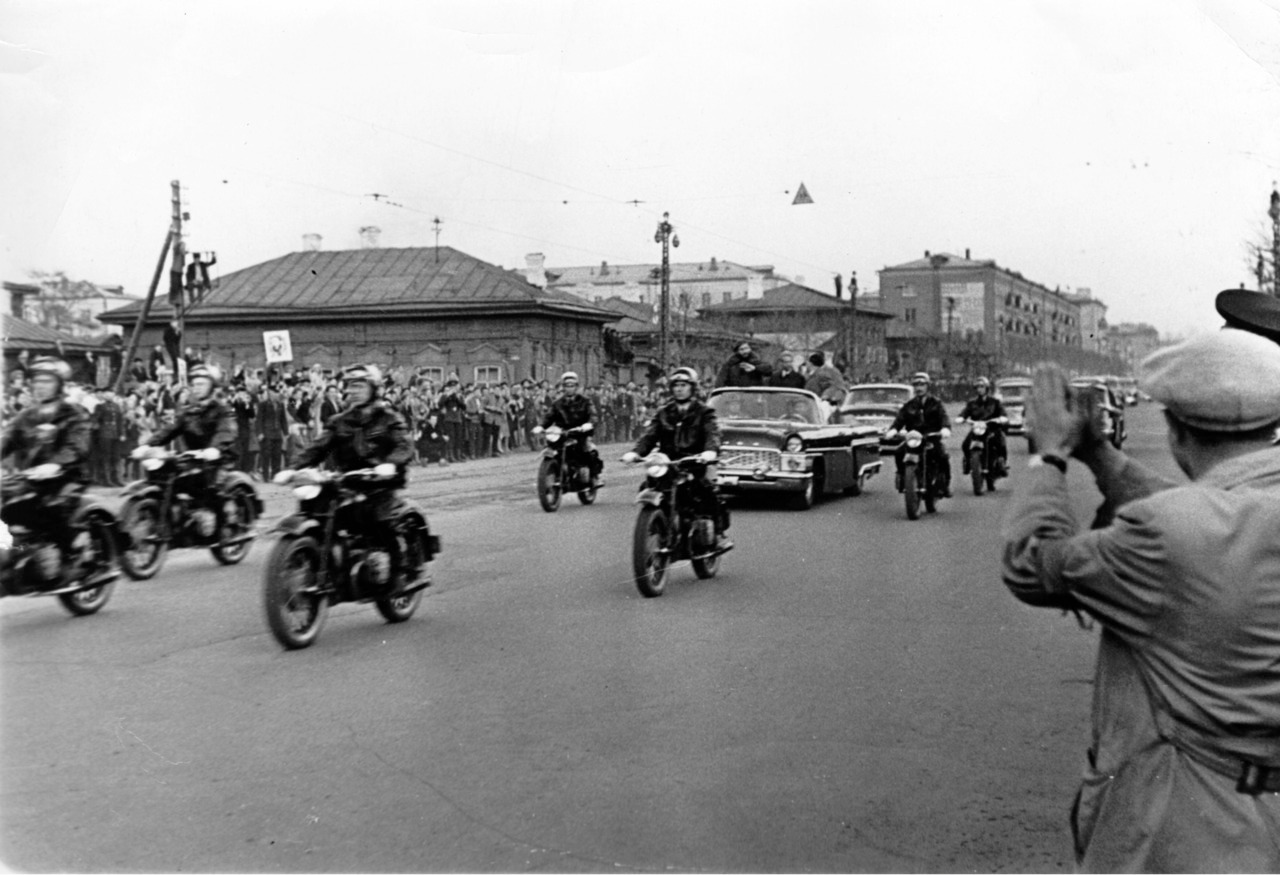
Moving further along the Baikal tract, we run into a village with the mysterious name «New Razvodnaya». In fact, below its present location there were two villages — Malaya and Bolshaya Razvodnaya, founded in 1674 by settlers from Moscow, Petrushka Grigoriev and Grishka Pavlov. During the construction of the Irkutsk hydroelectric power station, these villages were the first to disappear under water, already in 1957 at a depth of about 16 m. 130 km of auto-drawn roads and 58 km of the Trans-Siberian railway with Mikhalevo station and 6 passing loops. The water went deep into the coast in some places up to 150 meters, about 138.6 thousand hectares of land, 127 settlements, including 9 urban ones, fell into the flood zone. 3.3 thousand households were resettled, where more than 17 thousand people lived.
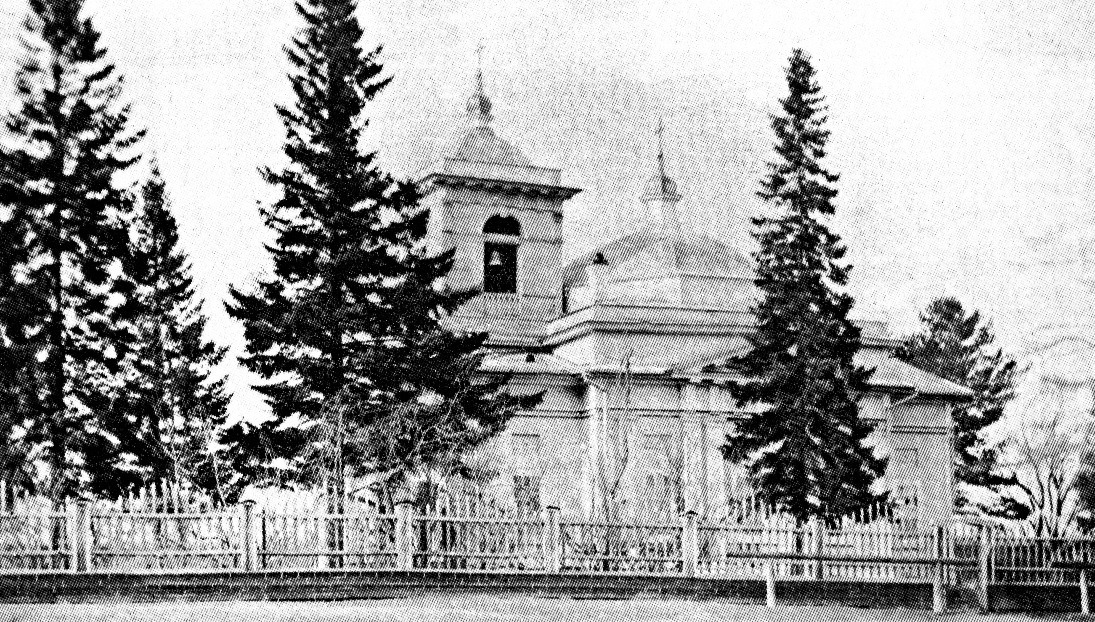
But once it was in these prosperous villages lived in the settlement many of the first Russian revolutioners (Decembrists from rebellion on 26 December, 1825). In 1839–1841 one of the initiators of the 1825 uprising was sent to Bolshaya Razvodnaya, the one who was originally among the 30 sentenced to death — A.I. Yakubovich. In a neighboring village, he founded a small school for children and opened a soap factory. In 1842–1848. one of the two officers who did not leave the Senate Square in Saint-Petersburg on a day of Rebellion, also initially sentenced to death, moved to Malaya Razvodnaya from Khomutovo near to Irkutsk — Lieutenant of the Life Guards A.N. Sutgof. Both of them then moved from Irkutsk land.
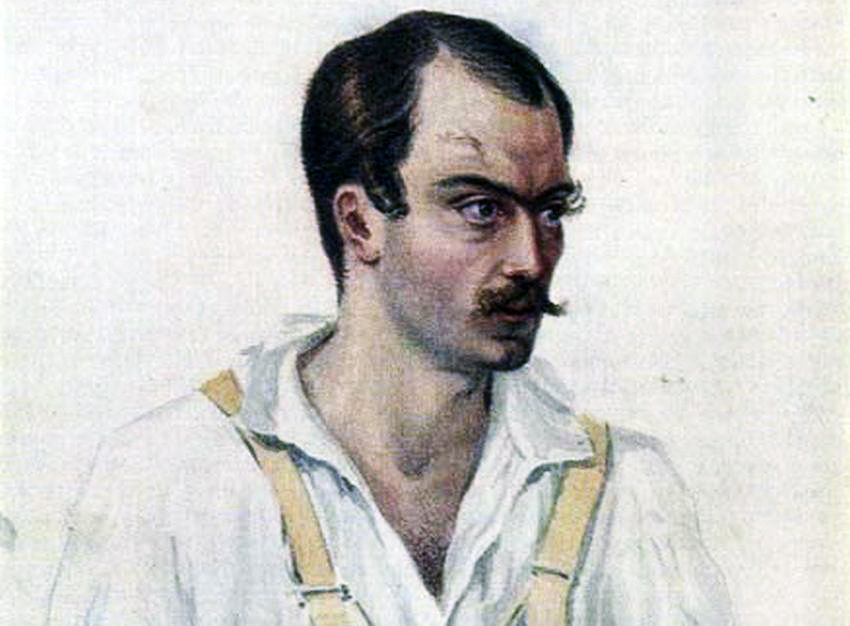
At the end of the 17th century, a chapel in the name of the Holy Apostles Peter and Paul appeared in Bolshaya Razvodnaya, which was rebuilt in 1740. In 1842, instead of a dilapidated church, a new church was constructed in 100 sazhens (a native system of measures in old Russia about 2.13 m) from its former place. But it was closed in the late 1920s. A children’s home, a radio center and a stable were placed inside, and in 1956 it was dismantled. Many of the Decembrists rested at the cemetery next to the church.
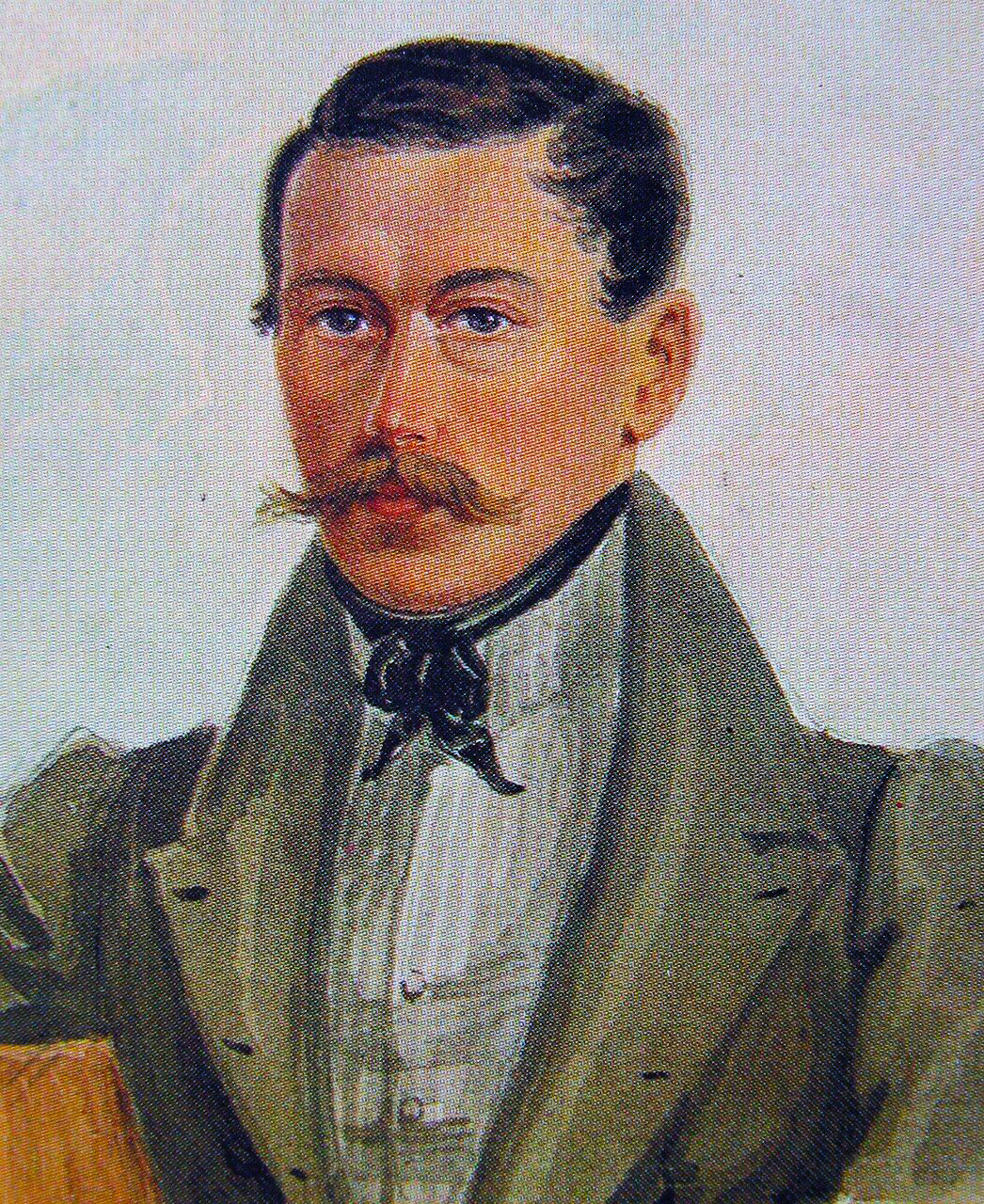
The first who arrived in the neighboring Malaya Razvodnaya in 1840 was the colonel of the Akhtyrsky hussar regiment and the hero of the war with Napoleon A.Z. Muravyov, who lived here until his death in 1846. In 1840, one of the six generals of the participants in the Decembrist uprising and a fighter for the freedom of Bessarabia A.P. Yushnevsky moved here from Kuzmikha. After his sudden death at the funeral of the Decembrist F.F. Vadkovsky in 1844, his wife M.K. Yushnevskaya had to wait until 1855 to leave Siberia.
The remains of officers with grave monuments in 1952 were transported to Irkutsk to the Lisikhinsky cemetery, although part of the churchyard was preserved in the area of the first enduro park for motorcyclists at Chertugeevsky Peninsula. Interestingly, inside the gravestone of A.Z. Muravyov found an immured bust of one of his sons who died early — N.A. Muravyov, which is now kept in the collection of the museum-estate of S.P. Trubetskoy in Irkutsk.
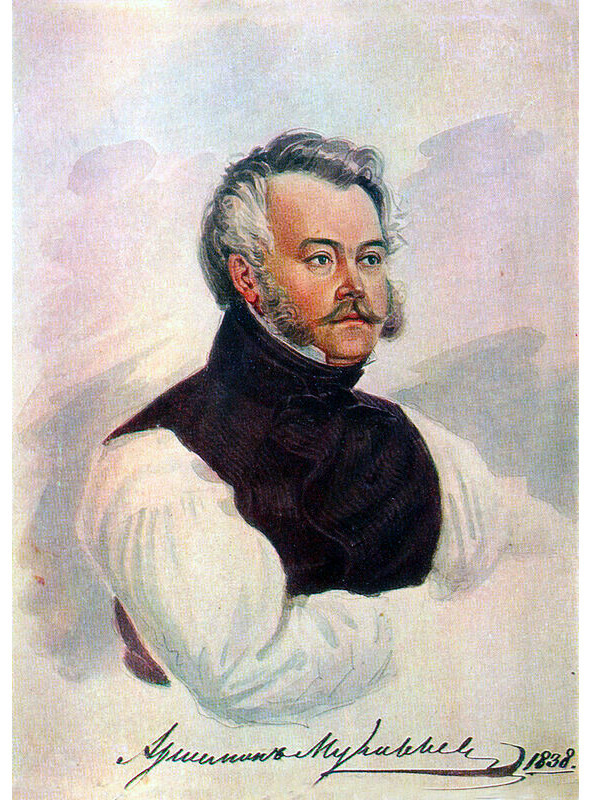
Less fortunate were the Decembrist brothers A.I. and P.I. Borisov. Both of them stood at the origins of the Southern Society and were part of the «cohort of the doomed» (regicides), for which they were sentenced to the 1st category. The elder brother, Andrey, lost his mind in the Peter and Paul Fortress in Saint-Petersburg and remained in the arms of the youngest — Peter, who became a brilliant watercolor artist and scientist, leaving a heritage of more than 670 drawings. During their life in Malaya Razvodnaya in 1841–1854 they brought up many local merchant’s children, creating on the basis of the school of A.I. Yakubovich, a plant nursery and a school for young naturalists. Unfortunately, on the day of the death of his brother A.I. Borisov committed suicide, after which both according to ancient orthodox custom were buried behind the church fence and their graves were not preserved.
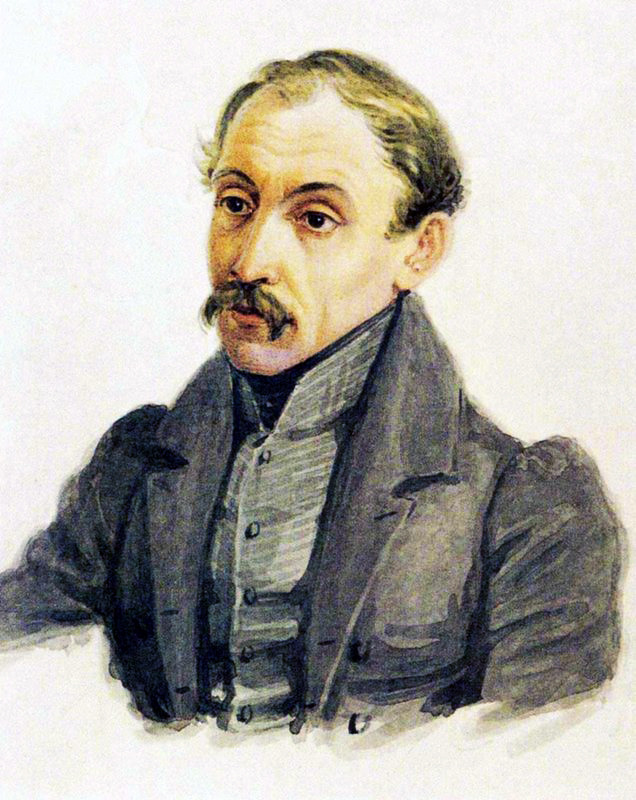
Opposite Bolshaya Razvodnaya, which stretched for almost 3 versts (an obsolete Russian unit of length defined as 500 sazhen equal to 1.06 km) along the Angara, on the other side, bypassing the islands of Brodny and Ershovsky, there was the village of Ershi, founded no later than 1806. Previously, there was a train checkpoint of the same name with a passing loop (20 km from Innokentievskaya station). Today there is a bay here, where in 1965 the most famous boat station in the vicinity of Irkutsk was opened. Since 1976, one of the two water supply networks in Irkutsk has been operating here, a ski slope and a forest nursery, familiar to all Irkutsk residents, since it is from here that New Year trees are most often brought.
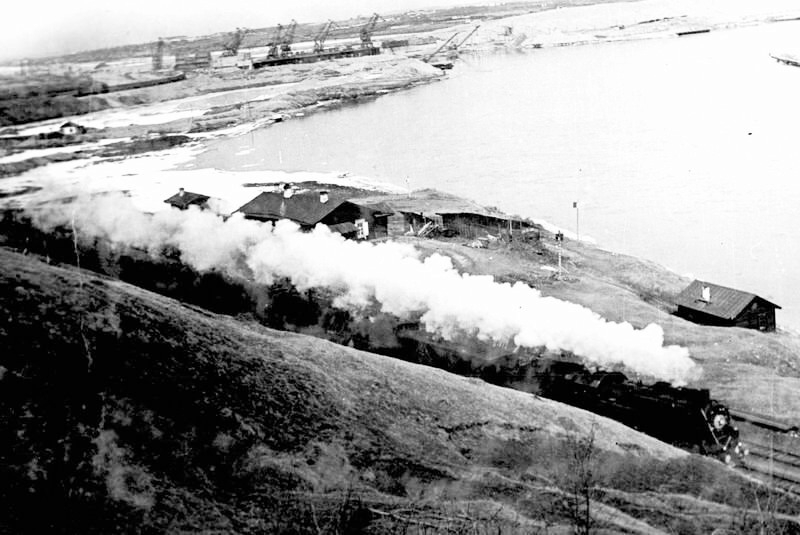
We will continue moving further along the Baikal tract. Behind the Dyachkovo Valley, we are met by the next village on our way — Molodyozhny. It was formed in 1956 on the basis of migrants from flooded settlements along the Angara River, and also due to the transfer of the Agricultural Academy from the center of Irkutsk. In 1964, students began to be moved here. In parallel, with the help of the latter, the town was being built up: houses for employees, dormitories, a boiler room, laboratories, vegetable stores and warehouses appeared. Since its establishment in 1934, the Agricultural Academy has trained more than 30,000 specialists who work in all countries of the former USSR. In 1992, on the basis of the village, an association of homeowners was formed, which soon turned into a kind of Moscow «Rublyovka». Today, more than 7 thousand people live in the formed cottage settlement.
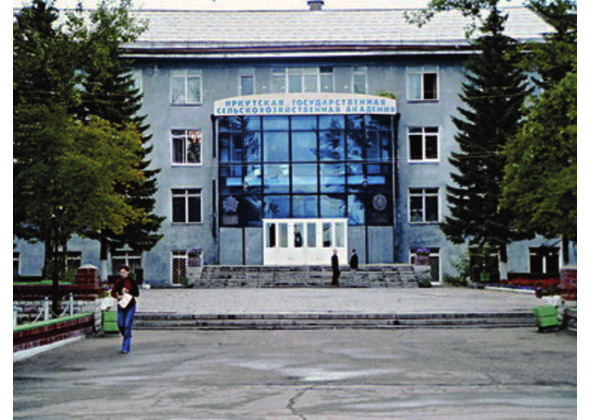
At the entrance to the village, on the right in front of the junction, a brand new school is visible, which appeared here in 2018. Down to the Angara, the road to the main building of the Irkutsk State Agrarian University named after A.A. Yezhevsky (ISAU), as well as to the ski track, known to all participants in the competition «Ski Run of Russia», which is held annually here.
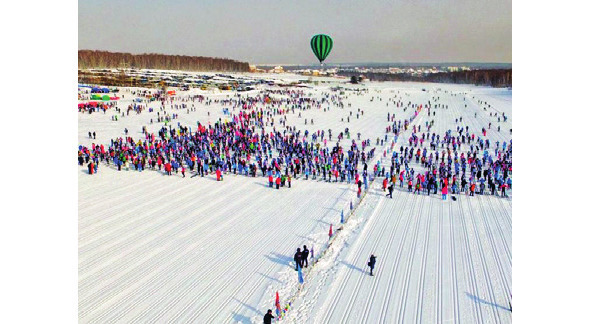
Shopping and entertainment centers stretch along the road. Two restaurants especially stand out, stylized as old buildings: «Melnik» and «Rytsarskiy Dvor». Opposite the latter, on the other side of the road, at the very top of the Uskov Valley, in a lonely and completely unmarked glade, 6109 people from the nearby flooded villages along the Angara River were buried. These are not the only burials that are located in this forest, which is closely adjacent to the runway of the Irkutsk airport.
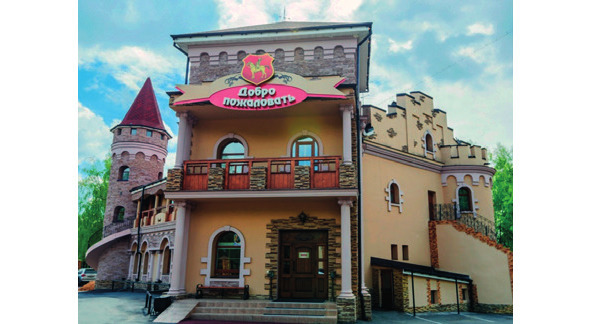
Among the people, this place received the ominous name «Cottage of the Moon King.» The fact is that in 1874–1890 until his death here lived the former agent of the Polish Central Committee in Saint Petersburg — Y.P. Ogryzko, who was sentenced to permanent settlement in Siberia. He almost completely lost his vision during the Vilyui exile and could only walk on moonlit nights, for what he received his nickname. Only the ruins near the runway at the edge of the forest remind of the place of his residence. Next to them in a small meadow in 1992, a memorial «Wall of Sorrow» was set, dedicated to the J.V. Stalin’s repressions of 1937–1938. In those terrible years, a special zone of the People’s Commissariat for Internal Affairs in the Irkutsk region was allocated in this forest area for the burial places of the executed, where, according to various data, from 7 to 23 thousand people were buried in storage ditches. Only from one of the burial grounds in 1989 were seized the remains of 304 people with traces of violent death. On the memorial you can find the name and photo of the great-grandfather of the author of this book, V.V. Zhuk, who perished in the dungeons of the North-Eastern Corrective Labor Camps («Sevvostlag») in 1942 on Magadan city.
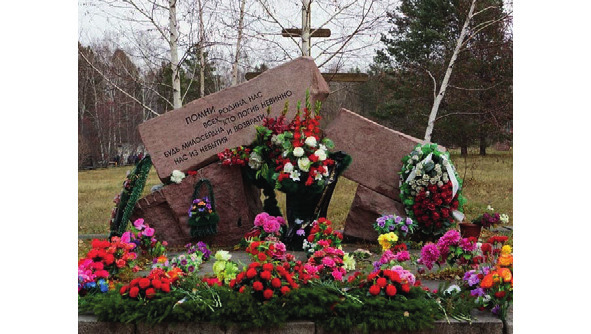
Then we cross the Krutoy Klyuch Valley and climb the hill, where the next village called Novolisikha is located (population 1098). The name is due to the fact that in the past there was a subsidiary farm of the Lisikhinsky brick factory from the city canteen trust, which was engaged in rabbit breeding and growing vegetables. Today, only the nursery of berry and vegetable crops, which has been operating here since 1947, reminds of this. During this time, more than 700 plant varieties have been studied. The fields for the garden were created by Japanese prisoners of war.
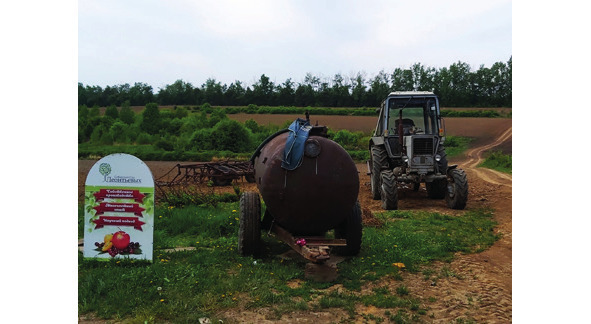
In the past, as now, the Baikal tract climbed steeply uphill at this place and then descended directly to the Shchuchy Bay, which was named so not at all for the abundance of predatory fish (from the Russian «Shchuka» — pike) that dwells here to this day, but because in 1669 a certain Grigory Shchukin settled here. Before the construction of the hydroelectric power station, it was a vast village with a school, club, dairy, pig and poultry farms. Today, only the eponymous of local country gardening reminds of the village, which is closest to the flooded settlement.
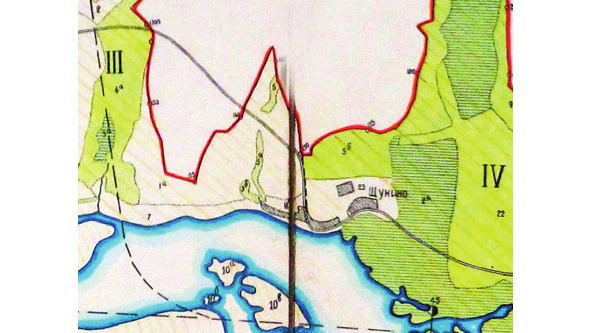
Having passed the Volchya Valley with the stream of the same name, we find ourselves at the Uzkaya Valley, in which, since 1967, under the cover of the forest, the satellite antenna TNA-57 has been based (Baikal tract 20 km, 1). The same one with which the central television program was broadcast to the whole of Eastern Siberia via the Orbita-3 system from the Ostankino television center. Thanks to it the people of Irkutsk, ten years after the appearance of the television tower, were able to receive a signal from Moscow.
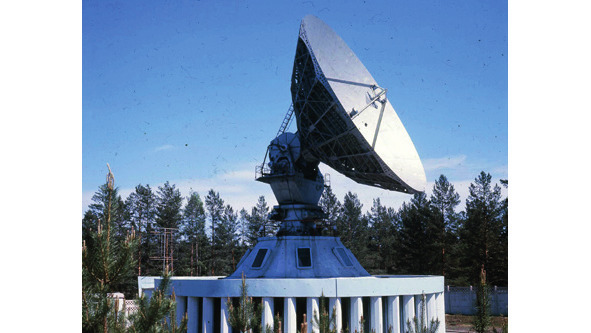
It is interesting that in the neighboring village of Patrony there is a receiving radio station No. 2 (Garazhnaya Str., 1), which used to be engaged in trunk communications from Moscow to Kamchatka, as well as a complex magnetic-ionospheric observatory of the Irkutsk Institute of Solar-Terrestrial Physics, which continues to work, started back in 1887 in Irkutsk by the first such laboratory. The choice fell on this place not by chance. They are far away from the rest of the radar stations of the capital of Eastern Siberia and thus are able to avoid interference from other signals. In Soviet times, this is where the secret «mailbox No. 194» was located.
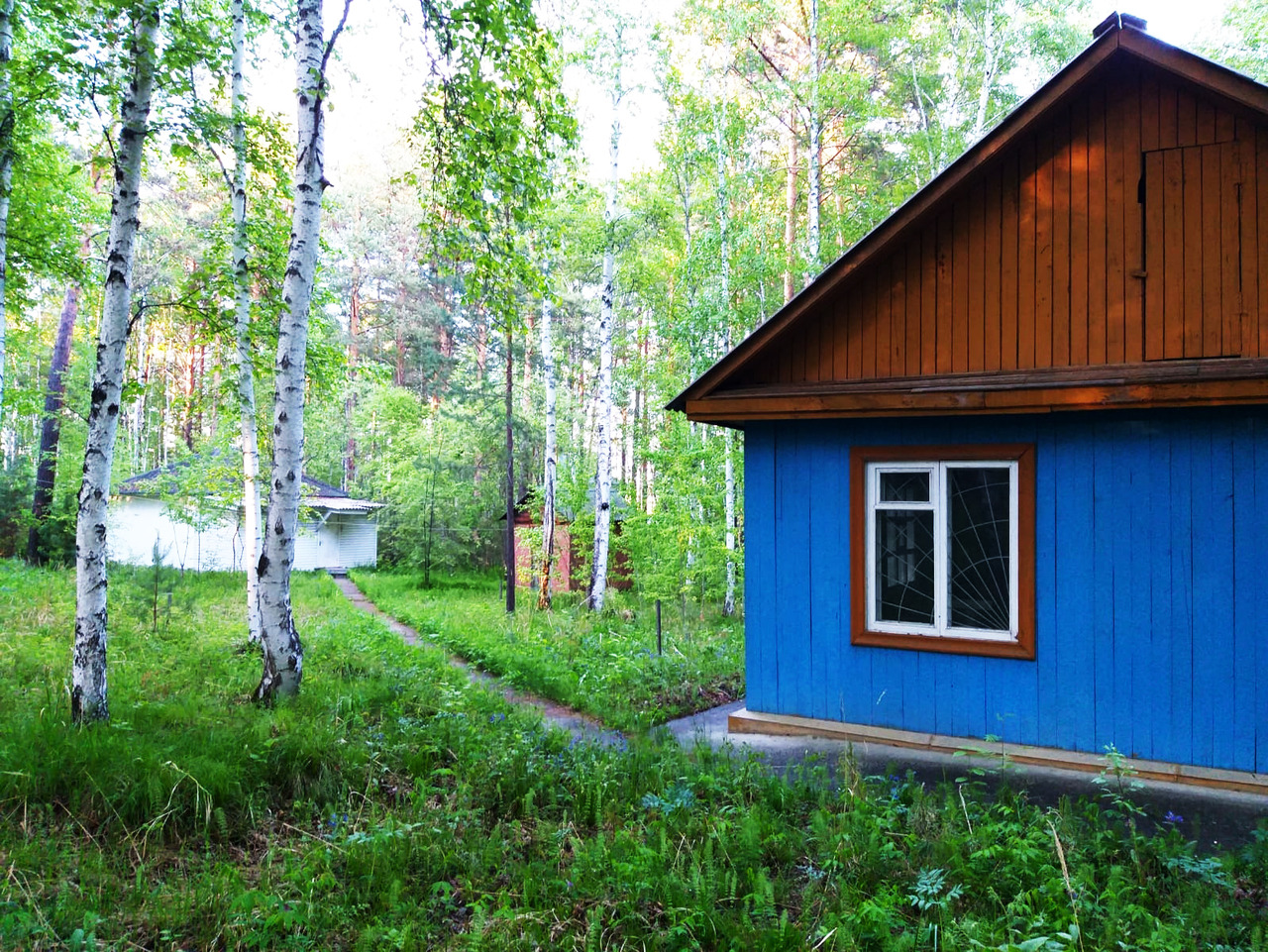
Today, no one can remember what the name of the village is connected with. Someone is talking about robbers who robbed caravans with Chinese goods going along the Baikal Tract. Some remember the names of the old-timers — Patron. Others even argue that everything is connected with the barracks and the arsenal that were here. It is only known for certain that one of the three original postal stations on the way to Baikal was located here. Most likely, the village arose in the 1730s.
The settlement itself was quite small and was located exactly at the exit from the modern Eloviy Bay. Only two moved houses remained from it along Naberezhnaya Street, as well as the old barracks built in 1938, where many people were resettled after the flood. Today, along the shores of the bay, there are the camping hotels «Baikal-21» and «Yolochka», the children’s sanatorium «Elovaya Pad» and the former regional committee summer residences, where today the training center of the Central Internal Affairs Directorate for the Irkutsk Region is located. In addition, this is the widest place of the Irkutsk reservoir on the way to Baikal. The distance along the line from the extreme point of the Eloviy Bay to Kurminsky Bay is more than 18 km.
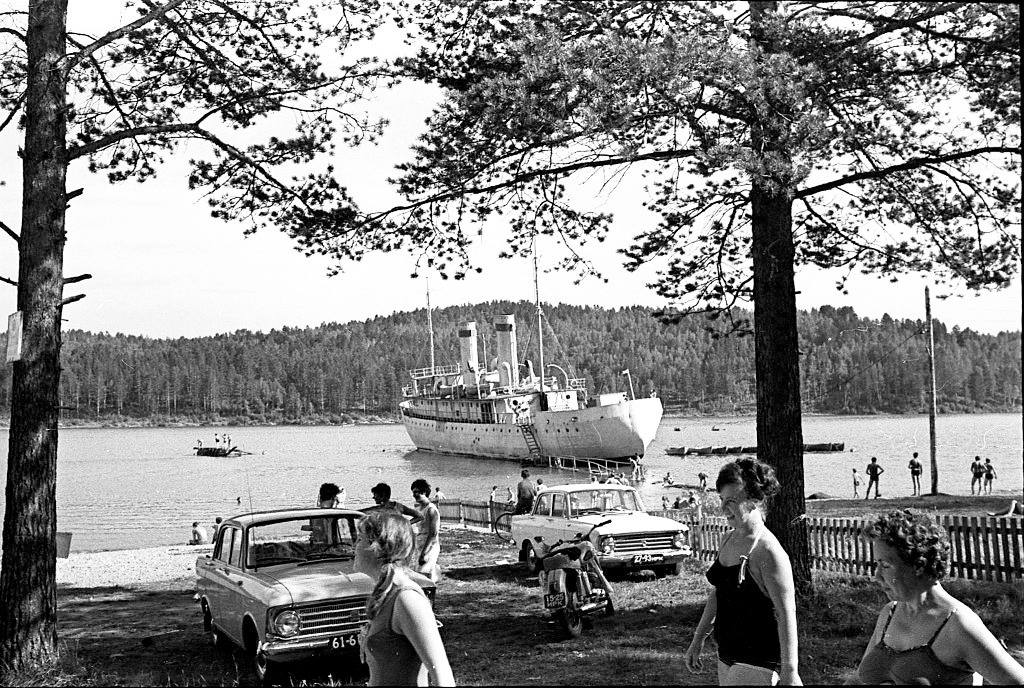
Once the postal station Patroninskaya was connected by a ferriage with the village of Grudinino, which was located on one of the three largest islands on the way to Baikal. Having appeared at the end of the 17th century as a place for fishing, it was considered the most picturesque of the villages on the upper Angara.
Subsequently, the first shipyards near Irkutsk appeared here, and in 1843 the oldest steamship in Siberia, the Emperor Nicholas I, was built. In 1884, a chapel with an altar was built in the village, later reconsecrated into a church in the name of Michael the Archangel. Despite the fact that the island was annually suffered from winter floods, and it actually had no connection with the railway passing by, people refused to leave their native place during the cleaning of the bed of the future reservoir. Perhaps it was Grudinino that became the prototype of the settlement in V.G. Rasputin «Farewell to Matyora» Many famous Irkutsk citizens were born here. Doctor of Geological and Mineralogical Sciences and Leading Researcher of the Institute of the Earth’s Crust SB RAS M.I. Grudinin dedicated two books to this village: «My Memoirs» and «The Island of My Childhood.»
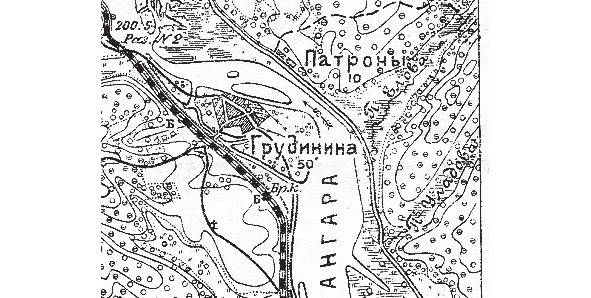
Today, the island disappeared at a depth of 18 meters in the waters of the Angara River, and its inhabitants settled on housing in the villages of Melnichnaya Pad and Novogrudinina. The remains of the first settlers were reburied from the cemetery already in 1950 near the southern slope of the Kortokoi valley. As well as the bones of the inhabitants of the village of Mikhalevo, which was located at the end of this peninsula. The latter was founded by the Cossack chieftan and the first Siberian ore explorer Anisim Mikhalev back in 1681. He found the first mica, a «grass stone» (jade) and a «pure pencil» (graphite) on Baikal.
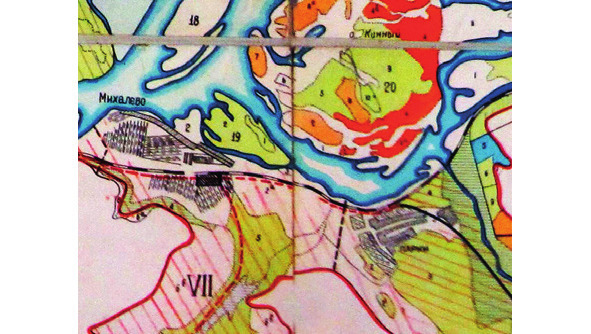
Interestingly, this place has been inhabited since Paleolithic times. Since time immemorial, there has been access to the richest hunting grounds through the Dabat River (from the buryat language dabaan — «mountain pass») up to the upper reaches of the Olkha River, as well as logging facilities, where in Soviet times more than 300 thousand cubic meters of timber were harvested annually. Therefore, here were located the only railway station of the IV class on 7 tracks (Mikhalevo, 32 km from the Innokentievskaya station) and two brick factories on the way from Irkutsk to Baikal. Two iron bridges 21 and 43 m long, respectively, were thrown across the Kaley and Kurma rivers. The arrival of the Trans-Siberian Railway here led to a doubling of the population of the village and the creating of the neighboring village of Parky, where Kurminsky Bay is now located. By the way, on its shore in Ugolniy Bay today there are several houses transferred from the village of Mikhalevo.
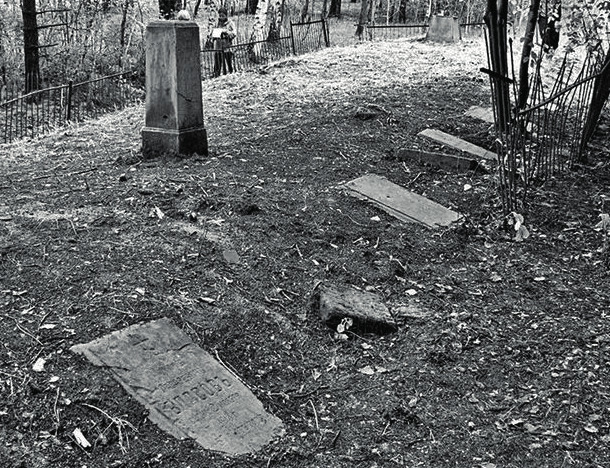
Since 1903, summer military camps of the 7th East Siberian Rifle Division have also been located in the area of the village of Parky on the banks of the Kurma River. Under them, in 1911, the Peter and Paul Church was built, which in 1918 was dismantled and transported to Irkutsk to the Glazkovo market, in connection with the transfer of the barracks to a new location. The 28th East Siberian Rifle Regiment, which was part of the mentioned division, headed by the illustrious Lieutenant General R.I. Kondratenko, during the Russo-Japanese War carried the 159-day defense of Port Arthur. Only after the death of this commander, the fortress was surrendered. The Russians destroyed 112 thousand Japanese, while losing 27 thousand killed, and also fettered the advance of the enemy army of more than 200 thousand people. Despite unbroken resistance, the citadel was given to the enemy along with the soldiers, which became one of the greatest shames in the history of the Russian army and one of the reasons for the first Russian revolution of 1905.
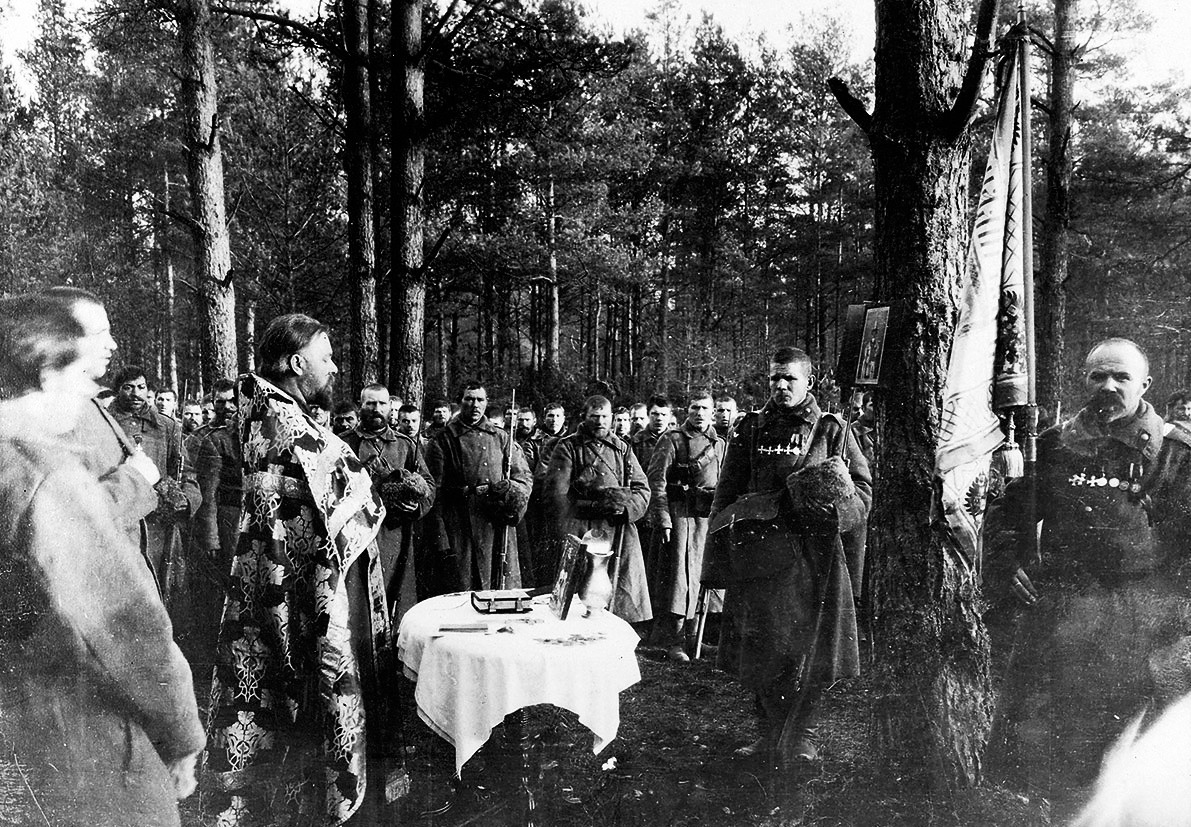
We return to the Baikal tract and climb from the Eloviy Bay to Mount Dolganikha. At the top, turn left to the abandoned position of the S-75 air defense system of military unit No. 92712. These places have been inhabited for centuries. Shortly before the arrival of the «big water» in 1957, archaeological excavations were carried out here. The participants of the expedition were such prominent researchers as A.P. Okladnikov, N.A. Kozyrev and L.N. Gumilyov. They discovered a number of ancient sites from the Mesolithic to the Iron Age.
Climbing the next mountain Uladova, let’s not forget to stop at the source with the сiborium, consecrated in 2005 by the rector of the church in the village of Bolshaya Rechka, Priest Alexander in honor of the icon of the Kazan Mother of God. It is interesting that down the valley on the bank of the Angara River there is another outlet of medical sodium chloride water of the Minsk type with a mineralization of 6–7 g / l, on the territory of the abandoned sanatorium «Zeleny Mys», founded by the Russian geological exploration company «Sosnovgeologiya» in the late 1960s. Until 2008, it was a very popular holiday destination, which today is in disrepair.
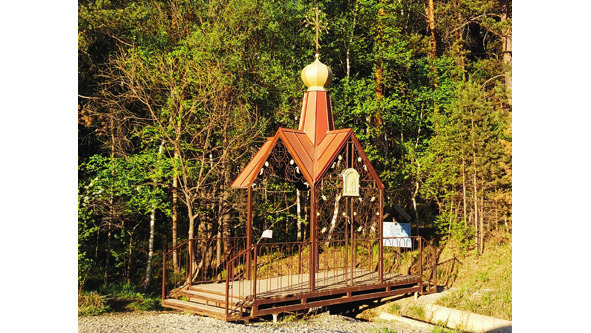
Among the numerous gardens located on this hill, on the right bank of the Korolok River in the taiga, 4 km from the highway, lies the old village of Lebedinka, founded at the beginning of the 20th century by settlers from Belarus. Here in 1929–1939 lived the famous intelligence officer and Hero of the Soviet Union D.K. Lytin, after whom one of the main streets of the village of Bolshaya Rechka is named. An old cemetery has been preserved in the village. Earlier in these places there were farms of the Irkutsk bakery and the Institute of Reconstructive Surgery, the potatoes was planted.
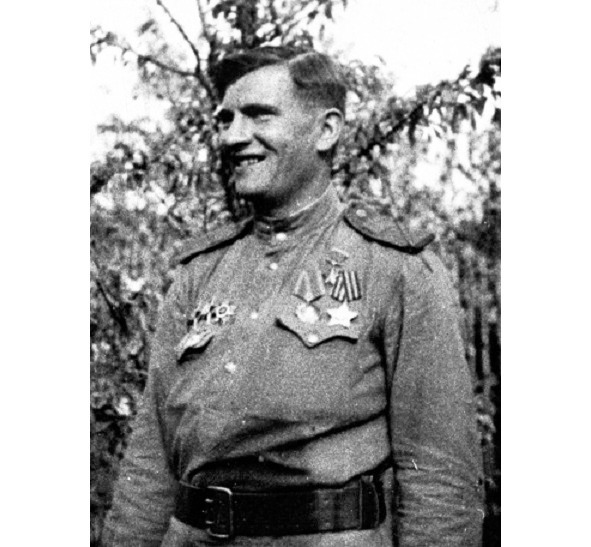
Below the swampy lowland, along which the Baikal Tract now runs, on the banks of the river of the same name, there used to be the village of Karolok (from Turkic language korolok — «snowy»), from which at the end of the last century there were several houses in the allotment «Optimist». It was founded at the beginning of the 18th century as a winter hut of the Znamensky Monastery in Irkutsk. Perhaps the name of a small settlement and the Dukhovnikova Valley on the opposite bank of the Angara River were connected with this.
A little upstream was the village of Poshki, founded in 1807. From the end of the 19th century it had its own school, and since 1938 the village council, the collective farm «Kolos» and the children’s regional sanatorium were located. In addition, in 1936–1952. The first psychiatric hospital for 150 people in the Irkutsk region was located here, which, after the flooding of this territory, was transferred to the village of Sosnovy Bor.
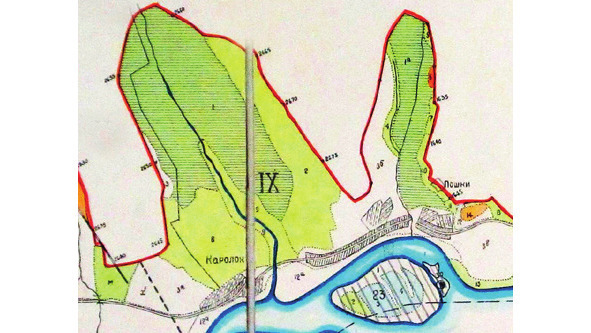
After the source, the Angara outpour most widely precisely here (about 1 km) near the Volchiy Islands. Nowadays, it is twice as wide, and the village has disappeared under water at a depth of 11 m. Now in its place is Burdakovskiy Bay (from the Russian burda — «cattle swill»), where the village of Burdakovka (population 444 people), founded in 1926 by immigrants from the small Ukrainian village of Malyutyanka, which still stands 30 kilometers to south from Kyiv today. On July 4, 2001, on the fields outside the village, during the landing approach, the Tu-154M aircraft fell into a flat tailspin, all 136 passengers and 9 crew members died. In 2005, an obelisk made of black dolerite with the names of the victims was set at the site of the crash; nothing is planted now on two hectares of farmland.
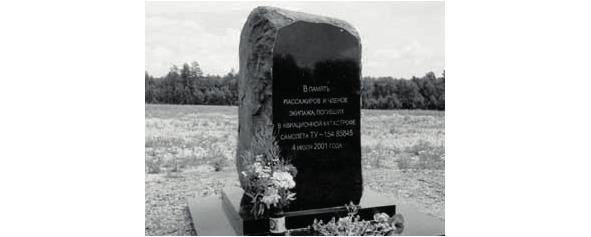
Moving further along the Baikal tract, we reach a large river called Burduguz (from Buryatian language burdu — «swill» and us — «water»). Once, timber was rafted along it from logging areas upstream. Today, the river has become shallow, but a fish breeding plant is still based at its mouth, which is engaged in the restoration of the number of valuable fish species (omul, grayling, peled, pike, etc.) in the Irkutsk reservoir. Previously, on the site of the bay in this part of the Angara River, there was an ancient village of Burduguz, founded in the second half of the 17th century by Irkutsk Cossack Ivan Isakov.
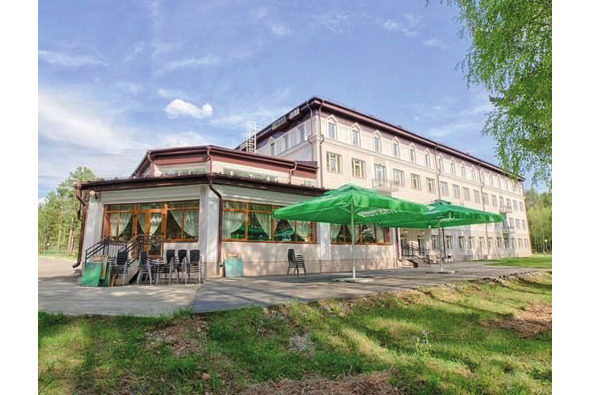
Now the four-star park-hotel «Burduguz» is located on the bank, it operates the best bath club in the Irkutsk region with an area of 400 m2, the stoves of which are built of tsaren times brick, preserved from the old Kurbatov’s baths in Irkutsk. In addition, right on the territory of the complex there is a source of medicinal sulfate-salt mineral water with a mineralization of 3.5 g / l, which is very close in composition to the waters of the former resort of all-Union significance Truskavets on Western Ukraine. Elite accommodation facilities are offered, which have long become a favorite vacation spot for the management of the «Irkutskenergo» and «RUSAL» companies.
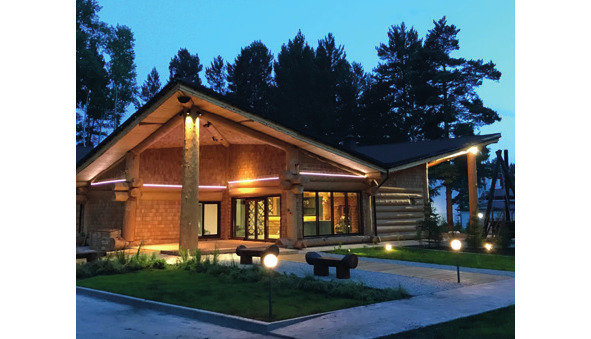
In the past, on the opposite left bank, there was a small settlement called Glubokaya, and a 64 m long Trans-Siberian iron bridge passed through the following river, Piterikha. Today, at that place is the Zmeiny Bay, which houses the «cemetery of ships» and several country houses. Last summer, the wreck of the steam tug 574 «Dmitry Donskoy» (built in 1958) and the bulk-carrier «Klara Zetkin» (1933) were visible.
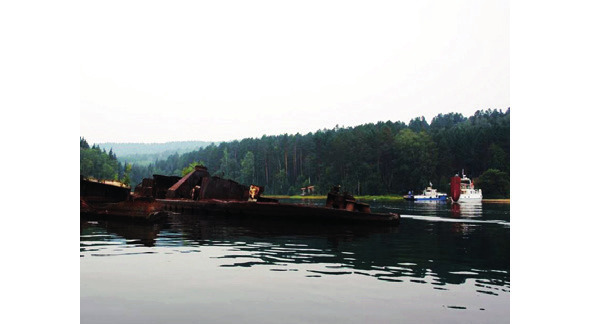
Meanwhile, on the right bank, near the Baikal tract, at the mouth of the Malaya Gryaznukha River, there is a semi-abandoned village of Butyrki (founded no later than 1873 as Molodova, population 17 people). It is one of the few remaining in its original location. After it, on a hill beyond the Bolshaya Gryaznukha River in a cozy pine forest, there is the sanatorium «Elektra» with 120 rooms, built in 1996 by company «Irkutskenergo» specifically for employees of hydroelectric power plants in the Irkutsk region. Absolutely unusual places with healing and tasty air begin from here.
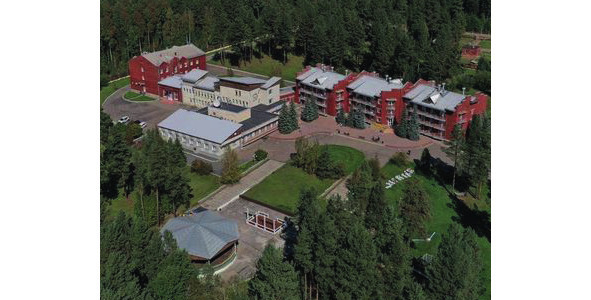
Museum «Taltsy»
Having overcome the Tyrygino river, we enter a spacious valley, where another large river, the Taltsinka, flows into the Angara. In 1784, thanks to the genius of E.G. Laksman, who discovered on Baikal the world’s second lapis lazuli deposit, as well as to his partner and sponsor, the Kargopol merchant A.A. Baranov, known as the «King of Alaska» (the permanent ruler of Russian America in 1790–1818), opened a glass factory here. This production was the first in Russia that mastered the production of glass not with wood soda (potash), but with glauber salt, which was mined in the Tazheran steppes on Baikal, as well as along the banks of the Barguzin and Selenga rivers. Firstly, it helped to save forests, which were mercilessly exterminated for the needs of such manufactories, and secondly, it made it possible to obtain transparent and even colored glass. Simple convicts began to master the new production under the guidance of the Barnaul glass maker Y.I. Makarov.
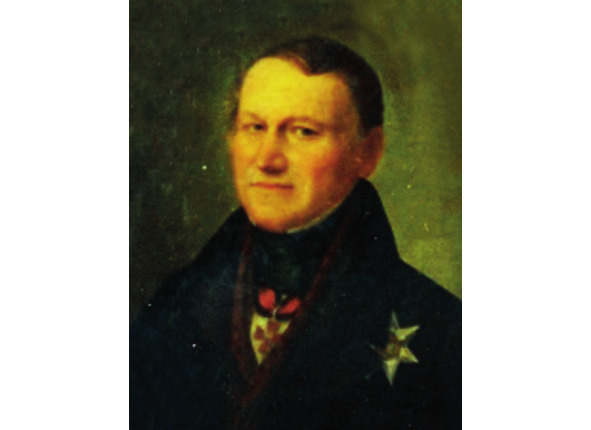
However, due to the fact that the plant’s products were initially in demand only in Eastern Siberia and Transbaikalia, and the Nikolsky sands deposit 25 km from the enterprise was of poor quality and raw materials had to be brought from afar — the plant was very soon sold by the Laksman family due to debts to an Irkutsk merchant Y.P. Soldatov. He owned a factory in 1811–1831 and opened a faience and cloth production here. After his death and until 1868, the enterprise passed into the hands of the joint-stock company of merchants of Irkutsk. In this difficult era for the plant, in 1841, the already familiar to us Decembrist A.N. Sutgof, got here and became the manager of the factory. At the same time, the second lieutenant of the Chernigov Infantry Regiment, Decembrist A.A. Bystritsky got a job as a supervisor of the workshop. He was also among those sentenced to death after the uprising.
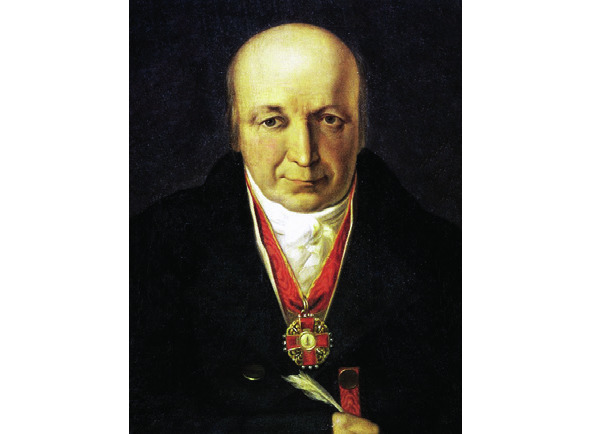
In 1859, a wooden Kazan church was built at the plant in the center of the village of Taltsinskoye, near the bridge along the Baikal tract. It was closed in 1935 and after the alienation of land in 1952, already in a rebuilt form, it was transferred to the village of Bolshaya Rechka, where it burned down.
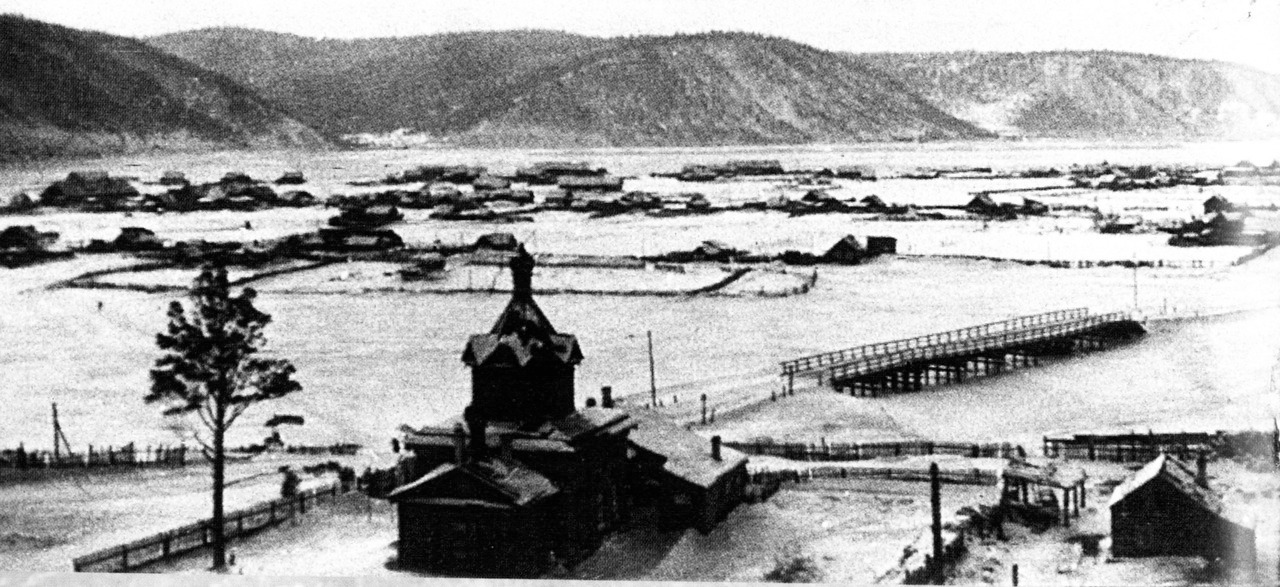
In 1871, the manufactory fell into the caring hands of the Irkutsk merchant of the 1st guild V.P. Katyshevtsev, who made a complete modernization of the factory and began the production of stained glass. Unfortunately, he also failed to achieve great success, and in 1903 the workshops again passed to the merchant board. Eventually, in 1911 the old plant burned down, and the new one was moved to the village on the left bank of the Taltsinka river, closer to the Angara and renamed «Pokrovsky». The products were in no way inferior to English and Dutch glass. Here was the largest settlement between Irkutsk and Baikal with a population of more than 600 people.
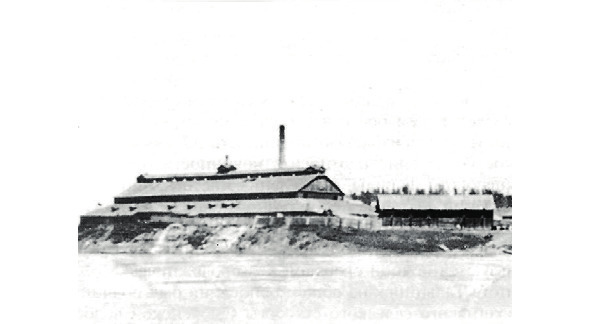
The next birth of the factory took place after forced conservation already in Soviet times in 1929 under the symbolic name of the commercial and cooperative artel «Vozrozhdeniye». However, due to imported raw materials, production still remained unprofitable, and the plant was again closed during the WWII. The final point in the fate of the enterprise was put by the construction of a hydroelectric power station, when in 1956 the factory was burned down, and the workers were relocated from the flood zone to the village of Tulun in the north of the Irkutsk region, where the second largest glass factory in the Soviet Union was soon opened. Today, most of the territory of the village of Taltsinskoye is located at a depth of 9 m in the Angara River.
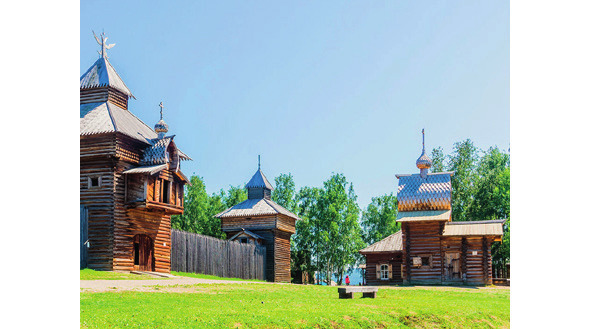
Therefore, it is no coincidence that in 1966 the choice fell on this place in the creating of the open-air museum of wooden architecture, which was called «Taltsy». Since its opening in 1980, it has become not only one of the largest in Russia (area of 73 hectares, 8 historical and cultural zones), but has also given a second life to many of the rarest monuments of antiquity (more than 150), including the world’s only fortress tower with a hanging chapel (built in 1667), the oldest church in Siberia (1679) and a sample of a real smoke hut («izba»). Its funds contain more than 27 thousand items of storage. In 1990–1992, the Soviet-Japanese film «Dreams of Russia» was filmed on its territory. Thanks to its director, honorary citizen of the Irkutsk region V.V. Tikhonov, the museum is actively developing and constantly filling in its collection. In 2015, it became the only one beyond the Urals named among the ten best Russian museums.
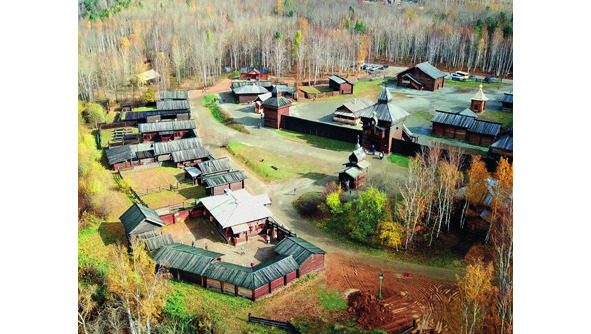
The Taltsinsky plant worked on imported raw materials: sand from Khargino and Tulun; clay from the villages of Bayandai, Badaikha, Polovina and Kontakt. It was first delivered by carts along the Baikal tract, later along the river and subsequently by rail to the Podorvikha station with a 4-way passing loop (57 km from the Innokentievskaya station), located on the opposite bank of the Angara. For delivery across the river, a pontoon ferry of 12 three-sazhen boats was made, arranged in 4 km from the village.
Бесплатный фрагмент закончился.
Купите книгу, чтобы продолжить чтение.
